Analysis of Vinamilk's Plant-Based Milk into International Market
VerifiedAdded on 2024/05/05
|46
|9379
|355
AI Summary
This analysis focuses on Vinamilk's entry into the UK market with its plant-based milk products. It includes market selection models, entry mode strategies, marketing tactics, and distribution strategies to ensure successful market penetration and growth.
Contribute Materials
Your contribution can guide someone’s learning journey. Share your
documents today.

TRƯỜNG ĐẠI HỌC NGOẠI THƯƠNG
CƠ SỞ II TẠI THÀNH PHỐ HỒ CHÍ MINH
---------***--------
MIDTERM ASSIGNMENT
Major: International Marketing
ANALYSIS OF VINAMILK’S PLANT-BASED MILK
INTO INTERNATIONAL MARKET
Lecturer: Nguyễn Thị Thu Thảo
Class code: ML124
Group: 07
Class: K60CLC6
Group members:
Nguyễn Thanh Thảo: 2112153158
Lê Trần Khánh Ngọc: 2112153110
Đào Ngọc Quỳnh Anh: 2112153004
Hà Anh Kiệt: 2112153071
Lê Thị Bảo Trâm: 2113153062
Vũ Thị Thu Hiền: 2012256009
Nguyễn Ngọc Đông Nghi: 2112153105
Ho Chi Minh City, March 2023
CƠ SỞ II TẠI THÀNH PHỐ HỒ CHÍ MINH
---------***--------
MIDTERM ASSIGNMENT
Major: International Marketing
ANALYSIS OF VINAMILK’S PLANT-BASED MILK
INTO INTERNATIONAL MARKET
Lecturer: Nguyễn Thị Thu Thảo
Class code: ML124
Group: 07
Class: K60CLC6
Group members:
Nguyễn Thanh Thảo: 2112153158
Lê Trần Khánh Ngọc: 2112153110
Đào Ngọc Quỳnh Anh: 2112153004
Hà Anh Kiệt: 2112153071
Lê Thị Bảo Trâm: 2113153062
Vũ Thị Thu Hiền: 2012256009
Nguyễn Ngọc Đông Nghi: 2112153105
Ho Chi Minh City, March 2023
Secure Best Marks with AI Grader
Need help grading? Try our AI Grader for instant feedback on your assignments.

Table of contents
LIST OF TABLES ...................................................................................................... 3
LIST OF GRAPHS ..................................................................................................... 4
CHAPTER 1. EXECUTIVE SUMMARY AND GLOBAL OVERVIEW ................ 5
1.1. Executive Summary ......................................................................................... 5
1.2. Global Trend Overview.................................................................................... 5
1.3. Vinamilk ........................................................................................................... 6
1.3.1 Background information ............................................................................ 6
1.3.2. Plant-based milk overview ........................................................................ 7
1.3.3. Business model.......................................................................................... 7
1.3.4 Value chain ................................................................................................. 8
CHAPTER 2. OVERVIEW OF 2 PROMISING COUNTRIES .............................. 10
2.1. Overview of The UK & India ........................................................................ 10
2.1.1. General environment ............................................................................... 10
2.1.2. Political environment .............................................................................. 10
2.1.3. Economic environment ........................................................................... 11
CHAPTER 3. MODELS FOR MARKET SELECTION.......................................... 15
3.1 Market Comparison ......................................................................................... 15
3.2 Preliminary screening ...................................................................................... 15
3.2.1 Why Western Europe & Asian Pacific .................................................... 15
3.2.2 Why United Kingdom & India ................................................................. 16
3.3.3 Business Environment Risk Index (BERI) .............................................. 17
3.3 Fine-grained screening: MACS ...................................................................... 20
3.3.1 Market attractiveness ............................................................................... 20
LIST OF TABLES ...................................................................................................... 3
LIST OF GRAPHS ..................................................................................................... 4
CHAPTER 1. EXECUTIVE SUMMARY AND GLOBAL OVERVIEW ................ 5
1.1. Executive Summary ......................................................................................... 5
1.2. Global Trend Overview.................................................................................... 5
1.3. Vinamilk ........................................................................................................... 6
1.3.1 Background information ............................................................................ 6
1.3.2. Plant-based milk overview ........................................................................ 7
1.3.3. Business model.......................................................................................... 7
1.3.4 Value chain ................................................................................................. 8
CHAPTER 2. OVERVIEW OF 2 PROMISING COUNTRIES .............................. 10
2.1. Overview of The UK & India ........................................................................ 10
2.1.1. General environment ............................................................................... 10
2.1.2. Political environment .............................................................................. 10
2.1.3. Economic environment ........................................................................... 11
CHAPTER 3. MODELS FOR MARKET SELECTION.......................................... 15
3.1 Market Comparison ......................................................................................... 15
3.2 Preliminary screening ...................................................................................... 15
3.2.1 Why Western Europe & Asian Pacific .................................................... 15
3.2.2 Why United Kingdom & India ................................................................. 16
3.3.3 Business Environment Risk Index (BERI) .............................................. 17
3.3 Fine-grained screening: MACS ...................................................................... 20
3.3.1 Market attractiveness ............................................................................... 20
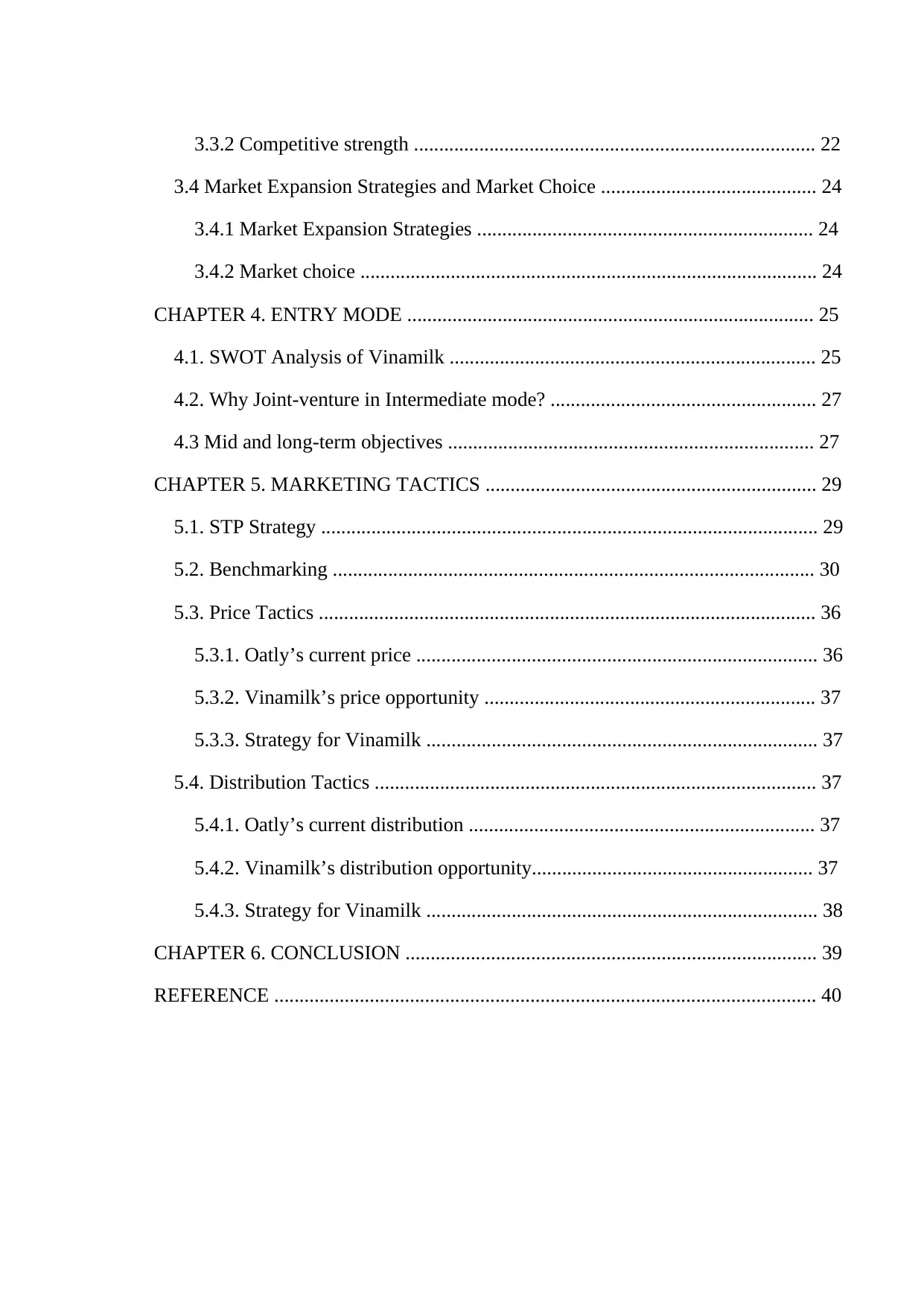
3.3.2 Competitive strength ................................................................................ 22
3.4 Market Expansion Strategies and Market Choice ........................................... 24
3.4.1 Market Expansion Strategies ................................................................... 24
3.4.2 Market choice ........................................................................................... 24
CHAPTER 4. ENTRY MODE ................................................................................. 25
4.1. SWOT Analysis of Vinamilk ......................................................................... 25
4.2. Why Joint-venture in Intermediate mode? ..................................................... 27
4.3 Mid and long-term objectives ......................................................................... 27
CHAPTER 5. MARKETING TACTICS .................................................................. 29
5.1. STP Strategy ................................................................................................... 29
5.2. Benchmarking ................................................................................................ 30
5.3. Price Tactics ................................................................................................... 36
5.3.1. Oatly’s current price ................................................................................ 36
5.3.2. Vinamilk’s price opportunity .................................................................. 37
5.3.3. Strategy for Vinamilk .............................................................................. 37
5.4. Distribution Tactics ........................................................................................ 37
5.4.1. Oatly’s current distribution ..................................................................... 37
5.4.2. Vinamilk’s distribution opportunity........................................................ 37
5.4.3. Strategy for Vinamilk .............................................................................. 38
CHAPTER 6. CONCLUSION .................................................................................. 39
REFERENCE ............................................................................................................ 40
3.4 Market Expansion Strategies and Market Choice ........................................... 24
3.4.1 Market Expansion Strategies ................................................................... 24
3.4.2 Market choice ........................................................................................... 24
CHAPTER 4. ENTRY MODE ................................................................................. 25
4.1. SWOT Analysis of Vinamilk ......................................................................... 25
4.2. Why Joint-venture in Intermediate mode? ..................................................... 27
4.3 Mid and long-term objectives ......................................................................... 27
CHAPTER 5. MARKETING TACTICS .................................................................. 29
5.1. STP Strategy ................................................................................................... 29
5.2. Benchmarking ................................................................................................ 30
5.3. Price Tactics ................................................................................................... 36
5.3.1. Oatly’s current price ................................................................................ 36
5.3.2. Vinamilk’s price opportunity .................................................................. 37
5.3.3. Strategy for Vinamilk .............................................................................. 37
5.4. Distribution Tactics ........................................................................................ 37
5.4.1. Oatly’s current distribution ..................................................................... 37
5.4.2. Vinamilk’s distribution opportunity........................................................ 37
5.4.3. Strategy for Vinamilk .............................................................................. 38
CHAPTER 6. CONCLUSION .................................................................................. 39
REFERENCE ............................................................................................................ 40
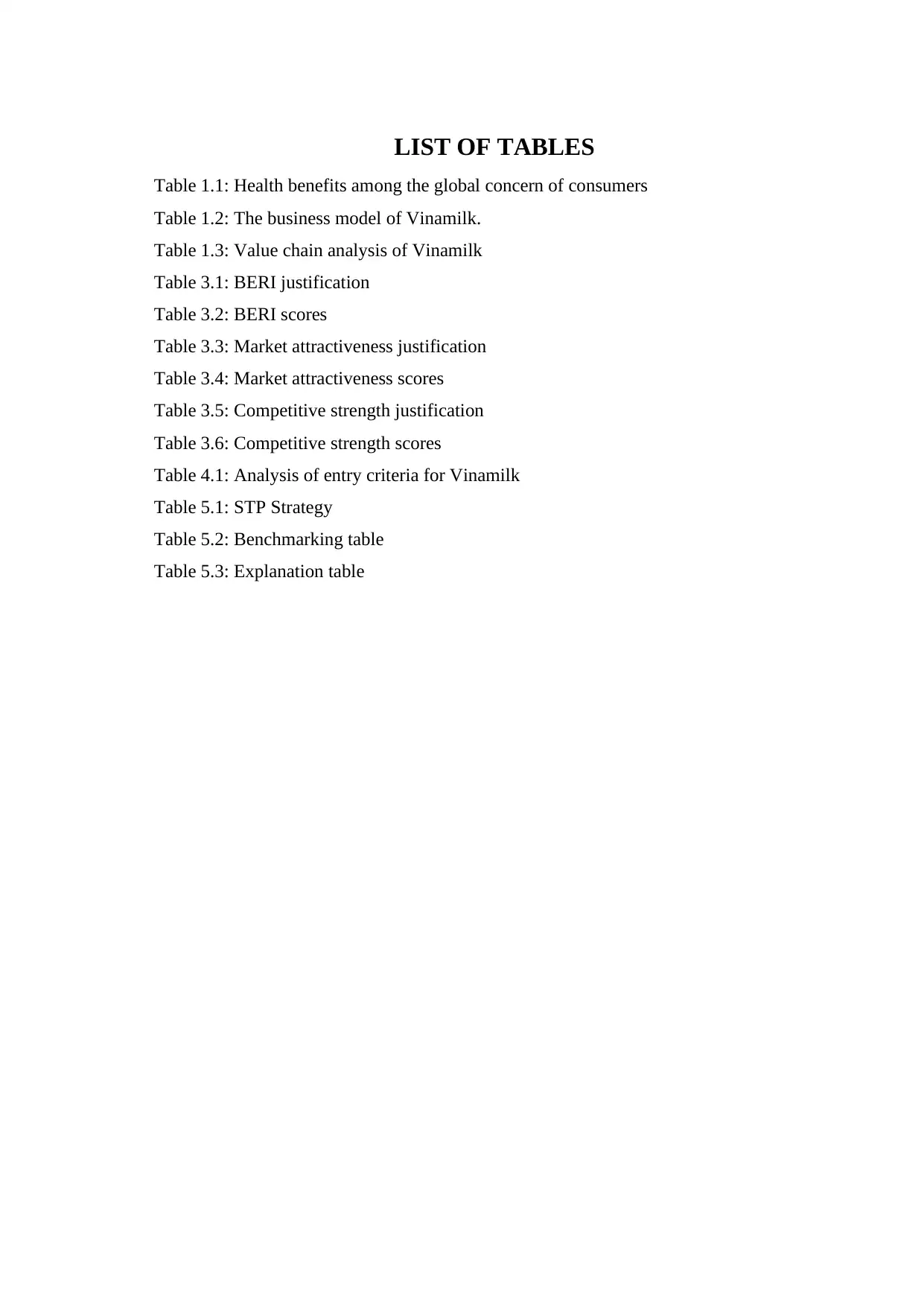
LIST OF TABLES
Table 1.1: Health benefits among the global concern of consumers
Table 1.2: The business model of Vinamilk.
Table 1.3: Value chain analysis of Vinamilk
Table 3.1: BERI justification
Table 3.2: BERI scores
Table 3.3: Market attractiveness justification
Table 3.4: Market attractiveness scores
Table 3.5: Competitive strength justification
Table 3.6: Competitive strength scores
Table 4.1: Analysis of entry criteria for Vinamilk
Table 5.1: STP Strategy
Table 5.2: Benchmarking table
Table 5.3: Explanation table
Table 1.1: Health benefits among the global concern of consumers
Table 1.2: The business model of Vinamilk.
Table 1.3: Value chain analysis of Vinamilk
Table 3.1: BERI justification
Table 3.2: BERI scores
Table 3.3: Market attractiveness justification
Table 3.4: Market attractiveness scores
Table 3.5: Competitive strength justification
Table 3.6: Competitive strength scores
Table 4.1: Analysis of entry criteria for Vinamilk
Table 5.1: STP Strategy
Table 5.2: Benchmarking table
Table 5.3: Explanation table
Secure Best Marks with AI Grader
Need help grading? Try our AI Grader for instant feedback on your assignments.

LIST OF GRAPHS
Figure 2.1: Health benefits among the global concern of consumers
Figure 2.2: Consumer trends regarding sustainability
Figure 3.1: General marketing screening process
Figure 3.2: Import values for grains, oilseeds, and pulses in 2021
Figure 3.3: UK dairy alternatives market estimates and forecasts, 2014-2025 (USD Million),
by Smart Protein
Figure 3.4: Market Attractiveness/Competitive Strength matrix
Figure 2.1: Health benefits among the global concern of consumers
Figure 2.2: Consumer trends regarding sustainability
Figure 3.1: General marketing screening process
Figure 3.2: Import values for grains, oilseeds, and pulses in 2021
Figure 3.3: UK dairy alternatives market estimates and forecasts, 2014-2025 (USD Million),
by Smart Protein
Figure 3.4: Market Attractiveness/Competitive Strength matrix
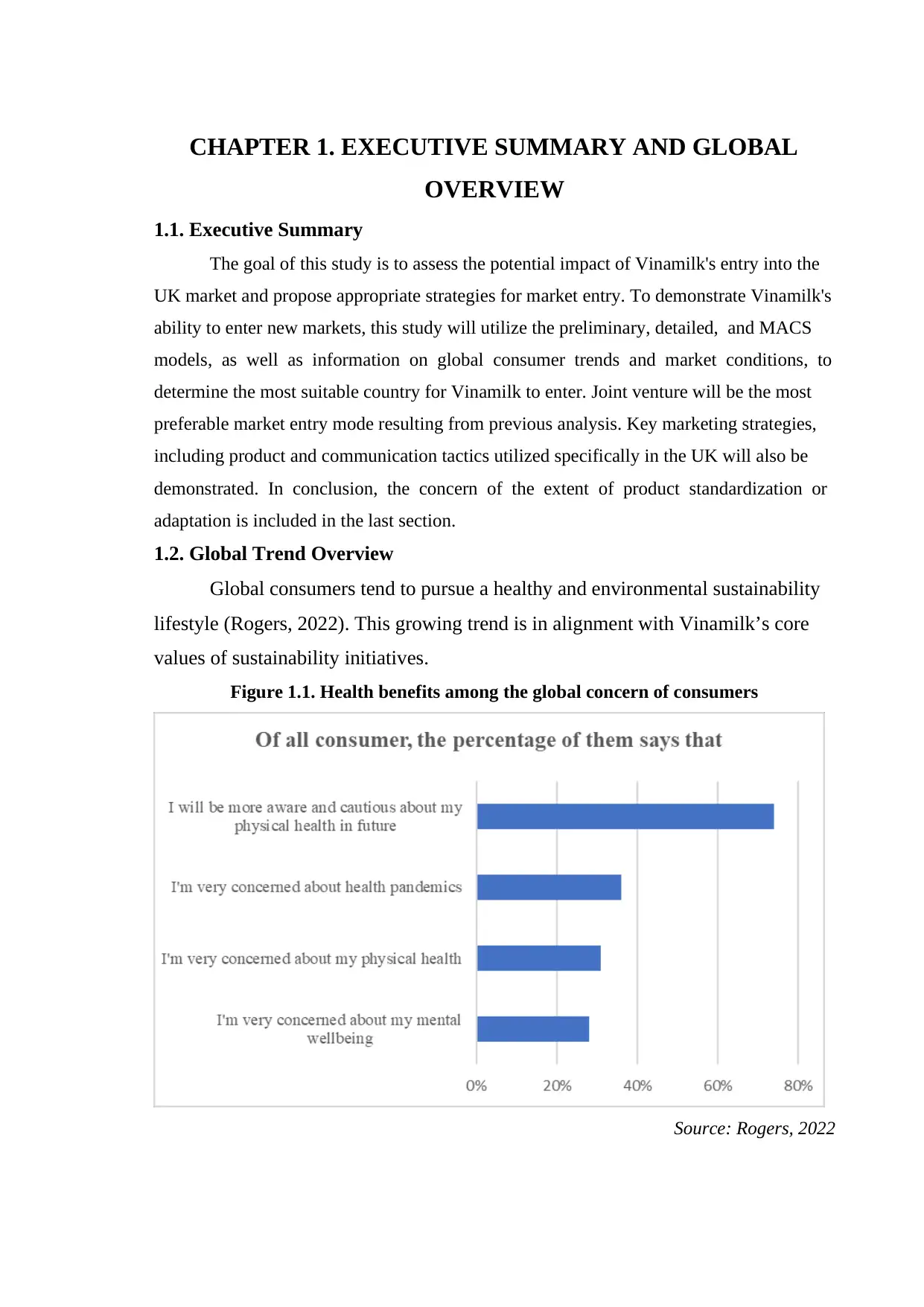
CHAPTER 1. EXECUTIVE SUMMARY AND GLOBAL
OVERVIEW
1.1. Executive Summary
The goal of this study is to assess the potential impact of Vinamilk's entry into the
UK market and propose appropriate strategies for market entry. To demonstrate Vinamilk's
ability to enter new markets, this study will utilize the preliminary, detailed, and MACS
models, as well as information on global consumer trends and market conditions, to
determine the most suitable country for Vinamilk to enter. Joint venture will be the most
preferable market entry mode resulting from previous analysis. Key marketing strategies,
including product and communication tactics utilized specifically in the UK will also be
demonstrated. In conclusion, the concern of the extent of product standardization or
adaptation is included in the last section.
1.2. Global Trend Overview
Global consumers tend to pursue a healthy and environmental sustainability
lifestyle (Rogers, 2022). This growing trend is in alignment with Vinamilk’s core
values of sustainability initiatives.
Figure 1.1. Health benefits among the global concern of consumers
Source: Rogers, 2022
OVERVIEW
1.1. Executive Summary
The goal of this study is to assess the potential impact of Vinamilk's entry into the
UK market and propose appropriate strategies for market entry. To demonstrate Vinamilk's
ability to enter new markets, this study will utilize the preliminary, detailed, and MACS
models, as well as information on global consumer trends and market conditions, to
determine the most suitable country for Vinamilk to enter. Joint venture will be the most
preferable market entry mode resulting from previous analysis. Key marketing strategies,
including product and communication tactics utilized specifically in the UK will also be
demonstrated. In conclusion, the concern of the extent of product standardization or
adaptation is included in the last section.
1.2. Global Trend Overview
Global consumers tend to pursue a healthy and environmental sustainability
lifestyle (Rogers, 2022). This growing trend is in alignment with Vinamilk’s core
values of sustainability initiatives.
Figure 1.1. Health benefits among the global concern of consumers
Source: Rogers, 2022
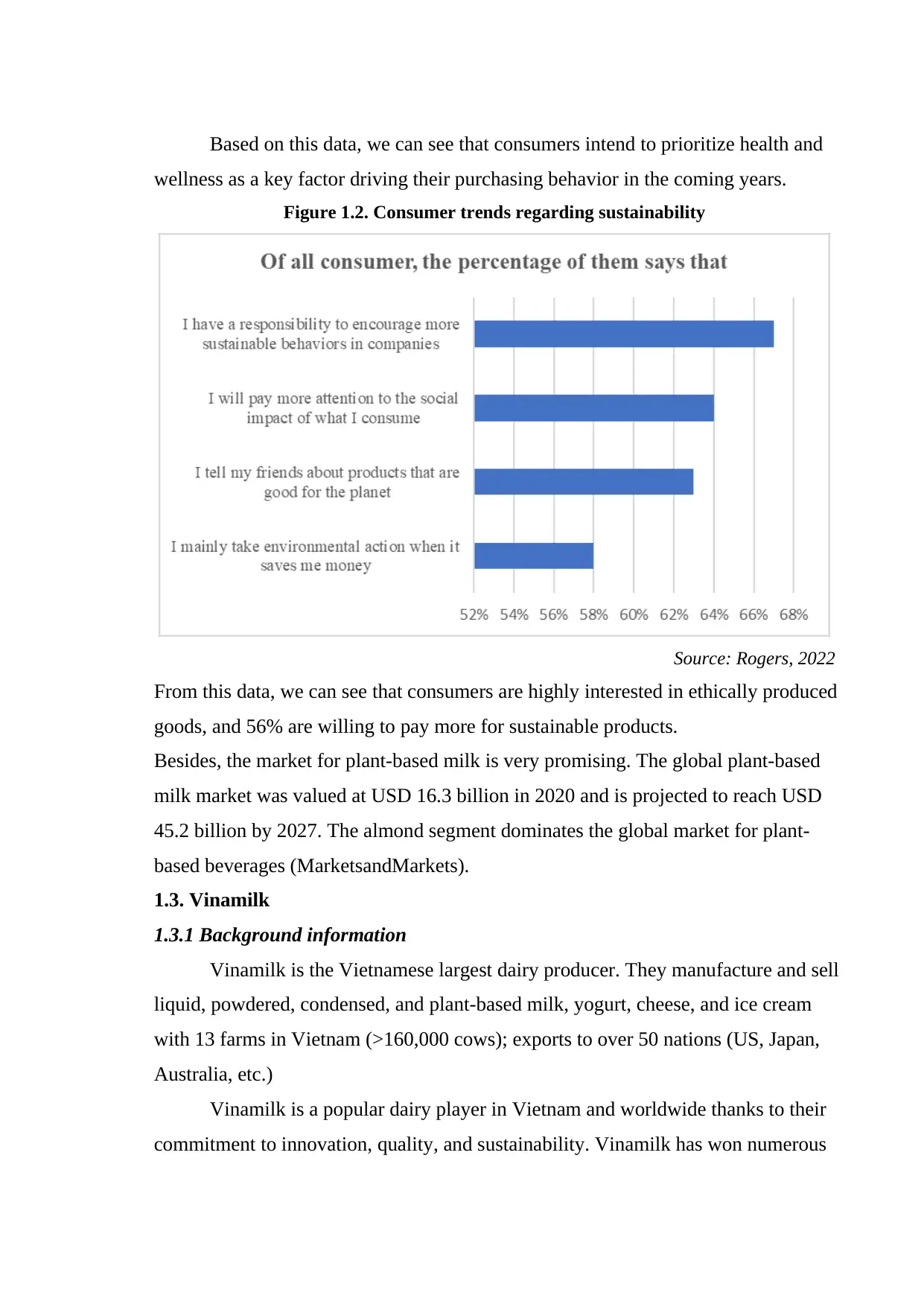
Based on this data, we can see that consumers intend to prioritize health and
wellness as a key factor driving their purchasing behavior in the coming years.
Figure 1.2. Consumer trends regarding sustainability
Source: Rogers, 2022
From this data, we can see that consumers are highly interested in ethically produced
goods, and 56% are willing to pay more for sustainable products.
Besides, the market for plant-based milk is very promising. The global plant-based
milk market was valued at USD 16.3 billion in 2020 and is projected to reach USD
45.2 billion by 2027. The almond segment dominates the global market for plant-
based beverages (MarketsandMarkets).
1.3. Vinamilk
1.3.1 Background information
Vinamilk is the Vietnamese largest dairy producer. They manufacture and sell
liquid, powdered, condensed, and plant-based milk, yogurt, cheese, and ice cream
with 13 farms in Vietnam (>160,000 cows); exports to over 50 nations (US, Japan,
Australia, etc.)
Vinamilk is a popular dairy player in Vietnam and worldwide thanks to their
commitment to innovation, quality, and sustainability. Vinamilk has won numerous
wellness as a key factor driving their purchasing behavior in the coming years.
Figure 1.2. Consumer trends regarding sustainability
Source: Rogers, 2022
From this data, we can see that consumers are highly interested in ethically produced
goods, and 56% are willing to pay more for sustainable products.
Besides, the market for plant-based milk is very promising. The global plant-based
milk market was valued at USD 16.3 billion in 2020 and is projected to reach USD
45.2 billion by 2027. The almond segment dominates the global market for plant-
based beverages (MarketsandMarkets).
1.3. Vinamilk
1.3.1 Background information
Vinamilk is the Vietnamese largest dairy producer. They manufacture and sell
liquid, powdered, condensed, and plant-based milk, yogurt, cheese, and ice cream
with 13 farms in Vietnam (>160,000 cows); exports to over 50 nations (US, Japan,
Australia, etc.)
Vinamilk is a popular dairy player in Vietnam and worldwide thanks to their
commitment to innovation, quality, and sustainability. Vinamilk has won numerous
Paraphrase This Document
Need a fresh take? Get an instant paraphrase of this document with our AI Paraphraser
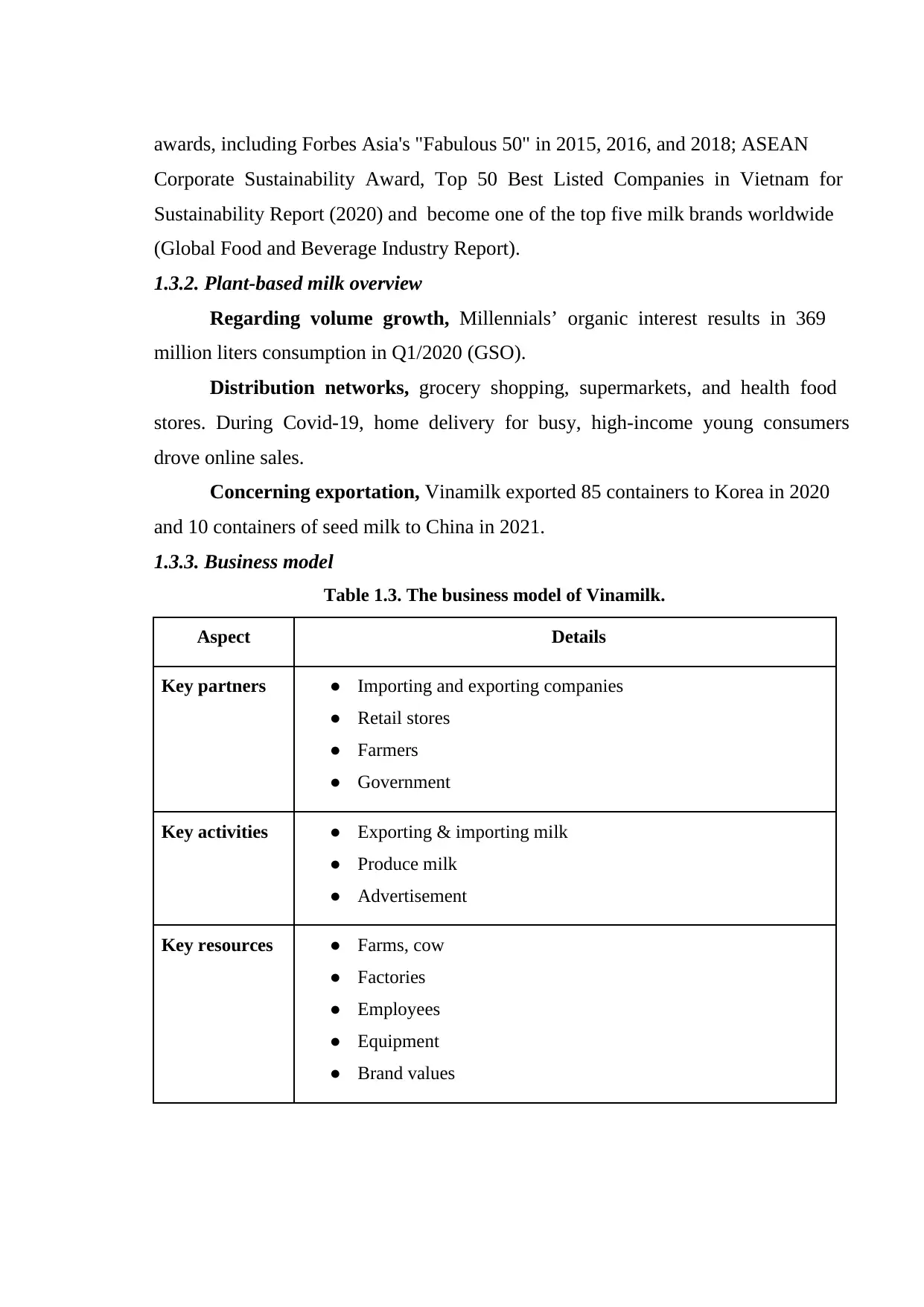
awards, including Forbes Asia's "Fabulous 50" in 2015, 2016, and 2018; ASEAN
Corporate Sustainability Award, Top 50 Best Listed Companies in Vietnam for
Sustainability Report (2020) and become one of the top five milk brands worldwide
(Global Food and Beverage Industry Report).
1.3.2. Plant-based milk overview
Regarding volume growth, Millennials’ organic interest results in 369
million liters consumption in Q1/2020 (GSO).
Distribution networks, grocery shopping, supermarkets, and health food
stores. During Covid-19, home delivery for busy, high-income young consumers
drove online sales.
Concerning exportation, Vinamilk exported 85 containers to Korea in 2020
and 10 containers of seed milk to China in 2021.
1.3.3. Business model
Table 1.3. The business model of Vinamilk.
Aspect Details
Key partners ● Importing and exporting companies
● Retail stores
● Farmers
● Government
Key activities ● Exporting & importing milk
● Produce milk
● Advertisement
Key resources ● Farms, cow
● Factories
● Employees
● Equipment
● Brand values
Corporate Sustainability Award, Top 50 Best Listed Companies in Vietnam for
Sustainability Report (2020) and become one of the top five milk brands worldwide
(Global Food and Beverage Industry Report).
1.3.2. Plant-based milk overview
Regarding volume growth, Millennials’ organic interest results in 369
million liters consumption in Q1/2020 (GSO).
Distribution networks, grocery shopping, supermarkets, and health food
stores. During Covid-19, home delivery for busy, high-income young consumers
drove online sales.
Concerning exportation, Vinamilk exported 85 containers to Korea in 2020
and 10 containers of seed milk to China in 2021.
1.3.3. Business model
Table 1.3. The business model of Vinamilk.
Aspect Details
Key partners ● Importing and exporting companies
● Retail stores
● Farmers
● Government
Key activities ● Exporting & importing milk
● Produce milk
● Advertisement
Key resources ● Farms, cow
● Factories
● Employees
● Equipment
● Brand values

Value
propositions
● Easy and convenient to use
● Milk and dairy products
● Cheap price
● High quality, good for health, increase height
Channels ● Retail stores
● Supermarket
1.3.4 Value chain
Table 1.4. Value chain analysis of Vinamilk
Activity Detail
Supporting
Activities
Infrastructure (Vinamilk, n.d)
• Manufacturing facilities
• Distribution centers
• Other physical assets (trucks, RnD teams,..)
Human Resources (Vinamilk, n.d)
Recruitment, learning & development of employees, development
and implementation of policies and procedures that support a
positive and productive work environment and retain talented
employees.
Technology (Vinamilk, n.d)
• Quality control technology
• Cutting-edge cold storage equipment
• Cutting-edge packaging technologies
Procurement
• Farmers
• Milk collectors
propositions
● Easy and convenient to use
● Milk and dairy products
● Cheap price
● High quality, good for health, increase height
Channels ● Retail stores
● Supermarket
1.3.4 Value chain
Table 1.4. Value chain analysis of Vinamilk
Activity Detail
Supporting
Activities
Infrastructure (Vinamilk, n.d)
• Manufacturing facilities
• Distribution centers
• Other physical assets (trucks, RnD teams,..)
Human Resources (Vinamilk, n.d)
Recruitment, learning & development of employees, development
and implementation of policies and procedures that support a
positive and productive work environment and retain talented
employees.
Technology (Vinamilk, n.d)
• Quality control technology
• Cutting-edge cold storage equipment
• Cutting-edge packaging technologies
Procurement
• Farmers
• Milk collectors
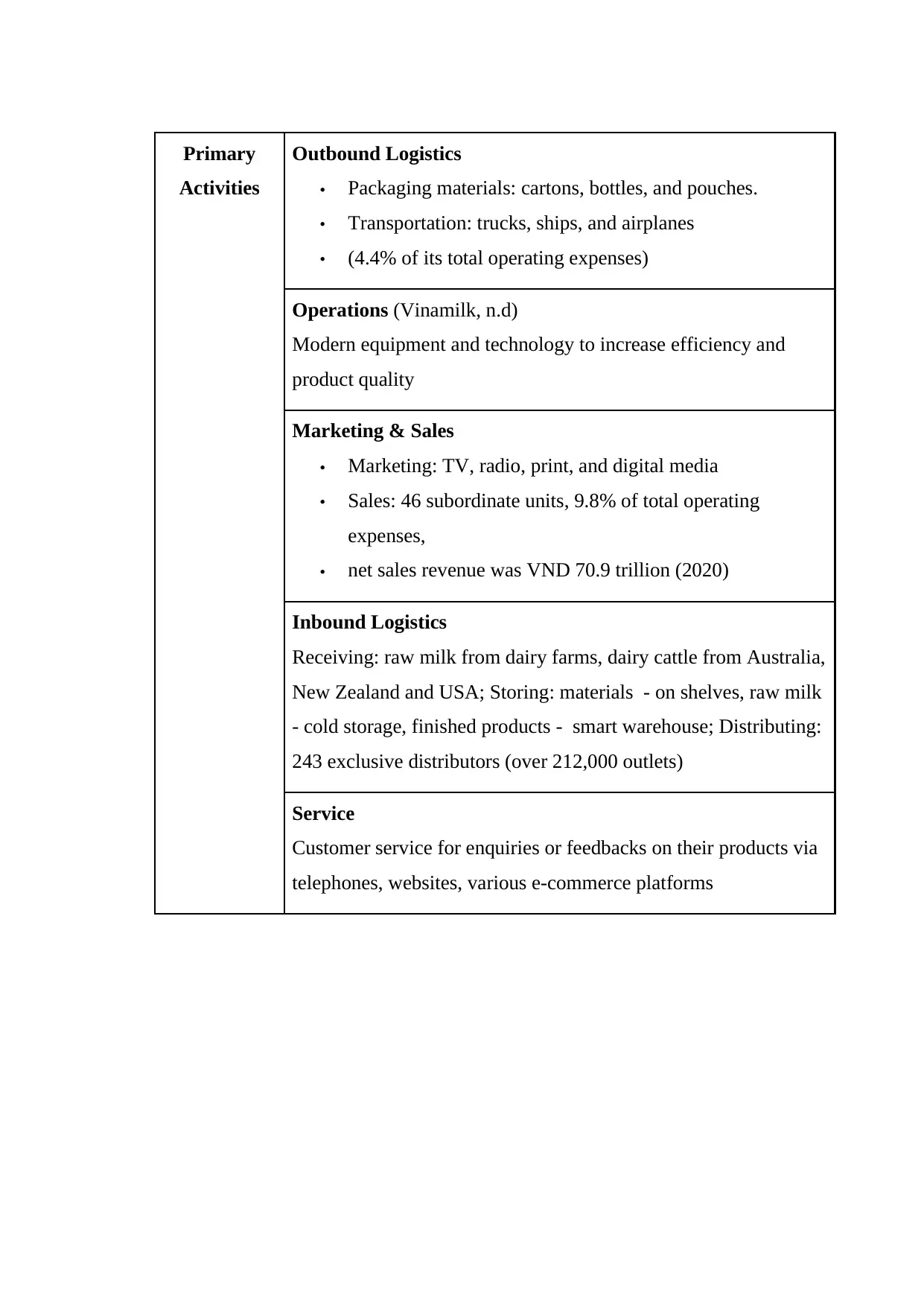
Primary
Activities
Outbound Logistics
• Packaging materials: cartons, bottles, and pouches.
• Transportation: trucks, ships, and airplanes
• (4.4% of its total operating expenses)
Operations (Vinamilk, n.d)
Modern equipment and technology to increase efficiency and
product quality
Marketing & Sales
• Marketing: TV, radio, print, and digital media
• Sales: 46 subordinate units, 9.8% of total operating
expenses,
• net sales revenue was VND 70.9 trillion (2020)
Inbound Logistics
Receiving: raw milk from dairy farms, dairy cattle from Australia,
New Zealand and USA; Storing: materials - on shelves, raw milk
- cold storage, finished products - smart warehouse; Distributing:
243 exclusive distributors (over 212,000 outlets)
Service
Customer service for enquiries or feedbacks on their products via
telephones, websites, various e-commerce platforms
Activities
Outbound Logistics
• Packaging materials: cartons, bottles, and pouches.
• Transportation: trucks, ships, and airplanes
• (4.4% of its total operating expenses)
Operations (Vinamilk, n.d)
Modern equipment and technology to increase efficiency and
product quality
Marketing & Sales
• Marketing: TV, radio, print, and digital media
• Sales: 46 subordinate units, 9.8% of total operating
expenses,
• net sales revenue was VND 70.9 trillion (2020)
Inbound Logistics
Receiving: raw milk from dairy farms, dairy cattle from Australia,
New Zealand and USA; Storing: materials - on shelves, raw milk
- cold storage, finished products - smart warehouse; Distributing:
243 exclusive distributors (over 212,000 outlets)
Service
Customer service for enquiries or feedbacks on their products via
telephones, websites, various e-commerce platforms
Secure Best Marks with AI Grader
Need help grading? Try our AI Grader for instant feedback on your assignments.

CHAPTER 2. OVERVIEW OF 2 PROMISING COUNTRIES
2.1. Overview of The UK & India
2.1.1. General environment
Before, this report will provide overall comparison between UK and India
based on these criteria:
Table 2.1. General comparison between the United Kingdom and India (World Data, n.d.)
Criteria United Kingdom India
Region Northern Europe South Asia
National language English Hindi
Psychic distance about 10,000 km about 5,700 km
Quality of life index (Numbeo, 2023) 117.9 166.4
Main religion Christianity Hinduism
The United Kingdom belongs to Northern Europe, whereas India is in the
same South Asian region as Vietnam, giving the United Kingdom a psychic
distance that is double that of India. However, the predominant religion in India is
Hindu, which appears to be incompatible with Vietnamese religion. Another
advantage for the UK is that its people have a higher standard of living than Indians.
2.1.2. Political environment
Table 2.2. Analysis of the political risks in the UK and India (Marsh, March 2022)
Criteria
UK India
Value from 0 (low) to 10 (high)
Strikes, Riots & Civil Commotion 4.3 6.4
Country Economic Risk 3.1 3.7
Currency Inconvertibility & Transfer Risk 1.5 3.9
2.1. Overview of The UK & India
2.1.1. General environment
Before, this report will provide overall comparison between UK and India
based on these criteria:
Table 2.1. General comparison between the United Kingdom and India (World Data, n.d.)
Criteria United Kingdom India
Region Northern Europe South Asia
National language English Hindi
Psychic distance about 10,000 km about 5,700 km
Quality of life index (Numbeo, 2023) 117.9 166.4
Main religion Christianity Hinduism
The United Kingdom belongs to Northern Europe, whereas India is in the
same South Asian region as Vietnam, giving the United Kingdom a psychic
distance that is double that of India. However, the predominant religion in India is
Hindu, which appears to be incompatible with Vietnamese religion. Another
advantage for the UK is that its people have a higher standard of living than Indians.
2.1.2. Political environment
Table 2.2. Analysis of the political risks in the UK and India (Marsh, March 2022)
Criteria
UK India
Value from 0 (low) to 10 (high)
Strikes, Riots & Civil Commotion 4.3 6.4
Country Economic Risk 3.1 3.7
Currency Inconvertibility & Transfer Risk 1.5 3.9

Sovereign Credit Risk 1.9 3.9
Contractual Agreement Repudiation 3.9 4.9
Legal & Regulatory Risk 2.6 5.3
India has higher political risk points in most aspects. Therefore, political
stability in the UK is higher than in India, especially "Legal & Regulatory Risk",
allowing exporters to reduce concerns about sudden changes in trading policy.
2.1.3. Economic environment
Table 2.3. Economic indicators of the United Kingdom and India (Santander Trade,
2023; Trading Economics, 2023; Heritage, 2023)
Economic Indicators UK India
GDP (2023) 3,479.47 billion USD 3,820.57 billion USD
GDP per capita PPP
(2023) 51,286 USD 2,691 USD
Inflation rate (2023) 10.1 % 6.44 %
Interest rate (2023) 4 % 6.5 %
Unemployment rate
(2023) 3.7 % 7.1 %
Import (2023) 728,766 million GBP 50.66 billion USD
Trade balance (2023) -5,861 million GBP -17.75 billion USD
Economic freedom index
(2023) 69.9 52.9
Contractual Agreement Repudiation 3.9 4.9
Legal & Regulatory Risk 2.6 5.3
India has higher political risk points in most aspects. Therefore, political
stability in the UK is higher than in India, especially "Legal & Regulatory Risk",
allowing exporters to reduce concerns about sudden changes in trading policy.
2.1.3. Economic environment
Table 2.3. Economic indicators of the United Kingdom and India (Santander Trade,
2023; Trading Economics, 2023; Heritage, 2023)
Economic Indicators UK India
GDP (2023) 3,479.47 billion USD 3,820.57 billion USD
GDP per capita PPP
(2023) 51,286 USD 2,691 USD
Inflation rate (2023) 10.1 % 6.44 %
Interest rate (2023) 4 % 6.5 %
Unemployment rate
(2023) 3.7 % 7.1 %
Import (2023) 728,766 million GBP 50.66 billion USD
Trade balance (2023) -5,861 million GBP -17.75 billion USD
Economic freedom index
(2023) 69.9 52.9
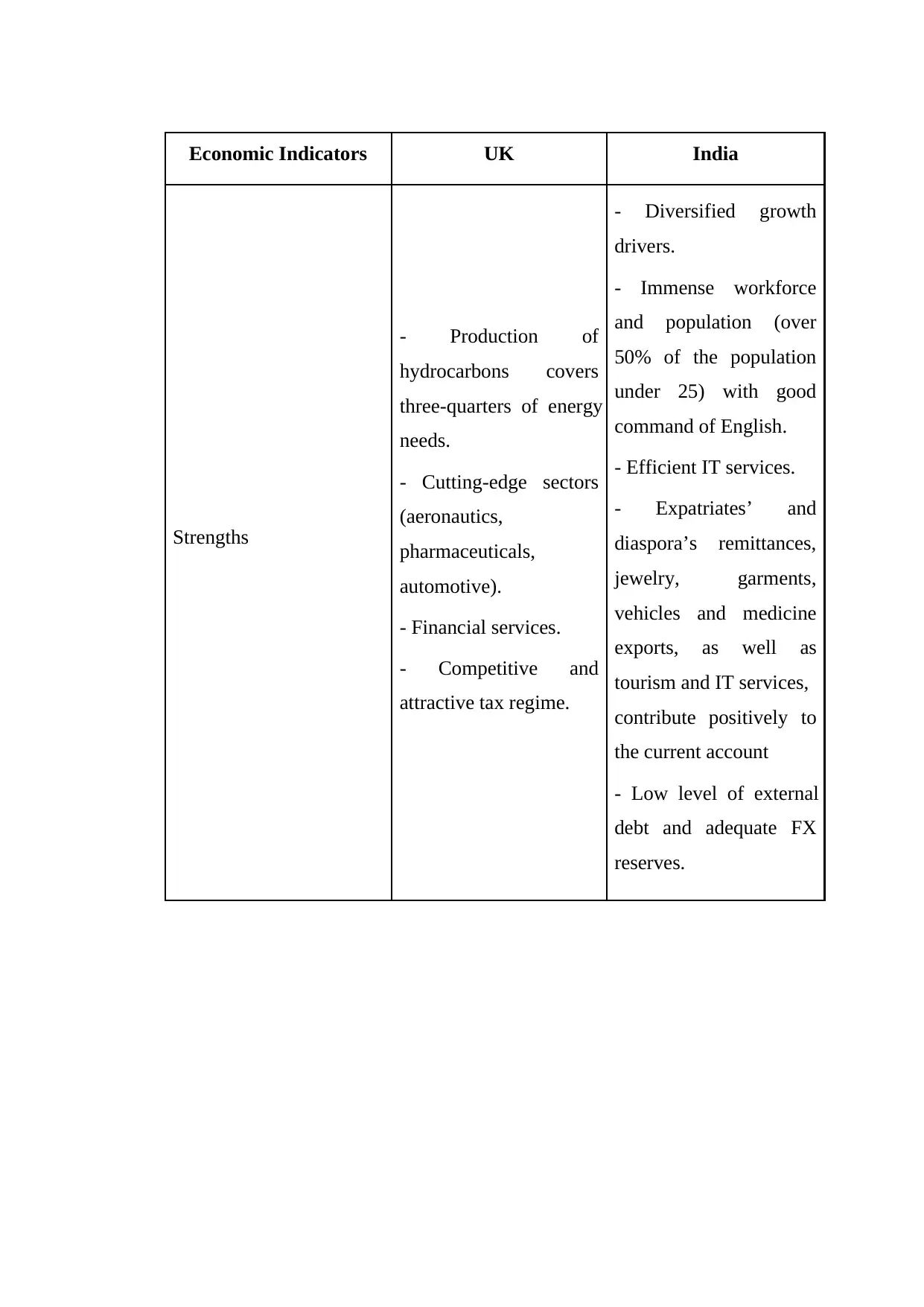
Economic Indicators UK India
Strengths
- Production of
hydrocarbons covers
three-quarters of energy
needs.
- Cutting-edge sectors
(aeronautics,
pharmaceuticals,
automotive).
- Financial services.
- Competitive and
attractive tax regime.
- Diversified growth
drivers.
- Immense workforce
and population (over
50% of the population
under 25) with good
command of English.
- Efficient IT services.
- Expatriates’ and
diaspora’s remittances,
jewelry, garments,
vehicles and medicine
exports, as well as
tourism and IT services,
contribute positively to
the current account
- Low level of external
debt and adequate FX
reserves.
Strengths
- Production of
hydrocarbons covers
three-quarters of energy
needs.
- Cutting-edge sectors
(aeronautics,
pharmaceuticals,
automotive).
- Financial services.
- Competitive and
attractive tax regime.
- Diversified growth
drivers.
- Immense workforce
and population (over
50% of the population
under 25) with good
command of English.
- Efficient IT services.
- Expatriates’ and
diaspora’s remittances,
jewelry, garments,
vehicles and medicine
exports, as well as
tourism and IT services,
contribute positively to
the current account
- Low level of external
debt and adequate FX
reserves.
Paraphrase This Document
Need a fresh take? Get an instant paraphrase of this document with our AI Paraphraser

Economic Indicators UK India
Weaknesses
- High public and
household debt (115%
of gross disposable
income)
- Low productivity and
training deficit not
conducive to innovation
- Regional disparities
between the Southeast
(especially London) and
the rest of the country,
particularly in terms of
transport and energy
infrastructure
- High corporate debt and
non-performing loans
(NPL)
- Net importer of energy
resources (one fifth of
imports)
- Lack of adequate
infrastructure
- Weak public finances
- Bureaucratic red tape,
inefficient justice
- Widespread poverty,
inequality, and
informality
- Military confrontation
in Kashmir with China
and Pakistan
- Non-participation in
regional trade
agreements (Regional
Comprehensive
Economic Partnership
Agreement)
* Value from 0 (low) to 10 (high)
The GDP, Import Rate, Economic Freedom Index, Interest Rate, and
Unemployment Rate are all higher in Britain. This demonstrates that the United
Weaknesses
- High public and
household debt (115%
of gross disposable
income)
- Low productivity and
training deficit not
conducive to innovation
- Regional disparities
between the Southeast
(especially London) and
the rest of the country,
particularly in terms of
transport and energy
infrastructure
- High corporate debt and
non-performing loans
(NPL)
- Net importer of energy
resources (one fifth of
imports)
- Lack of adequate
infrastructure
- Weak public finances
- Bureaucratic red tape,
inefficient justice
- Widespread poverty,
inequality, and
informality
- Military confrontation
in Kashmir with China
and Pakistan
- Non-participation in
regional trade
agreements (Regional
Comprehensive
Economic Partnership
Agreement)
* Value from 0 (low) to 10 (high)
The GDP, Import Rate, Economic Freedom Index, Interest Rate, and
Unemployment Rate are all higher in Britain. This demonstrates that the United
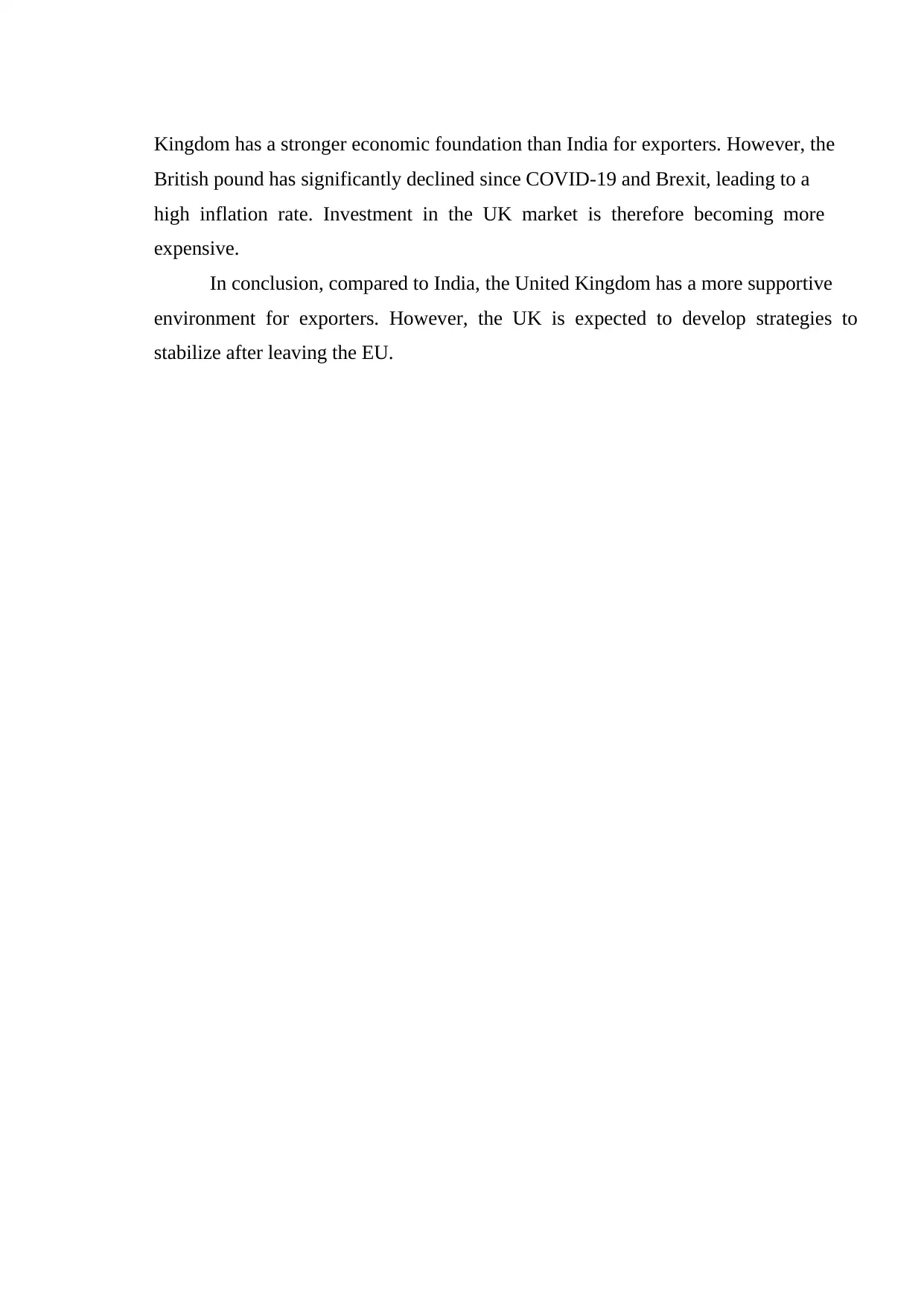
Kingdom has a stronger economic foundation than India for exporters. However, the
British pound has significantly declined since COVID-19 and Brexit, leading to a
high inflation rate. Investment in the UK market is therefore becoming more
expensive.
In conclusion, compared to India, the United Kingdom has a more supportive
environment for exporters. However, the UK is expected to develop strategies to
stabilize after leaving the EU.
British pound has significantly declined since COVID-19 and Brexit, leading to a
high inflation rate. Investment in the UK market is therefore becoming more
expensive.
In conclusion, compared to India, the United Kingdom has a more supportive
environment for exporters. However, the UK is expected to develop strategies to
stabilize after leaving the EU.
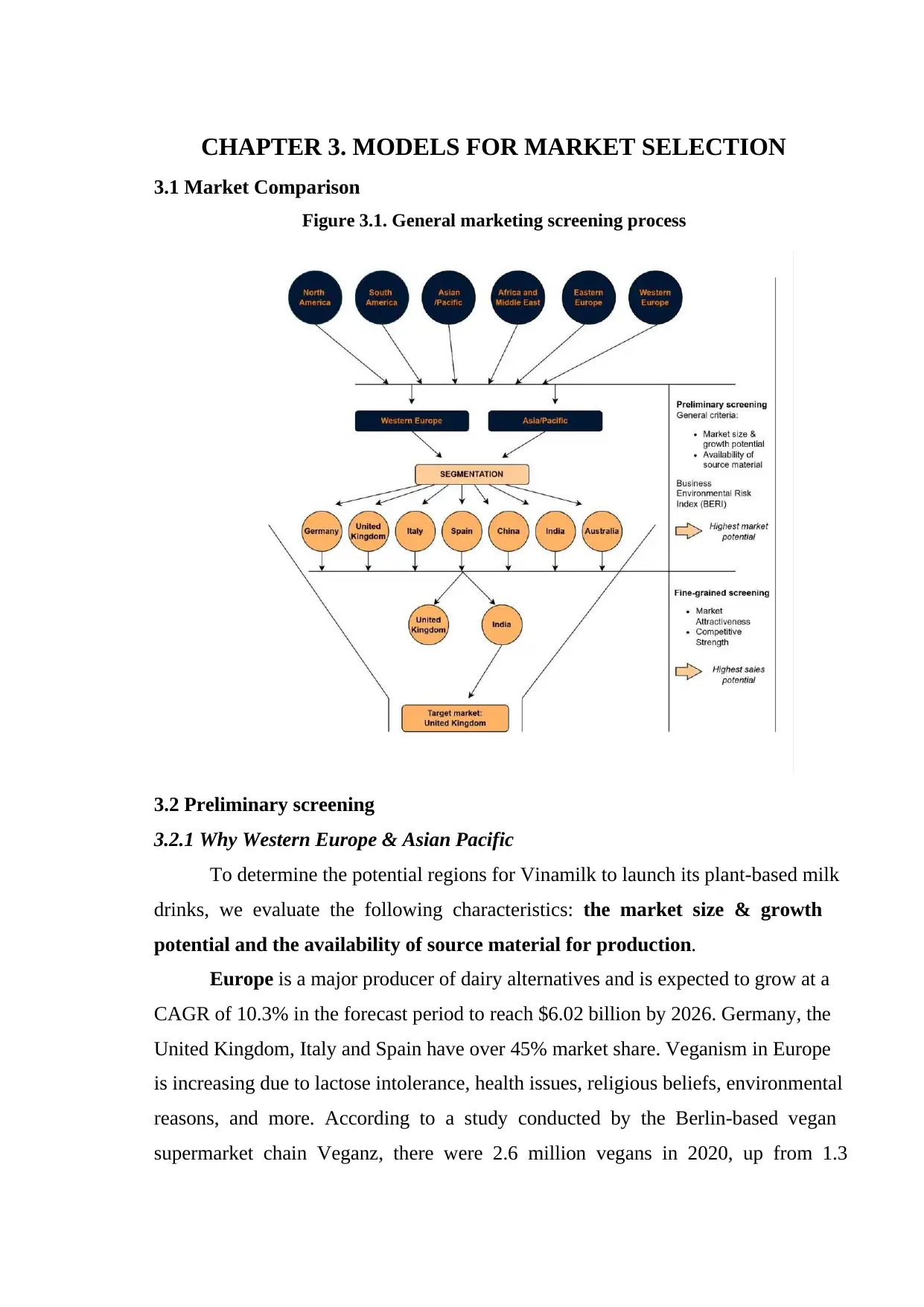
CHAPTER 3. MODELS FOR MARKET SELECTION
3.1 Market Comparison
Figure 3.1. General marketing screening process
3.2 Preliminary screening
3.2.1 Why Western Europe & Asian Pacific
To determine the potential regions for Vinamilk to launch its plant-based milk
drinks, we evaluate the following characteristics: the market size & growth
potential and the availability of source material for production.
Europe is a major producer of dairy alternatives and is expected to grow at a
CAGR of 10.3% in the forecast period to reach $6.02 billion by 2026. Germany, the
United Kingdom, Italy and Spain have over 45% market share. Veganism in Europe
is increasing due to lactose intolerance, health issues, religious beliefs, environmental
reasons, and more. According to a study conducted by the Berlin-based vegan
supermarket chain Veganz, there were 2.6 million vegans in 2020, up from 1.3
3.1 Market Comparison
Figure 3.1. General marketing screening process
3.2 Preliminary screening
3.2.1 Why Western Europe & Asian Pacific
To determine the potential regions for Vinamilk to launch its plant-based milk
drinks, we evaluate the following characteristics: the market size & growth
potential and the availability of source material for production.
Europe is a major producer of dairy alternatives and is expected to grow at a
CAGR of 10.3% in the forecast period to reach $6.02 billion by 2026. Germany, the
United Kingdom, Italy and Spain have over 45% market share. Veganism in Europe
is increasing due to lactose intolerance, health issues, religious beliefs, environmental
reasons, and more. According to a study conducted by the Berlin-based vegan
supermarket chain Veganz, there were 2.6 million vegans in 2020, up from 1.3
Secure Best Marks with AI Grader
Need help grading? Try our AI Grader for instant feedback on your assignments.
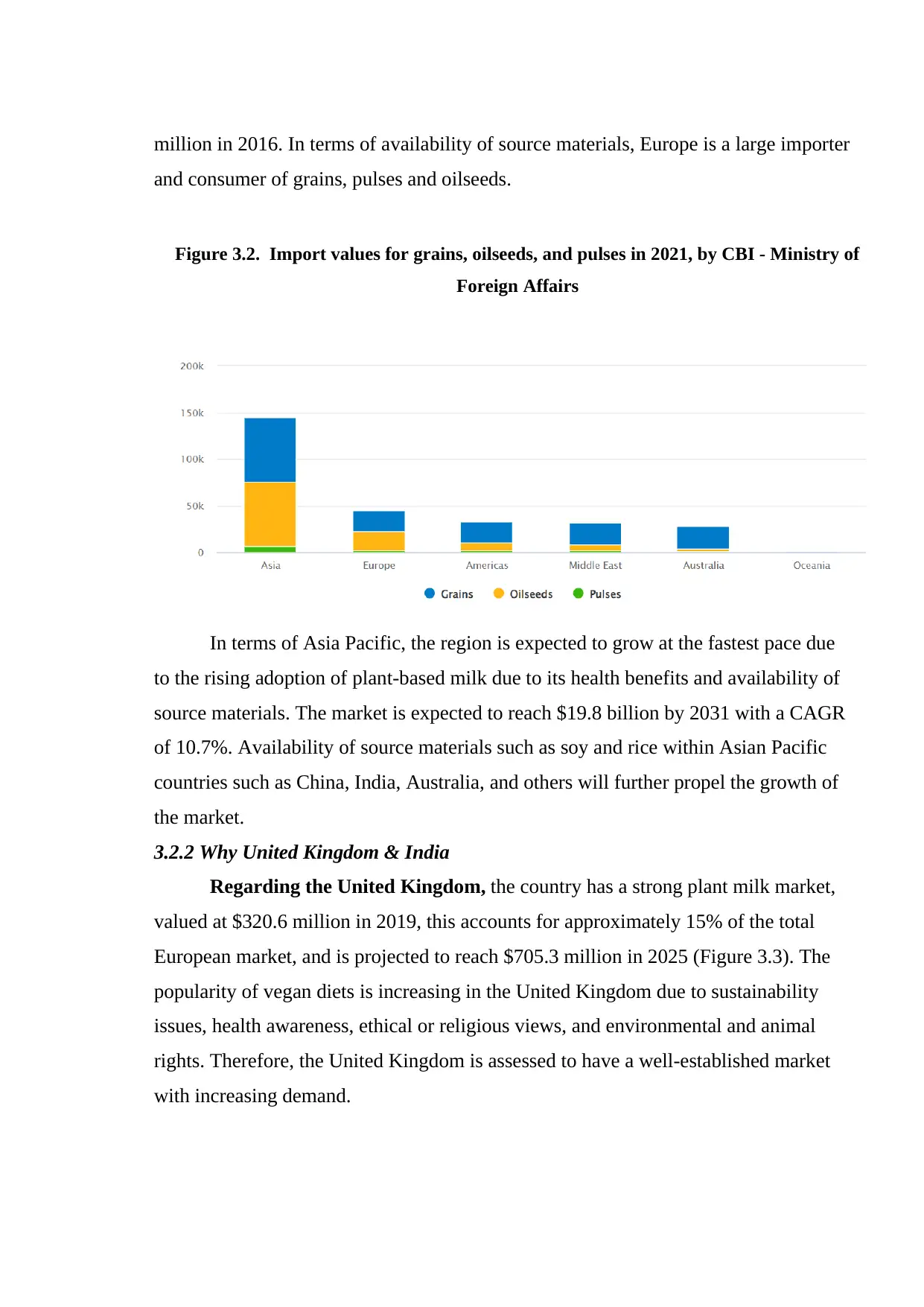
million in 2016. In terms of availability of source materials, Europe is a large importer
and consumer of grains, pulses and oilseeds.
Figure 3.2. Import values for grains, oilseeds, and pulses in 2021, by CBI - Ministry of
Foreign Affairs
In terms of Asia Pacific, the region is expected to grow at the fastest pace due
to the rising adoption of plant-based milk due to its health benefits and availability of
source materials. The market is expected to reach $19.8 billion by 2031 with a CAGR
of 10.7%. Availability of source materials such as soy and rice within Asian Pacific
countries such as China, India, Australia, and others will further propel the growth of
the market.
3.2.2 Why United Kingdom & India
Regarding the United Kingdom, the country has a strong plant milk market,
valued at $320.6 million in 2019, this accounts for approximately 15% of the total
European market, and is projected to reach $705.3 million in 2025 (Figure 3.3). The
popularity of vegan diets is increasing in the United Kingdom due to sustainability
issues, health awareness, ethical or religious views, and environmental and animal
rights. Therefore, the United Kingdom is assessed to have a well-established market
with increasing demand.
and consumer of grains, pulses and oilseeds.
Figure 3.2. Import values for grains, oilseeds, and pulses in 2021, by CBI - Ministry of
Foreign Affairs
In terms of Asia Pacific, the region is expected to grow at the fastest pace due
to the rising adoption of plant-based milk due to its health benefits and availability of
source materials. The market is expected to reach $19.8 billion by 2031 with a CAGR
of 10.7%. Availability of source materials such as soy and rice within Asian Pacific
countries such as China, India, Australia, and others will further propel the growth of
the market.
3.2.2 Why United Kingdom & India
Regarding the United Kingdom, the country has a strong plant milk market,
valued at $320.6 million in 2019, this accounts for approximately 15% of the total
European market, and is projected to reach $705.3 million in 2025 (Figure 3.3). The
popularity of vegan diets is increasing in the United Kingdom due to sustainability
issues, health awareness, ethical or religious views, and environmental and animal
rights. Therefore, the United Kingdom is assessed to have a well-established market
with increasing demand.
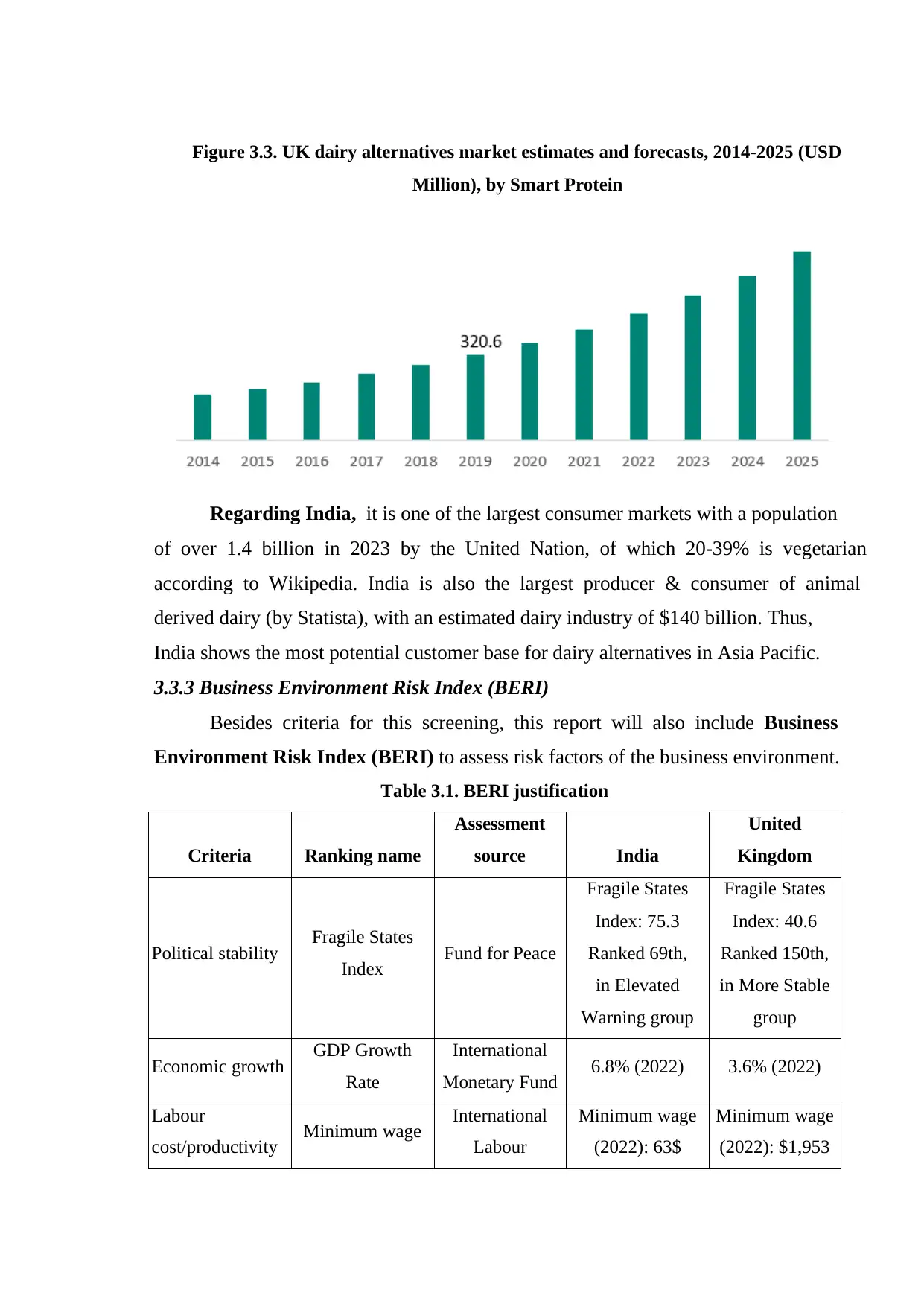
Figure 3.3. UK dairy alternatives market estimates and forecasts, 2014-2025 (USD
Million), by Smart Protein
Regarding India, it is one of the largest consumer markets with a population
of over 1.4 billion in 2023 by the United Nation, of which 20-39% is vegetarian
according to Wikipedia. India is also the largest producer & consumer of animal
derived dairy (by Statista), with an estimated dairy industry of $140 billion. Thus,
India shows the most potential customer base for dairy alternatives in Asia Pacific.
3.3.3 Business Environment Risk Index (BERI)
Besides criteria for this screening, this report will also include Business
Environment Risk Index (BERI) to assess risk factors of the business environment.
Table 3.1. BERI justification
Criteria Ranking name
Assessment
source India
United
Kingdom
Political stability Fragile States
Index Fund for Peace
Fragile States
Index: 75.3
Ranked 69th,
in Elevated
Warning group
Fragile States
Index: 40.6
Ranked 150th,
in More Stable
group
Economic growth GDP Growth
Rate
International
Monetary Fund 6.8% (2022) 3.6% (2022)
Labour
cost/productivity Minimum wage International
Labour
Minimum wage
(2022): 63$
Minimum wage
(2022): $1,953
Million), by Smart Protein
Regarding India, it is one of the largest consumer markets with a population
of over 1.4 billion in 2023 by the United Nation, of which 20-39% is vegetarian
according to Wikipedia. India is also the largest producer & consumer of animal
derived dairy (by Statista), with an estimated dairy industry of $140 billion. Thus,
India shows the most potential customer base for dairy alternatives in Asia Pacific.
3.3.3 Business Environment Risk Index (BERI)
Besides criteria for this screening, this report will also include Business
Environment Risk Index (BERI) to assess risk factors of the business environment.
Table 3.1. BERI justification
Criteria Ranking name
Assessment
source India
United
Kingdom
Political stability Fragile States
Index Fund for Peace
Fragile States
Index: 75.3
Ranked 69th,
in Elevated
Warning group
Fragile States
Index: 40.6
Ranked 150th,
in More Stable
group
Economic growth GDP Growth
Rate
International
Monetary Fund 6.8% (2022) 3.6% (2022)
Labour
cost/productivity Minimum wage International
Labour
Minimum wage
(2022): 63$
Minimum wage
(2022): $1,953
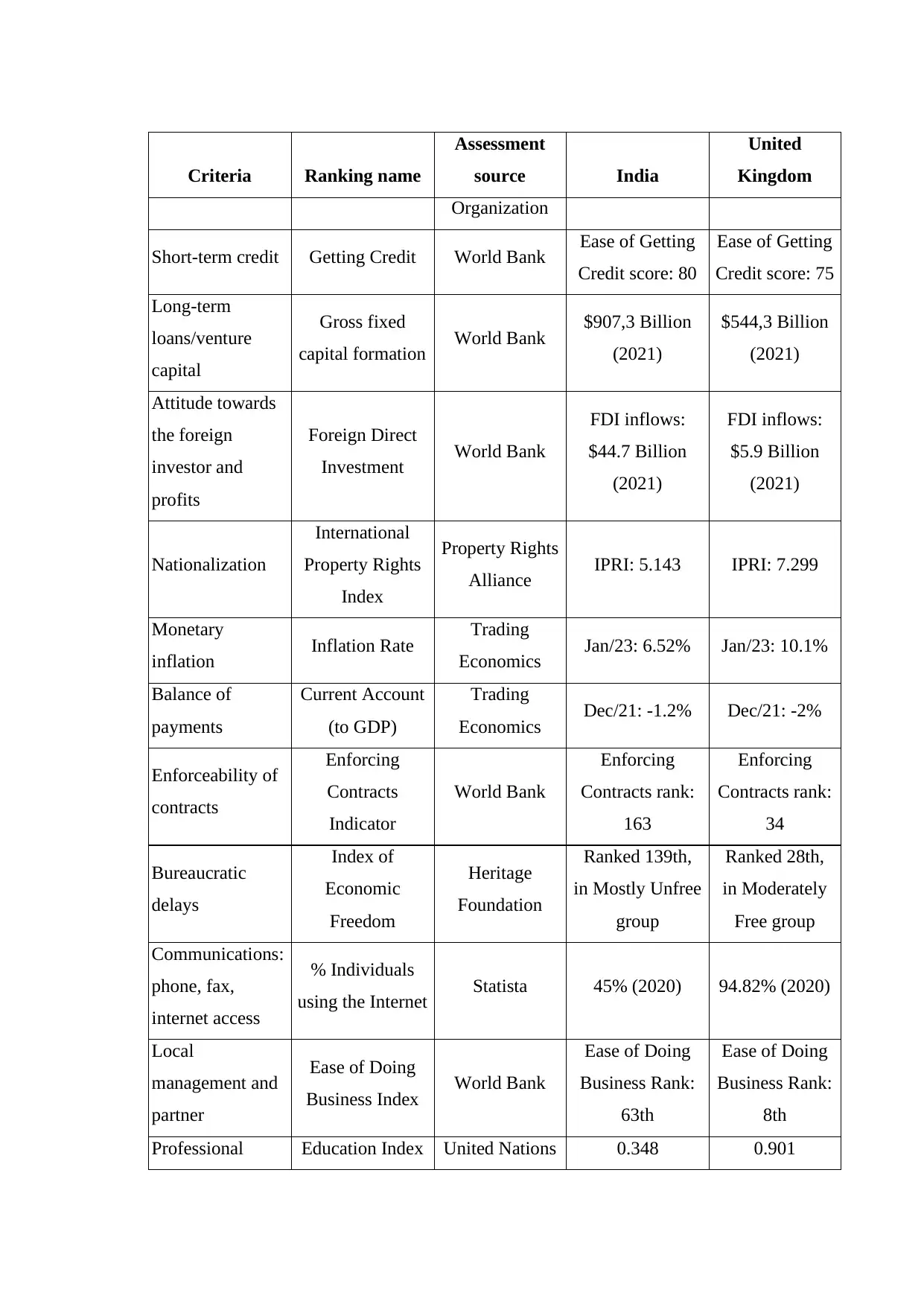
Criteria Ranking name
Assessment
source India
United
Kingdom
Organization
Short-term credit Getting Credit World Bank Ease of Getting
Credit score: 80
Ease of Getting
Credit score: 75
Long-term
loans/venture
capital
Gross fixed
capital formation World Bank $907,3 Billion
(2021)
$544,3 Billion
(2021)
Attitude towards
the foreign
investor and
profits
Foreign Direct
Investment World Bank
FDI inflows:
$44.7 Billion
(2021)
FDI inflows:
$5.9 Billion
(2021)
Nationalization
International
Property Rights
Index
Property Rights
Alliance IPRI: 5.143 IPRI: 7.299
Monetary
inflation Inflation Rate Trading
Economics Jan/23: 6.52% Jan/23: 10.1%
Balance of
payments
Current Account
(to GDP)
Trading
Economics Dec/21: -1.2% Dec/21: -2%
Enforceability of
contracts
Enforcing
Contracts
Indicator
World Bank
Enforcing
Contracts rank:
163
Enforcing
Contracts rank:
34
Bureaucratic
delays
Index of
Economic
Freedom
Heritage
Foundation
Ranked 139th,
in Mostly Unfree
group
Ranked 28th,
in Moderately
Free group
Communications:
phone, fax,
internet access
% Individuals
using the Internet Statista 45% (2020) 94.82% (2020)
Local
management and
partner
Ease of Doing
Business Index World Bank
Ease of Doing
Business Rank:
63th
Ease of Doing
Business Rank:
8th
Professional Education Index United Nations 0.348 0.901
Assessment
source India
United
Kingdom
Organization
Short-term credit Getting Credit World Bank Ease of Getting
Credit score: 80
Ease of Getting
Credit score: 75
Long-term
loans/venture
capital
Gross fixed
capital formation World Bank $907,3 Billion
(2021)
$544,3 Billion
(2021)
Attitude towards
the foreign
investor and
profits
Foreign Direct
Investment World Bank
FDI inflows:
$44.7 Billion
(2021)
FDI inflows:
$5.9 Billion
(2021)
Nationalization
International
Property Rights
Index
Property Rights
Alliance IPRI: 5.143 IPRI: 7.299
Monetary
inflation Inflation Rate Trading
Economics Jan/23: 6.52% Jan/23: 10.1%
Balance of
payments
Current Account
(to GDP)
Trading
Economics Dec/21: -1.2% Dec/21: -2%
Enforceability of
contracts
Enforcing
Contracts
Indicator
World Bank
Enforcing
Contracts rank:
163
Enforcing
Contracts rank:
34
Bureaucratic
delays
Index of
Economic
Freedom
Heritage
Foundation
Ranked 139th,
in Mostly Unfree
group
Ranked 28th,
in Moderately
Free group
Communications:
phone, fax,
internet access
% Individuals
using the Internet Statista 45% (2020) 94.82% (2020)
Local
management and
partner
Ease of Doing
Business Index World Bank
Ease of Doing
Business Rank:
63th
Ease of Doing
Business Rank:
8th
Professional Education Index United Nations 0.348 0.901
Paraphrase This Document
Need a fresh take? Get an instant paraphrase of this document with our AI Paraphraser

Criteria Ranking name
Assessment
source India
United
Kingdom
services and
contractors
Development
Program
Currency
convertibility
Most traded
currencies by
value
Triennial
Central Bank
Survey
Apr/22: 1.6% Apr/22: 12.9%
Based on the justification, the BERI index of the two countries is measured as in
Table 3.2.
Table 3.2. BERI scores
Criteria Weights
India United Kingdom
Score (0-4)
Overall
Index Score (0-4)
Overall
Index
Political stability 3 2 6 4 12
Economic growth 2.5 3 7.5 2 5
Labour
cost/productivity 2 4 8 1 2
Short-term credit 2 3 6 2 4
Long-term
loans/venture capital 2 4 8 3 6
Attitude towards the
foreign investor and
profits
1.5 4 6 2 3
Nationalization 1.5 3 4.5 2 3
Monetary inflation 1.5 3 4.5 2 3
Balance of payments 1.5 2 3 1 1.5
Enforceability of
contracts 1.5 1 1.5 4 6
Bureaucratic delays 1 1 1 4 4
Communications:
phone, fax, internet 1 1 1 4 4
Assessment
source India
United
Kingdom
services and
contractors
Development
Program
Currency
convertibility
Most traded
currencies by
value
Triennial
Central Bank
Survey
Apr/22: 1.6% Apr/22: 12.9%
Based on the justification, the BERI index of the two countries is measured as in
Table 3.2.
Table 3.2. BERI scores
Criteria Weights
India United Kingdom
Score (0-4)
Overall
Index Score (0-4)
Overall
Index
Political stability 3 2 6 4 12
Economic growth 2.5 3 7.5 2 5
Labour
cost/productivity 2 4 8 1 2
Short-term credit 2 3 6 2 4
Long-term
loans/venture capital 2 4 8 3 6
Attitude towards the
foreign investor and
profits
1.5 4 6 2 3
Nationalization 1.5 3 4.5 2 3
Monetary inflation 1.5 3 4.5 2 3
Balance of payments 1.5 2 3 1 1.5
Enforceability of
contracts 1.5 1 1.5 4 6
Bureaucratic delays 1 1 1 4 4
Communications:
phone, fax, internet 1 1 1 4 4
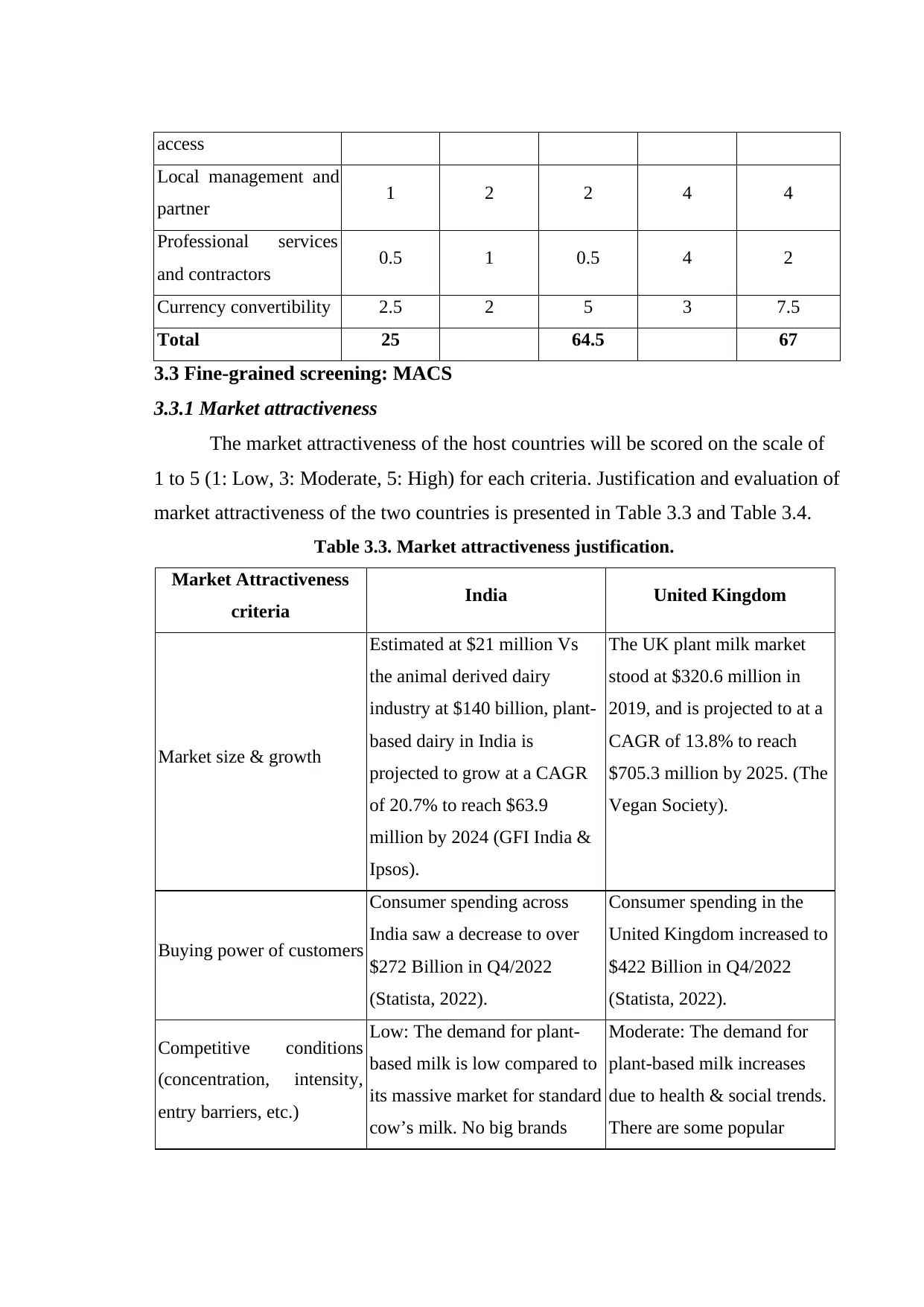
access
Local management and
partner 1 2 2 4 4
Professional services
and contractors 0.5 1 0.5 4 2
Currency convertibility 2.5 2 5 3 7.5
Total 25 64.5 67
3.3 Fine-grained screening: MACS
3.3.1 Market attractiveness
The market attractiveness of the host countries will be scored on the scale of
1 to 5 (1: Low, 3: Moderate, 5: High) for each criteria. Justification and evaluation of
market attractiveness of the two countries is presented in Table 3.3 and Table 3.4.
Table 3.3. Market attractiveness justification.
Market Attractiveness
criteria India United Kingdom
Market size & growth
Estimated at $21 million Vs
the animal derived dairy
industry at $140 billion, plant-
based dairy in India is
projected to grow at a CAGR
of 20.7% to reach $63.9
million by 2024 (GFI India &
Ipsos).
The UK plant milk market
stood at $320.6 million in
2019, and is projected to at a
CAGR of 13.8% to reach
$705.3 million by 2025. (The
Vegan Society).
Buying power of customers
Consumer spending across
India saw a decrease to over
$272 Billion in Q4/2022
(Statista, 2022).
Consumer spending in the
United Kingdom increased to
$422 Billion in Q4/2022
(Statista, 2022).
Competitive conditions
(concentration, intensity,
entry barriers, etc.)
Low: The demand for plant-
based milk is low compared to
its massive market for standard
cow’s milk. No big brands
Moderate: The demand for
plant-based milk increases
due to health & social trends.
There are some popular
Local management and
partner 1 2 2 4 4
Professional services
and contractors 0.5 1 0.5 4 2
Currency convertibility 2.5 2 5 3 7.5
Total 25 64.5 67
3.3 Fine-grained screening: MACS
3.3.1 Market attractiveness
The market attractiveness of the host countries will be scored on the scale of
1 to 5 (1: Low, 3: Moderate, 5: High) for each criteria. Justification and evaluation of
market attractiveness of the two countries is presented in Table 3.3 and Table 3.4.
Table 3.3. Market attractiveness justification.
Market Attractiveness
criteria India United Kingdom
Market size & growth
Estimated at $21 million Vs
the animal derived dairy
industry at $140 billion, plant-
based dairy in India is
projected to grow at a CAGR
of 20.7% to reach $63.9
million by 2024 (GFI India &
Ipsos).
The UK plant milk market
stood at $320.6 million in
2019, and is projected to at a
CAGR of 13.8% to reach
$705.3 million by 2025. (The
Vegan Society).
Buying power of customers
Consumer spending across
India saw a decrease to over
$272 Billion in Q4/2022
(Statista, 2022).
Consumer spending in the
United Kingdom increased to
$422 Billion in Q4/2022
(Statista, 2022).
Competitive conditions
(concentration, intensity,
entry barriers, etc.)
Low: The demand for plant-
based milk is low compared to
its massive market for standard
cow’s milk. No big brands
Moderate: The demand for
plant-based milk increases
due to health & social trends.
There are some popular

dominate the market (GFI
India & Ipsos).
brands, such as Oatly, Alpro;
nonetheless, no brands really
dominate the market.
Infrastructure
Global Quality Infrastructure
Index 2021: 0.817, ranked
10th
Global Quality Infrastructure
Index 2021: 0.9318, ranked
4th
Economic and political
stability (BERI)
BERI: 62 BERI: 67
Availability of labor/Labor
price
- Labor force (2021): 507,704
million, by World Bank
- Minimum wage (2022): $63,
by International Labor
Organization
- Labor force (2021): 34,465
million, by World Bank
- Minimum wage (2022):
$1953, by International
Labor Organization
Table 3.4: Market attractiveness scores.
Market
Attractiveness Weight
India United Kingdom
Score Overall
Index Score Overall Index
Market size & growth 0.25 1 0.25 5 1.25
BERI 0.2 3 0.6 5 1
Buying power of
customers 0.15 3 0.45 3 0.45
Competitive
conditions
(concentration,
intensity, entry
barriers, etc.)
0.15 1 0.15 3 0.45
Availability of
labor/Labor price 0.1 5 0.5 1 0.1
Infrastructure 0.1 3 0.3 5 0.5
Total 1 2.25 3.75
India & Ipsos).
brands, such as Oatly, Alpro;
nonetheless, no brands really
dominate the market.
Infrastructure
Global Quality Infrastructure
Index 2021: 0.817, ranked
10th
Global Quality Infrastructure
Index 2021: 0.9318, ranked
4th
Economic and political
stability (BERI)
BERI: 62 BERI: 67
Availability of labor/Labor
price
- Labor force (2021): 507,704
million, by World Bank
- Minimum wage (2022): $63,
by International Labor
Organization
- Labor force (2021): 34,465
million, by World Bank
- Minimum wage (2022):
$1953, by International
Labor Organization
Table 3.4: Market attractiveness scores.
Market
Attractiveness Weight
India United Kingdom
Score Overall
Index Score Overall Index
Market size & growth 0.25 1 0.25 5 1.25
BERI 0.2 3 0.6 5 1
Buying power of
customers 0.15 3 0.45 3 0.45
Competitive
conditions
(concentration,
intensity, entry
barriers, etc.)
0.15 1 0.15 3 0.45
Availability of
labor/Labor price 0.1 5 0.5 1 0.1
Infrastructure 0.1 3 0.3 5 0.5
Total 1 2.25 3.75
Secure Best Marks with AI Grader
Need help grading? Try our AI Grader for instant feedback on your assignments.
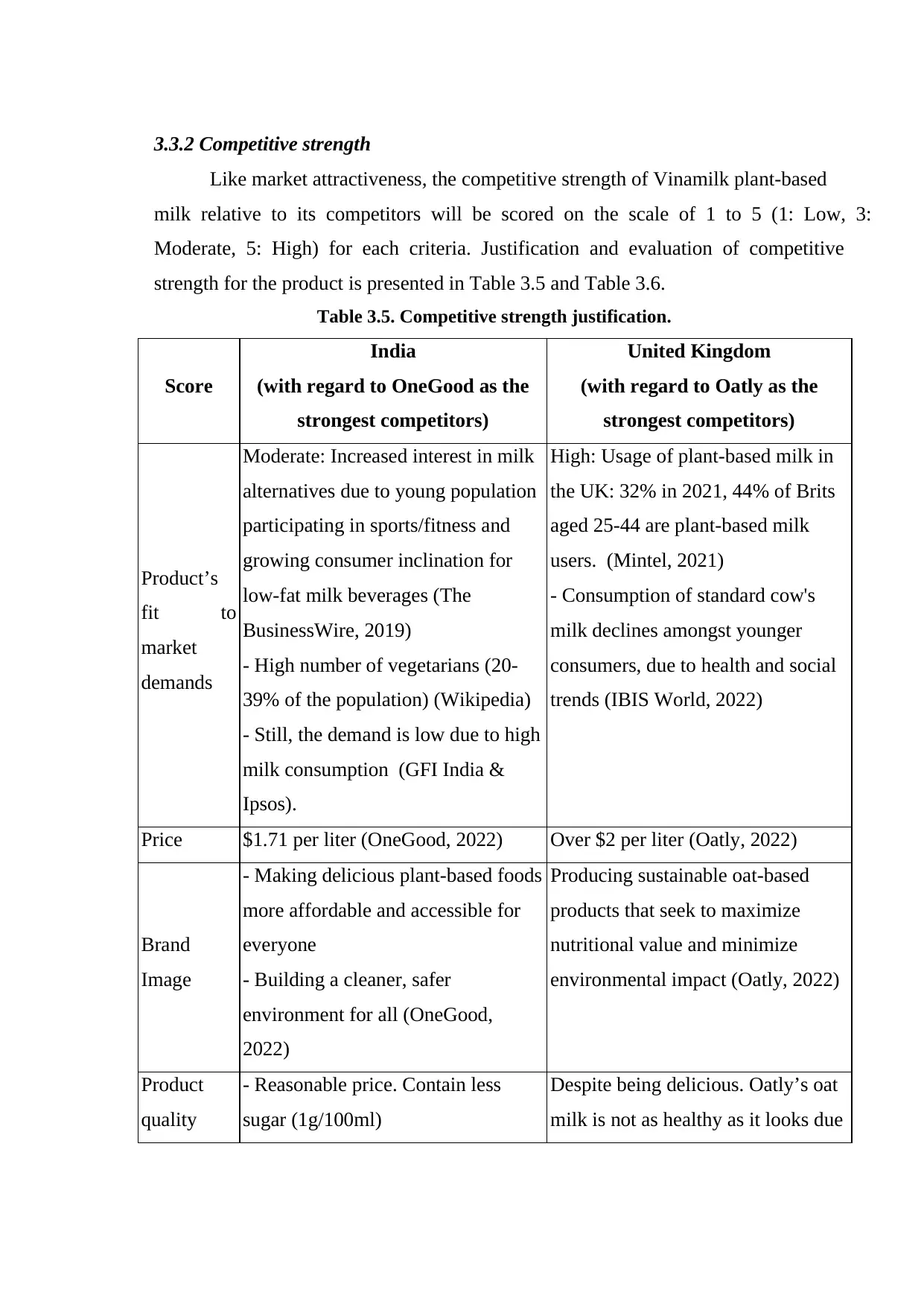
3.3.2 Competitive strength
Like market attractiveness, the competitive strength of Vinamilk plant-based
milk relative to its competitors will be scored on the scale of 1 to 5 (1: Low, 3:
Moderate, 5: High) for each criteria. Justification and evaluation of competitive
strength for the product is presented in Table 3.5 and Table 3.6.
Table 3.5. Competitive strength justification.
Score
India
(with regard to OneGood as the
strongest competitors)
United Kingdom
(with regard to Oatly as the
strongest competitors)
Product’s
fit to
market
demands
Moderate: Increased interest in milk
alternatives due to young population
participating in sports/fitness and
growing consumer inclination for
low-fat milk beverages (The
BusinessWire, 2019)
- High number of vegetarians (20-
39% of the population) (Wikipedia)
- Still, the demand is low due to high
milk consumption (GFI India &
Ipsos).
High: Usage of plant-based milk in
the UK: 32% in 2021, 44% of Brits
aged 25-44 are plant-based milk
users. (Mintel, 2021)
- Consumption of standard cow's
milk declines amongst younger
consumers, due to health and social
trends (IBIS World, 2022)
Price $1.71 per liter (OneGood, 2022) Over $2 per liter (Oatly, 2022)
Brand
Image
- Making delicious plant-based foods
more affordable and accessible for
everyone
- Building a cleaner, safer
environment for all (OneGood,
2022)
Producing sustainable oat-based
products that seek to maximize
nutritional value and minimize
environmental impact (Oatly, 2022)
Product
quality
- Reasonable price. Contain less
sugar (1g/100ml)
Despite being delicious. Oatly’s oat
milk is not as healthy as it looks due
Like market attractiveness, the competitive strength of Vinamilk plant-based
milk relative to its competitors will be scored on the scale of 1 to 5 (1: Low, 3:
Moderate, 5: High) for each criteria. Justification and evaluation of competitive
strength for the product is presented in Table 3.5 and Table 3.6.
Table 3.5. Competitive strength justification.
Score
India
(with regard to OneGood as the
strongest competitors)
United Kingdom
(with regard to Oatly as the
strongest competitors)
Product’s
fit to
market
demands
Moderate: Increased interest in milk
alternatives due to young population
participating in sports/fitness and
growing consumer inclination for
low-fat milk beverages (The
BusinessWire, 2019)
- High number of vegetarians (20-
39% of the population) (Wikipedia)
- Still, the demand is low due to high
milk consumption (GFI India &
Ipsos).
High: Usage of plant-based milk in
the UK: 32% in 2021, 44% of Brits
aged 25-44 are plant-based milk
users. (Mintel, 2021)
- Consumption of standard cow's
milk declines amongst younger
consumers, due to health and social
trends (IBIS World, 2022)
Price $1.71 per liter (OneGood, 2022) Over $2 per liter (Oatly, 2022)
Brand
Image
- Making delicious plant-based foods
more affordable and accessible for
everyone
- Building a cleaner, safer
environment for all (OneGood,
2022)
Producing sustainable oat-based
products that seek to maximize
nutritional value and minimize
environmental impact (Oatly, 2022)
Product
quality
- Reasonable price. Contain less
sugar (1g/100ml)
Despite being delicious. Oatly’s oat
milk is not as healthy as it looks due
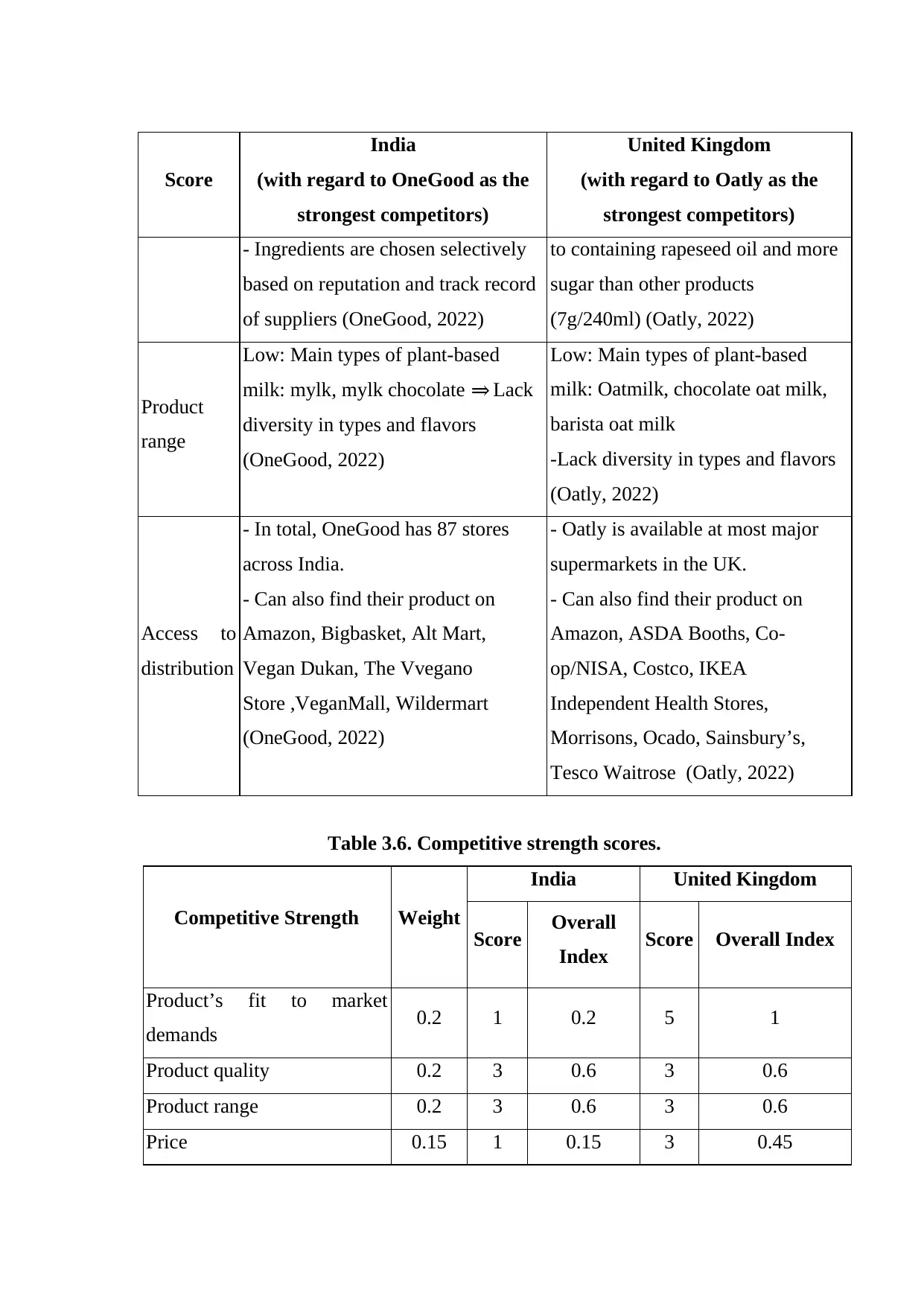
Score
India
(with regard to OneGood as the
strongest competitors)
United Kingdom
(with regard to Oatly as the
strongest competitors)
- Ingredients are chosen selectively
based on reputation and track record
of suppliers (OneGood, 2022)
to containing rapeseed oil and more
sugar than other products
(7g/240ml) (Oatly, 2022)
Product
range
Low: Main types of plant-based
milk: mylk, mylk chocolate ⇒ Lack
diversity in types and flavors
(OneGood, 2022)
Low: Main types of plant-based
milk: Oatmilk, chocolate oat milk,
barista oat milk
-Lack diversity in types and flavors
(Oatly, 2022)
Access to
distribution
- In total, OneGood has 87 stores
across India.
- Can also find their product on
Amazon, Bigbasket, Alt Mart,
Vegan Dukan, The Vvegano
Store ,VeganMall, Wildermart
(OneGood, 2022)
- Oatly is available at most major
supermarkets in the UK.
- Can also find their product on
Amazon, ASDA Booths, Co-
op/NISA, Costco, IKEA
Independent Health Stores,
Morrisons, Ocado, Sainsbury’s,
Tesco Waitrose (Oatly, 2022)
Table 3.6. Competitive strength scores.
Competitive Strength Weight
India United Kingdom
Score Overall
Index Score Overall Index
Product’s fit to market
demands 0.2 1 0.2 5 1
Product quality 0.2 3 0.6 3 0.6
Product range 0.2 3 0.6 3 0.6
Price 0.15 1 0.15 3 0.45
India
(with regard to OneGood as the
strongest competitors)
United Kingdom
(with regard to Oatly as the
strongest competitors)
- Ingredients are chosen selectively
based on reputation and track record
of suppliers (OneGood, 2022)
to containing rapeseed oil and more
sugar than other products
(7g/240ml) (Oatly, 2022)
Product
range
Low: Main types of plant-based
milk: mylk, mylk chocolate ⇒ Lack
diversity in types and flavors
(OneGood, 2022)
Low: Main types of plant-based
milk: Oatmilk, chocolate oat milk,
barista oat milk
-Lack diversity in types and flavors
(Oatly, 2022)
Access to
distribution
- In total, OneGood has 87 stores
across India.
- Can also find their product on
Amazon, Bigbasket, Alt Mart,
Vegan Dukan, The Vvegano
Store ,VeganMall, Wildermart
(OneGood, 2022)
- Oatly is available at most major
supermarkets in the UK.
- Can also find their product on
Amazon, ASDA Booths, Co-
op/NISA, Costco, IKEA
Independent Health Stores,
Morrisons, Ocado, Sainsbury’s,
Tesco Waitrose (Oatly, 2022)
Table 3.6. Competitive strength scores.
Competitive Strength Weight
India United Kingdom
Score Overall
Index Score Overall Index
Product’s fit to market
demands 0.2 1 0.2 5 1
Product quality 0.2 3 0.6 3 0.6
Product range 0.2 3 0.6 3 0.6
Price 0.15 1 0.15 3 0.45
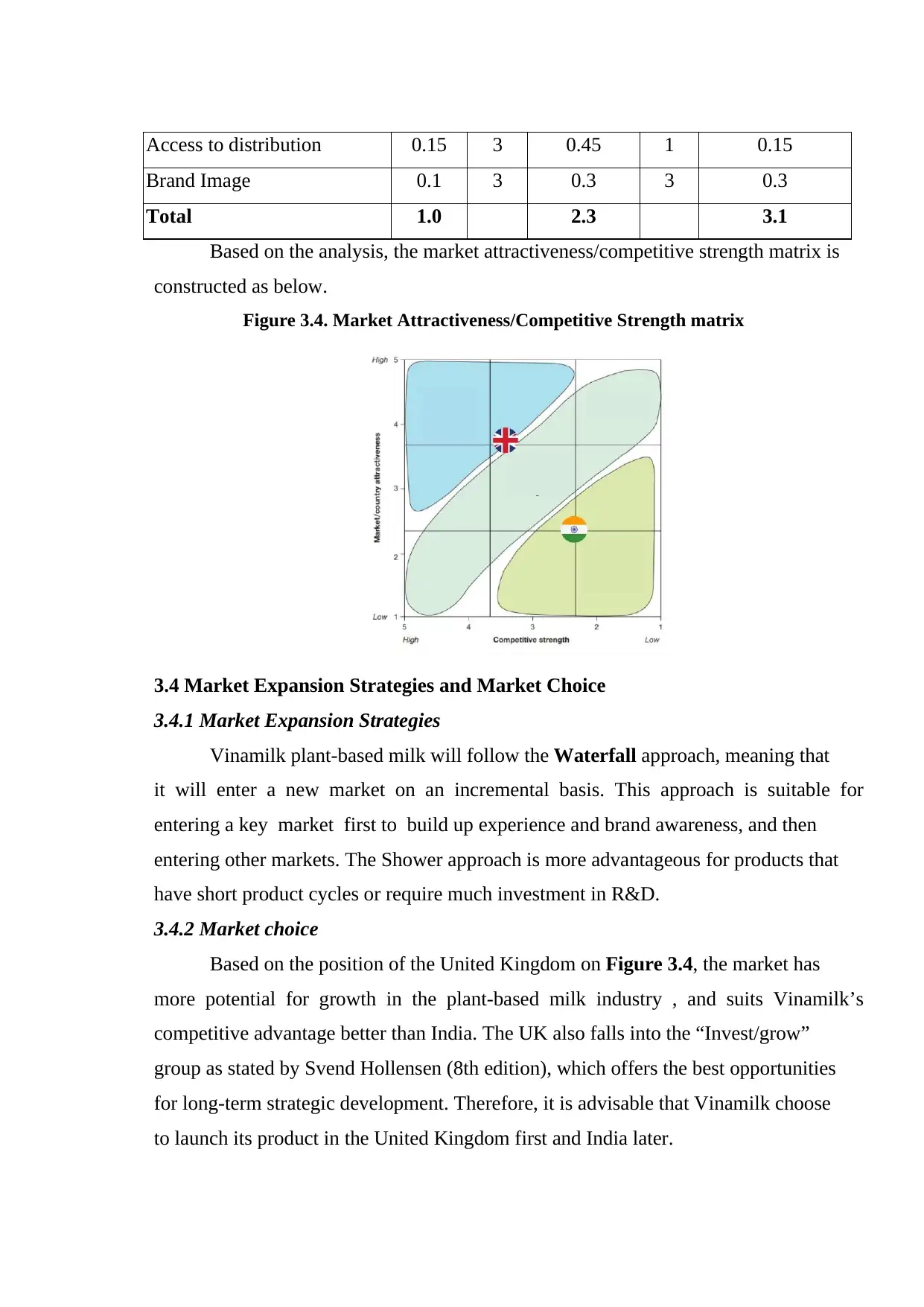
Access to distribution 0.15 3 0.45 1 0.15
Brand Image 0.1 3 0.3 3 0.3
Total 1.0 2.3 3.1
Based on the analysis, the market attractiveness/competitive strength matrix is
constructed as below.
Figure 3.4. Market Attractiveness/Competitive Strength matrix
3.4 Market Expansion Strategies and Market Choice
3.4.1 Market Expansion Strategies
Vinamilk plant-based milk will follow the Waterfall approach, meaning that
it will enter a new market on an incremental basis. This approach is suitable for
entering a key market first to build up experience and brand awareness, and then
entering other markets. The Shower approach is more advantageous for products that
have short product cycles or require much investment in R&D.
3.4.2 Market choice
Based on the position of the United Kingdom on Figure 3.4, the market has
more potential for growth in the plant-based milk industry , and suits Vinamilk’s
competitive advantage better than India. The UK also falls into the “Invest/grow”
group as stated by Svend Hollensen (8th edition), which offers the best opportunities
for long-term strategic development. Therefore, it is advisable that Vinamilk choose
to launch its product in the United Kingdom first and India later.
Brand Image 0.1 3 0.3 3 0.3
Total 1.0 2.3 3.1
Based on the analysis, the market attractiveness/competitive strength matrix is
constructed as below.
Figure 3.4. Market Attractiveness/Competitive Strength matrix
3.4 Market Expansion Strategies and Market Choice
3.4.1 Market Expansion Strategies
Vinamilk plant-based milk will follow the Waterfall approach, meaning that
it will enter a new market on an incremental basis. This approach is suitable for
entering a key market first to build up experience and brand awareness, and then
entering other markets. The Shower approach is more advantageous for products that
have short product cycles or require much investment in R&D.
3.4.2 Market choice
Based on the position of the United Kingdom on Figure 3.4, the market has
more potential for growth in the plant-based milk industry , and suits Vinamilk’s
competitive advantage better than India. The UK also falls into the “Invest/grow”
group as stated by Svend Hollensen (8th edition), which offers the best opportunities
for long-term strategic development. Therefore, it is advisable that Vinamilk choose
to launch its product in the United Kingdom first and India later.
Paraphrase This Document
Need a fresh take? Get an instant paraphrase of this document with our AI Paraphraser

CHAPTER 4. ENTRY MODE
4.1. SWOT Analysis of Vinamilk
Based on the characteristics of Vinamilk, the milk industry, and the UK
market, we have chosen 6 entry criteria as the factors influencing our entry mode.
Here is the table summarizing our research findings:
Table 4.1. Analysis of entry criteria for Vinamilk
Entry
Criteria Details Indication
Internal
factors
STRENGTHS OPPORTUNITIES
Firm size
- A large-sized enterprise (LSE).
- Vietnam's largest food processor,
accounting for about 50% of
Vietnam's dairy market.
- Vinamilk is the largest listed F&B on
HOSE ($8.5B market cap), and
ranked 36th by revenue. (Vinamilk,
2022)
- Secured high resource
commitment.
⇒ May pursue the
intermediate or hierarchical
mode.
International Experience
- 14 production factories, 2 logistics
enterprises, 3 branch sales offices, 1
dairy factory in Cambodia
(Angkormilk), 1 representative office
in Thailand (Vinamilk, 2021).
- Net revenue from international
business: 9,717 billion VND, rising by
10.5% compared to the previous year.
- Exported to 57 countries. (Vinamilk,
2021)
- Reduce the cost and
uncertainty of serving a
market.
- Increases the probability of
firms committing resources to
foreign markets.
⇒ Favors direct investment in
the form of wholly owned
subsidiaries (hierarchical
modes)
Production Differentiation Advantage
- Constantly develops new product
formulas, invests in modern
machinery and equipment, and
improves existing production to
promote business activities.
- Not clearly seen at Vinamilk. Even
though Vinamilk has a strong brand
Less worried about protecting
its product competitive
advantages.
⇒ Can consider other options
rather than only hierarchical
modes.
4.1. SWOT Analysis of Vinamilk
Based on the characteristics of Vinamilk, the milk industry, and the UK
market, we have chosen 6 entry criteria as the factors influencing our entry mode.
Here is the table summarizing our research findings:
Table 4.1. Analysis of entry criteria for Vinamilk
Entry
Criteria Details Indication
Internal
factors
STRENGTHS OPPORTUNITIES
Firm size
- A large-sized enterprise (LSE).
- Vietnam's largest food processor,
accounting for about 50% of
Vietnam's dairy market.
- Vinamilk is the largest listed F&B on
HOSE ($8.5B market cap), and
ranked 36th by revenue. (Vinamilk,
2022)
- Secured high resource
commitment.
⇒ May pursue the
intermediate or hierarchical
mode.
International Experience
- 14 production factories, 2 logistics
enterprises, 3 branch sales offices, 1
dairy factory in Cambodia
(Angkormilk), 1 representative office
in Thailand (Vinamilk, 2021).
- Net revenue from international
business: 9,717 billion VND, rising by
10.5% compared to the previous year.
- Exported to 57 countries. (Vinamilk,
2021)
- Reduce the cost and
uncertainty of serving a
market.
- Increases the probability of
firms committing resources to
foreign markets.
⇒ Favors direct investment in
the form of wholly owned
subsidiaries (hierarchical
modes)
Production Differentiation Advantage
- Constantly develops new product
formulas, invests in modern
machinery and equipment, and
improves existing production to
promote business activities.
- Not clearly seen at Vinamilk. Even
though Vinamilk has a strong brand
Less worried about protecting
its product competitive
advantages.
⇒ Can consider other options
rather than only hierarchical
modes.
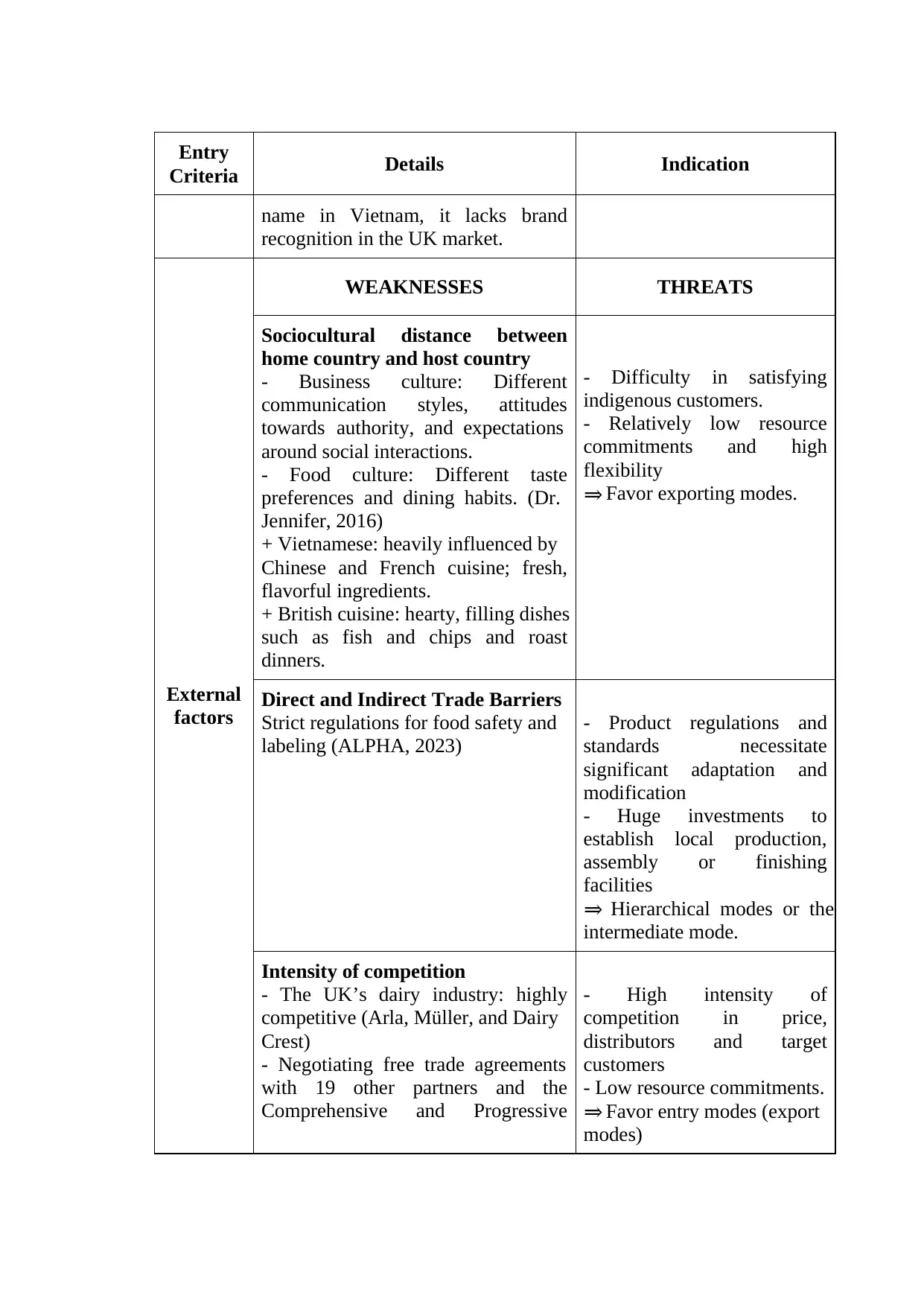
Entry
Criteria Details Indication
name in Vietnam, it lacks brand
recognition in the UK market.
External
factors
WEAKNESSES THREATS
Sociocultural distance between
home country and host country
- Business culture: Different
communication styles, attitudes
towards authority, and expectations
around social interactions.
- Food culture: Different taste
preferences and dining habits. (Dr.
Jennifer, 2016)
+ Vietnamese: heavily influenced by
Chinese and French cuisine; fresh,
flavorful ingredients.
+ British cuisine: hearty, filling dishes
such as fish and chips and roast
dinners.
- Difficulty in satisfying
indigenous customers.
- Relatively low resource
commitments and high
flexibility
⇒ Favor exporting modes.
Direct and Indirect Trade Barriers
Strict regulations for food safety and
labeling (ALPHA, 2023)
- Product regulations and
standards necessitate
significant adaptation and
modification
- Huge investments to
establish local production,
assembly or finishing
facilities
⇒ Hierarchical modes or the
intermediate mode.
Intensity of competition
- The UK’s dairy industry: highly
competitive (Arla, Müller, and Dairy
Crest)
- Negotiating free trade agreements
with 19 other partners and the
Comprehensive and Progressive
- High intensity of
competition in price,
distributors and target
customers
- Low resource commitments.
⇒ Favor entry modes (export
modes)
Criteria Details Indication
name in Vietnam, it lacks brand
recognition in the UK market.
External
factors
WEAKNESSES THREATS
Sociocultural distance between
home country and host country
- Business culture: Different
communication styles, attitudes
towards authority, and expectations
around social interactions.
- Food culture: Different taste
preferences and dining habits. (Dr.
Jennifer, 2016)
+ Vietnamese: heavily influenced by
Chinese and French cuisine; fresh,
flavorful ingredients.
+ British cuisine: hearty, filling dishes
such as fish and chips and roast
dinners.
- Difficulty in satisfying
indigenous customers.
- Relatively low resource
commitments and high
flexibility
⇒ Favor exporting modes.
Direct and Indirect Trade Barriers
Strict regulations for food safety and
labeling (ALPHA, 2023)
- Product regulations and
standards necessitate
significant adaptation and
modification
- Huge investments to
establish local production,
assembly or finishing
facilities
⇒ Hierarchical modes or the
intermediate mode.
Intensity of competition
- The UK’s dairy industry: highly
competitive (Arla, Müller, and Dairy
Crest)
- Negotiating free trade agreements
with 19 other partners and the
Comprehensive and Progressive
- High intensity of
competition in price,
distributors and target
customers
- Low resource commitments.
⇒ Favor entry modes (export
modes)
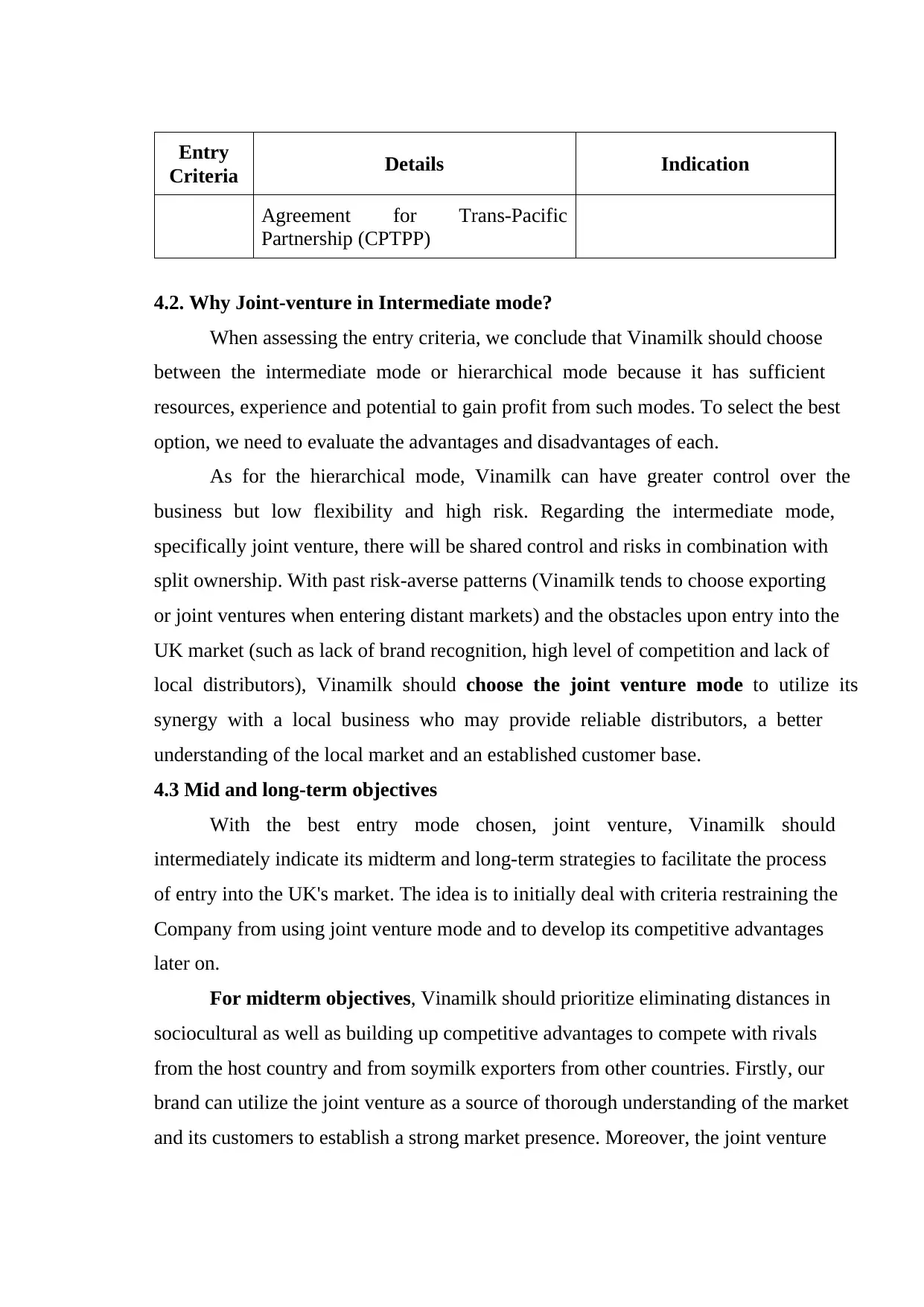
4.2. Why Joint-venture in Intermediate mode?
When assessing the entry criteria, we conclude that Vinamilk should choose
between the intermediate mode or hierarchical mode because it has sufficient
resources, experience and potential to gain profit from such modes. To select the best
option, we need to evaluate the advantages and disadvantages of each.
As for the hierarchical mode, Vinamilk can have greater control over the
business but low flexibility and high risk. Regarding the intermediate mode,
specifically joint venture, there will be shared control and risks in combination with
split ownership. With past risk-averse patterns (Vinamilk tends to choose exporting
or joint ventures when entering distant markets) and the obstacles upon entry into the
UK market (such as lack of brand recognition, high level of competition and lack of
local distributors), Vinamilk should choose the joint venture mode to utilize its
synergy with a local business who may provide reliable distributors, a better
understanding of the local market and an established customer base.
4.3 Mid and long-term objectives
With the best entry mode chosen, joint venture, Vinamilk should
intermediately indicate its midterm and long-term strategies to facilitate the process
of entry into the UK's market. The idea is to initially deal with criteria restraining the
Company from using joint venture mode and to develop its competitive advantages
later on.
For midterm objectives, Vinamilk should prioritize eliminating distances in
sociocultural as well as building up competitive advantages to compete with rivals
from the host country and from soymilk exporters from other countries. Firstly, our
brand can utilize the joint venture as a source of thorough understanding of the market
and its customers to establish a strong market presence. Moreover, the joint venture
Entry
Criteria Details Indication
Agreement for Trans-Pacific
Partnership (CPTPP)
When assessing the entry criteria, we conclude that Vinamilk should choose
between the intermediate mode or hierarchical mode because it has sufficient
resources, experience and potential to gain profit from such modes. To select the best
option, we need to evaluate the advantages and disadvantages of each.
As for the hierarchical mode, Vinamilk can have greater control over the
business but low flexibility and high risk. Regarding the intermediate mode,
specifically joint venture, there will be shared control and risks in combination with
split ownership. With past risk-averse patterns (Vinamilk tends to choose exporting
or joint ventures when entering distant markets) and the obstacles upon entry into the
UK market (such as lack of brand recognition, high level of competition and lack of
local distributors), Vinamilk should choose the joint venture mode to utilize its
synergy with a local business who may provide reliable distributors, a better
understanding of the local market and an established customer base.
4.3 Mid and long-term objectives
With the best entry mode chosen, joint venture, Vinamilk should
intermediately indicate its midterm and long-term strategies to facilitate the process
of entry into the UK's market. The idea is to initially deal with criteria restraining the
Company from using joint venture mode and to develop its competitive advantages
later on.
For midterm objectives, Vinamilk should prioritize eliminating distances in
sociocultural as well as building up competitive advantages to compete with rivals
from the host country and from soymilk exporters from other countries. Firstly, our
brand can utilize the joint venture as a source of thorough understanding of the market
and its customers to establish a strong market presence. Moreover, the joint venture
Entry
Criteria Details Indication
Agreement for Trans-Pacific
Partnership (CPTPP)
Secure Best Marks with AI Grader
Need help grading? Try our AI Grader for instant feedback on your assignments.
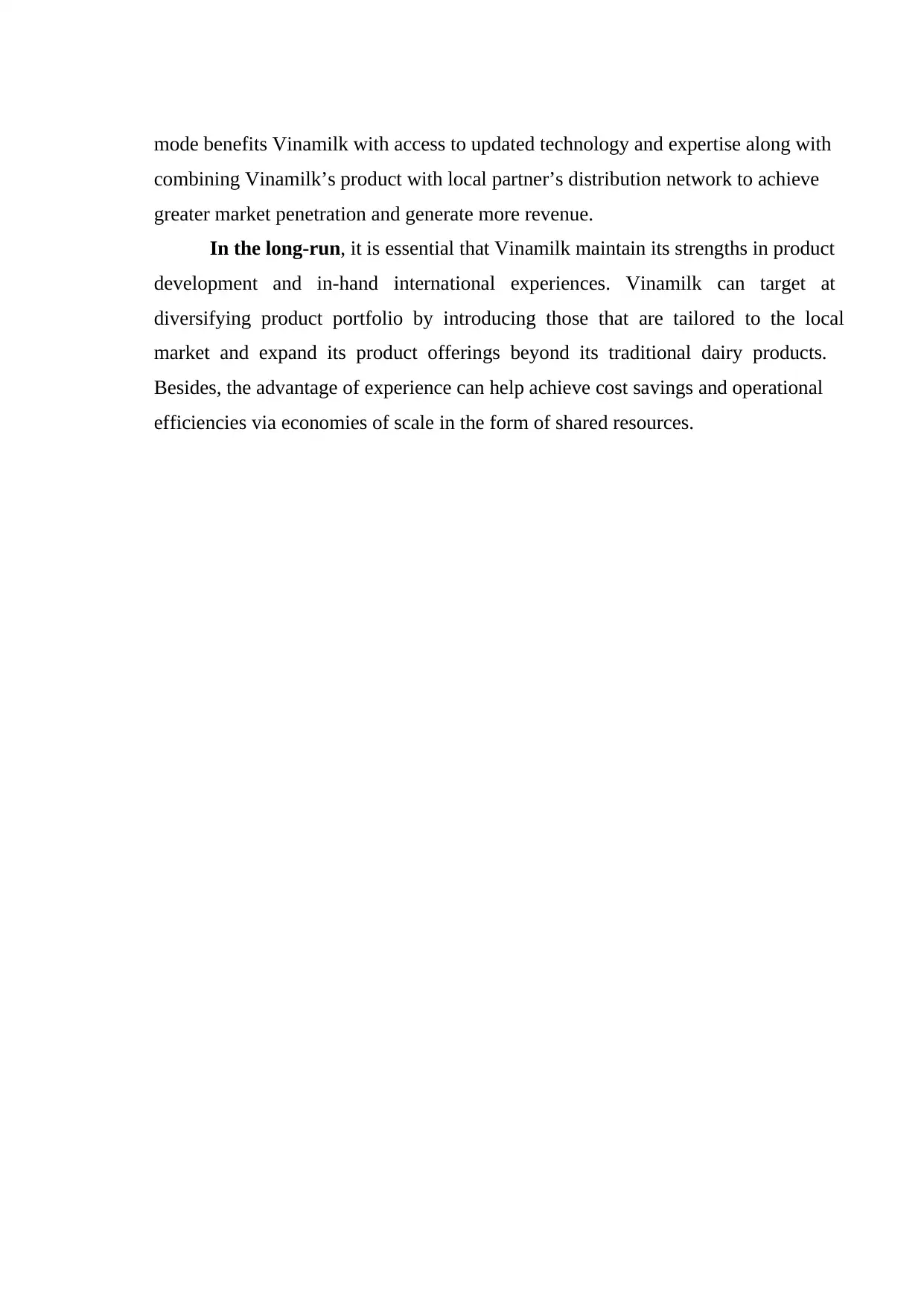
mode benefits Vinamilk with access to updated technology and expertise along with
combining Vinamilk’s product with local partner’s distribution network to achieve
greater market penetration and generate more revenue.
In the long-run, it is essential that Vinamilk maintain its strengths in product
development and in-hand international experiences. Vinamilk can target at
diversifying product portfolio by introducing those that are tailored to the local
market and expand its product offerings beyond its traditional dairy products.
Besides, the advantage of experience can help achieve cost savings and operational
efficiencies via economies of scale in the form of shared resources.
combining Vinamilk’s product with local partner’s distribution network to achieve
greater market penetration and generate more revenue.
In the long-run, it is essential that Vinamilk maintain its strengths in product
development and in-hand international experiences. Vinamilk can target at
diversifying product portfolio by introducing those that are tailored to the local
market and expand its product offerings beyond its traditional dairy products.
Besides, the advantage of experience can help achieve cost savings and operational
efficiencies via economies of scale in the form of shared resources.
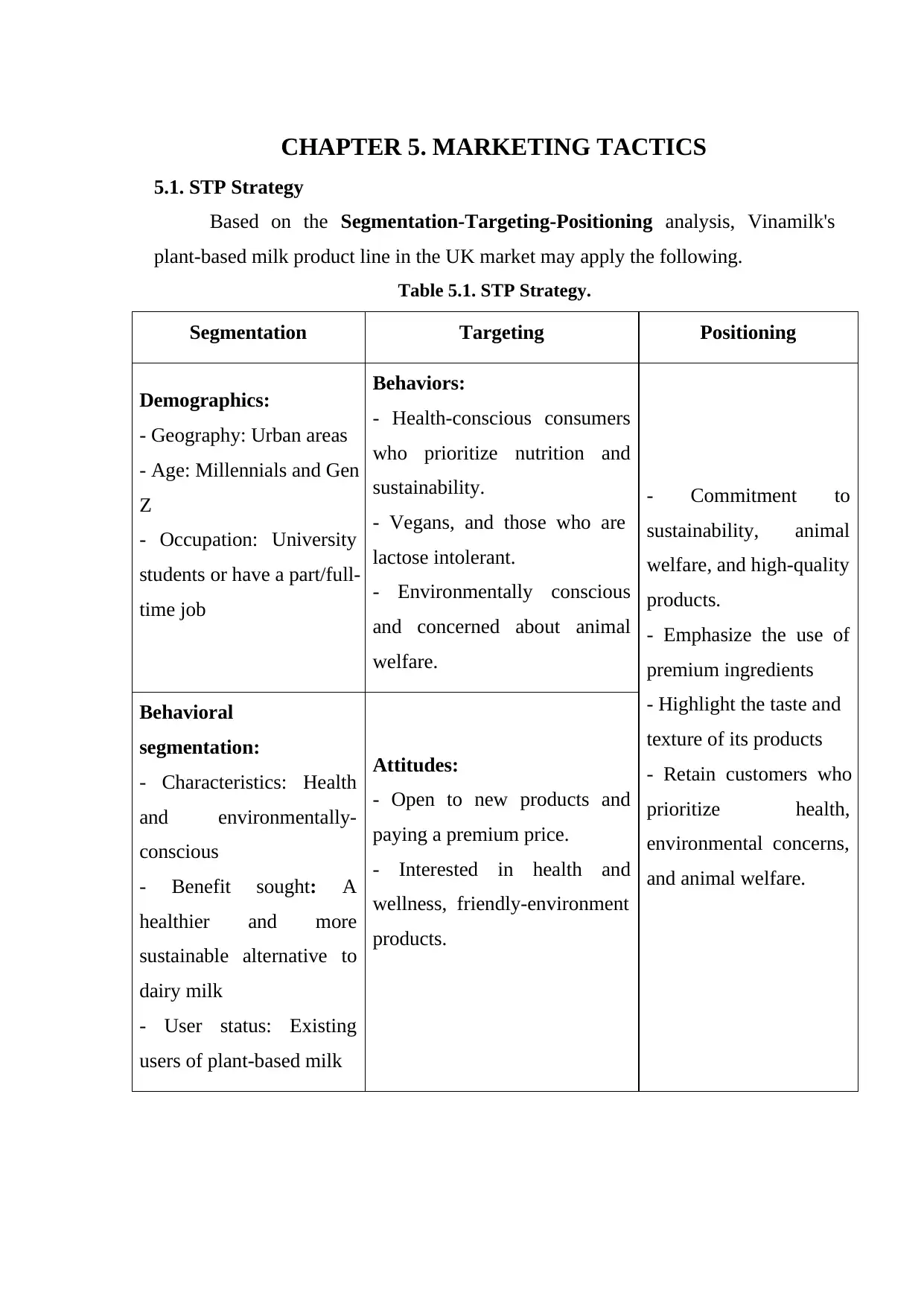
CHAPTER 5. MARKETING TACTICS
5.1. STP Strategy
Based on the Segmentation-Targeting-Positioning analysis, Vinamilk's
plant-based milk product line in the UK market may apply the following.
Table 5.1. STP Strategy.
Segmentation Targeting Positioning
Demographics:
- Geography: Urban areas
- Age: Millennials and Gen
Z
- Occupation: University
students or have a part/full-
time job
Behaviors:
- Health-conscious consumers
who prioritize nutrition and
sustainability.
- Vegans, and those who are
lactose intolerant.
- Environmentally conscious
and concerned about animal
welfare.
- Commitment to
sustainability, animal
welfare, and high-quality
products.
- Emphasize the use of
premium ingredients
- Highlight the taste and
texture of its products
- Retain customers who
prioritize health,
environmental concerns,
and animal welfare.
Behavioral
segmentation:
- Characteristics: Health
and environmentally-
conscious
- Benefit sought: A
healthier and more
sustainable alternative to
dairy milk
- User status: Existing
users of plant-based milk
Attitudes:
- Open to new products and
paying a premium price.
- Interested in health and
wellness, friendly-environment
products.
5.1. STP Strategy
Based on the Segmentation-Targeting-Positioning analysis, Vinamilk's
plant-based milk product line in the UK market may apply the following.
Table 5.1. STP Strategy.
Segmentation Targeting Positioning
Demographics:
- Geography: Urban areas
- Age: Millennials and Gen
Z
- Occupation: University
students or have a part/full-
time job
Behaviors:
- Health-conscious consumers
who prioritize nutrition and
sustainability.
- Vegans, and those who are
lactose intolerant.
- Environmentally conscious
and concerned about animal
welfare.
- Commitment to
sustainability, animal
welfare, and high-quality
products.
- Emphasize the use of
premium ingredients
- Highlight the taste and
texture of its products
- Retain customers who
prioritize health,
environmental concerns,
and animal welfare.
Behavioral
segmentation:
- Characteristics: Health
and environmentally-
conscious
- Benefit sought: A
healthier and more
sustainable alternative to
dairy milk
- User status: Existing
users of plant-based milk
Attitudes:
- Open to new products and
paying a premium price.
- Interested in health and
wellness, friendly-environment
products.
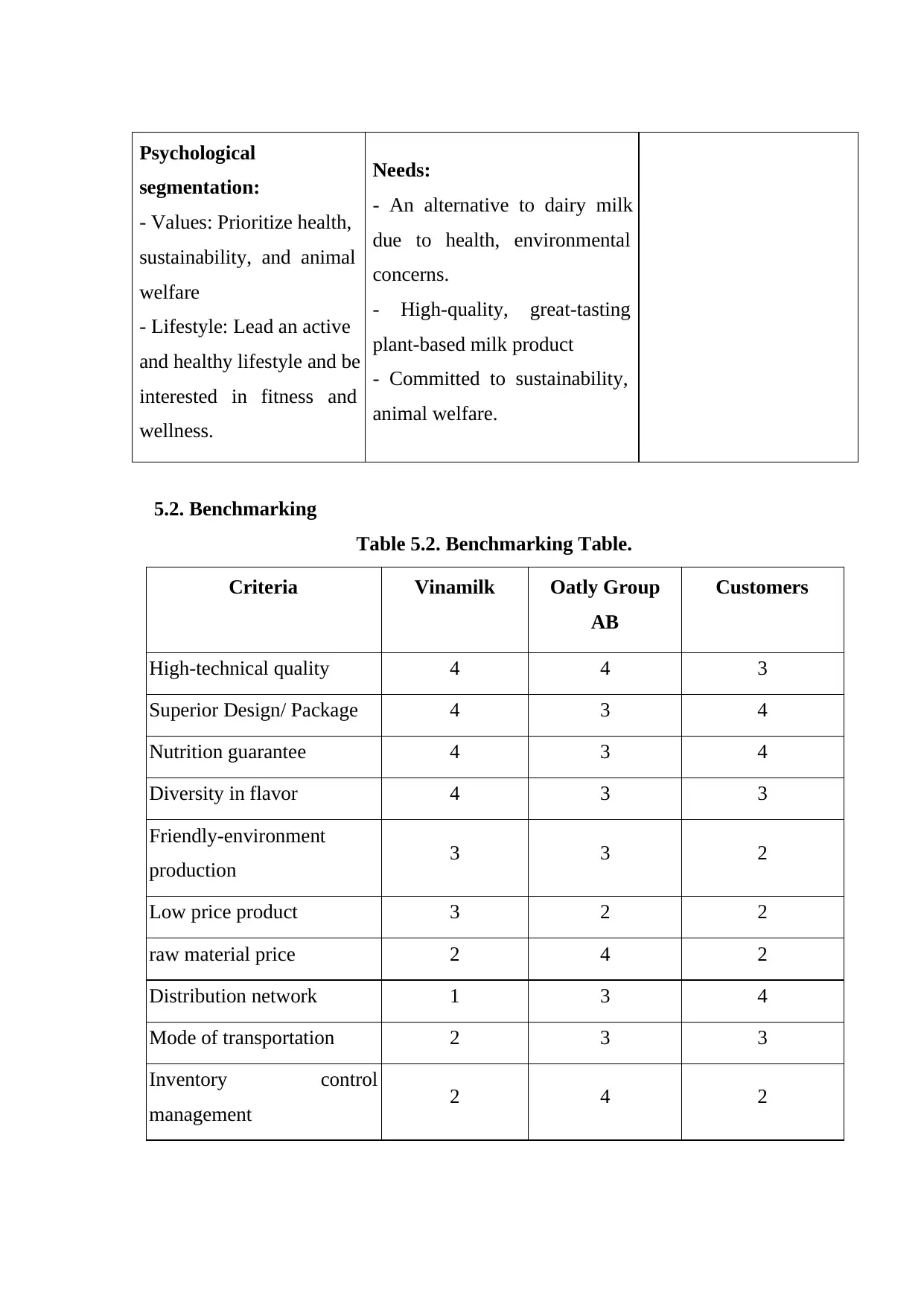
Psychological
segmentation:
- Values: Prioritize health,
sustainability, and animal
welfare
- Lifestyle: Lead an active
and healthy lifestyle and be
interested in fitness and
wellness.
Needs:
- An alternative to dairy milk
due to health, environmental
concerns.
- High-quality, great-tasting
plant-based milk product
- Committed to sustainability,
animal welfare.
5.2. Benchmarking
Table 5.2. Benchmarking Table.
Criteria Vinamilk Oatly Group
AB
Customers
High-technical quality 4 4 3
Superior Design/ Package 4 3 4
Nutrition guarantee 4 3 4
Diversity in flavor 4 3 3
Friendly-environment
production 3 3 2
Low price product 3 2 2
raw material price 2 4 2
Distribution network 1 3 4
Mode of transportation 2 3 3
Inventory control
management 2 4 2
segmentation:
- Values: Prioritize health,
sustainability, and animal
welfare
- Lifestyle: Lead an active
and healthy lifestyle and be
interested in fitness and
wellness.
Needs:
- An alternative to dairy milk
due to health, environmental
concerns.
- High-quality, great-tasting
plant-based milk product
- Committed to sustainability,
animal welfare.
5.2. Benchmarking
Table 5.2. Benchmarking Table.
Criteria Vinamilk Oatly Group
AB
Customers
High-technical quality 4 4 3
Superior Design/ Package 4 3 4
Nutrition guarantee 4 3 4
Diversity in flavor 4 3 3
Friendly-environment
production 3 3 2
Low price product 3 2 2
raw material price 2 4 2
Distribution network 1 3 4
Mode of transportation 2 3 3
Inventory control
management 2 4 2
Paraphrase This Document
Need a fresh take? Get an instant paraphrase of this document with our AI Paraphraser
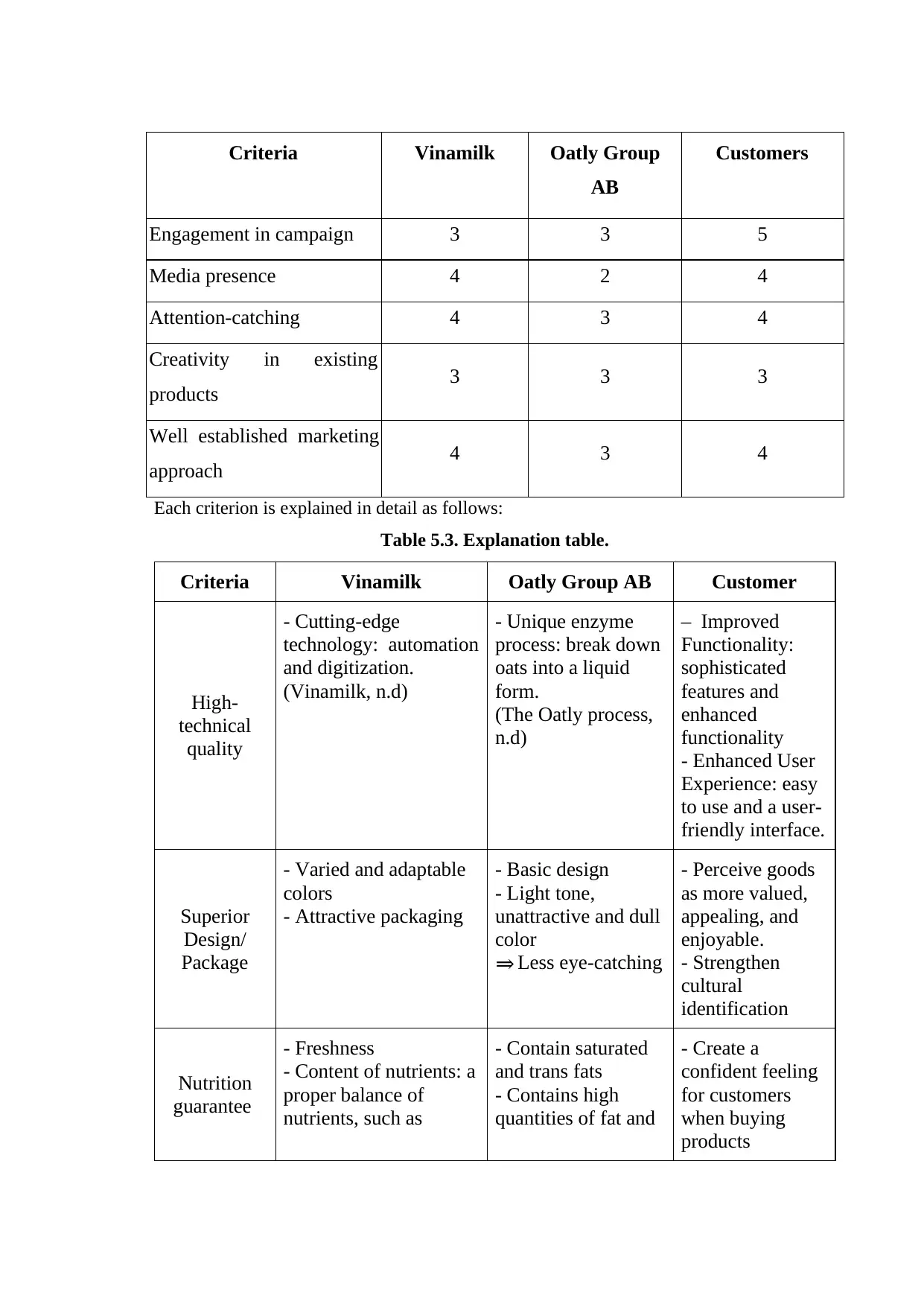
Criteria Vinamilk Oatly Group
AB
Customers
Engagement in campaign 3 3 5
Media presence 4 2 4
Attention-catching 4 3 4
Creativity in existing
products 3 3 3
Well established marketing
approach 4 3 4
Each criterion is explained in detail as follows:
Table 5.3. Explanation table.
Criteria Vinamilk Oatly Group AB Customer
High-
technical
quality
- Cutting-edge
technology: automation
and digitization.
(Vinamilk, n.d)
- Unique enzyme
process: break down
oats into a liquid
form.
(The Oatly process,
n.d)
– Improved
Functionality:
sophisticated
features and
enhanced
functionality
- Enhanced User
Experience: easy
to use and a user-
friendly interface.
Superior
Design/
Package
- Varied and adaptable
colors
- Attractive packaging
- Basic design
- Light tone,
unattractive and dull
color
⇒ Less eye-catching
- Perceive goods
as more valued,
appealing, and
enjoyable.
- Strengthen
cultural
identification
Nutrition
guarantee
- Freshness
- Content of nutrients: a
proper balance of
nutrients, such as
- Contain saturated
and trans fats
- Contains high
quantities of fat and
- Create a
confident feeling
for customers
when buying
products
AB
Customers
Engagement in campaign 3 3 5
Media presence 4 2 4
Attention-catching 4 3 4
Creativity in existing
products 3 3 3
Well established marketing
approach 4 3 4
Each criterion is explained in detail as follows:
Table 5.3. Explanation table.
Criteria Vinamilk Oatly Group AB Customer
High-
technical
quality
- Cutting-edge
technology: automation
and digitization.
(Vinamilk, n.d)
- Unique enzyme
process: break down
oats into a liquid
form.
(The Oatly process,
n.d)
– Improved
Functionality:
sophisticated
features and
enhanced
functionality
- Enhanced User
Experience: easy
to use and a user-
friendly interface.
Superior
Design/
Package
- Varied and adaptable
colors
- Attractive packaging
- Basic design
- Light tone,
unattractive and dull
color
⇒ Less eye-catching
- Perceive goods
as more valued,
appealing, and
enjoyable.
- Strengthen
cultural
identification
Nutrition
guarantee
- Freshness
- Content of nutrients: a
proper balance of
nutrients, such as
- Contain saturated
and trans fats
- Contains high
quantities of fat and
- Create a
confident feeling
for customers
when buying
products
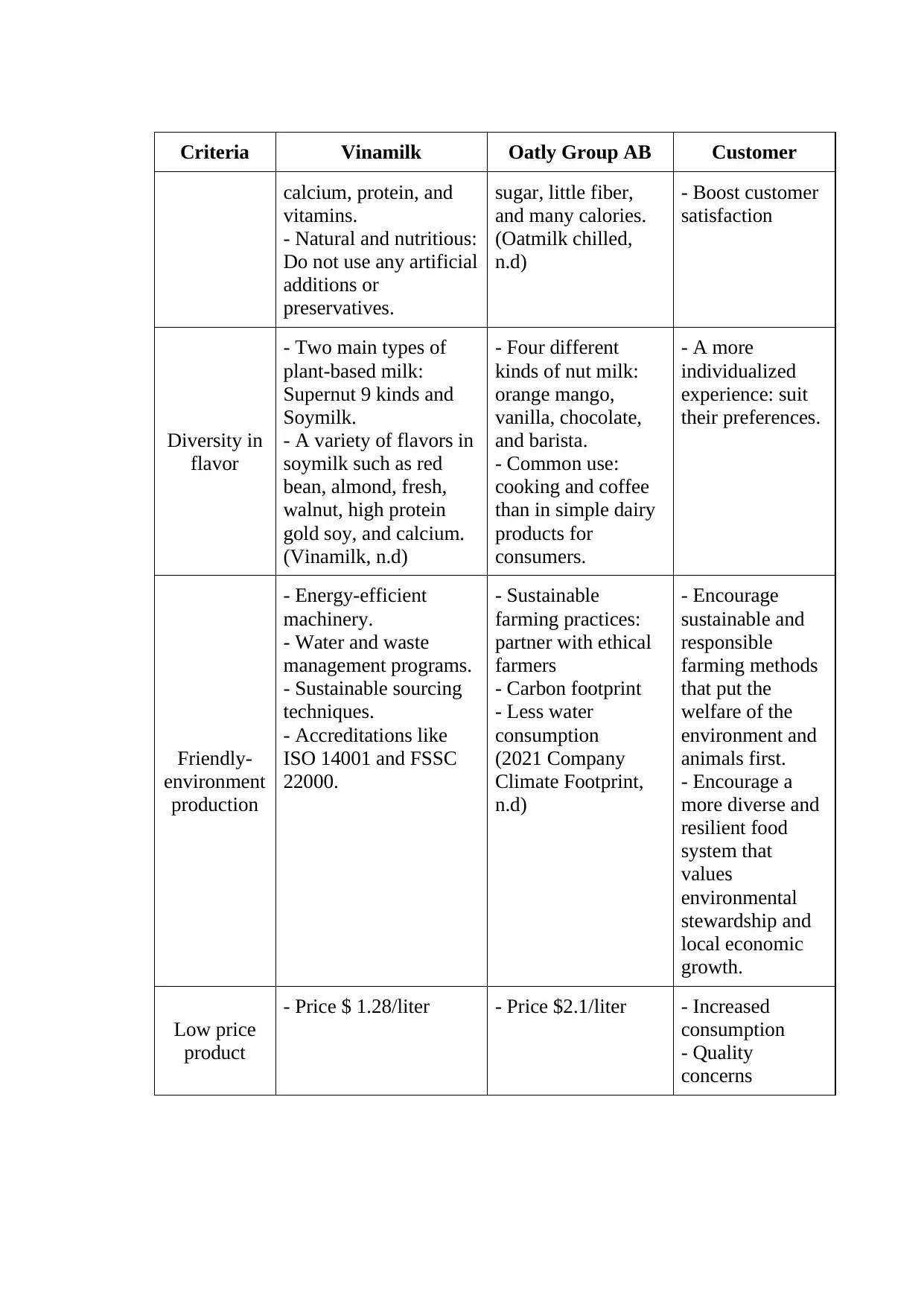
Criteria Vinamilk Oatly Group AB Customer
calcium, protein, and
vitamins.
- Natural and nutritious:
Do not use any artificial
additions or
preservatives.
sugar, little fiber,
and many calories.
(Oatmilk chilled,
n.d)
- Boost customer
satisfaction
Diversity in
flavor
- Two main types of
plant-based milk:
Supernut 9 kinds and
Soymilk.
- A variety of flavors in
soymilk such as red
bean, almond, fresh,
walnut, high protein
gold soy, and calcium.
(Vinamilk, n.d)
- Four different
kinds of nut milk:
orange mango,
vanilla, chocolate,
and barista.
- Common use:
cooking and coffee
than in simple dairy
products for
consumers.
- A more
individualized
experience: suit
their preferences.
Friendly-
environment
production
- Energy-efficient
machinery.
- Water and waste
management programs.
- Sustainable sourcing
techniques.
- Accreditations like
ISO 14001 and FSSC
22000.
- Sustainable
farming practices:
partner with ethical
farmers
- Carbon footprint
- Less water
consumption
(2021 Company
Climate Footprint,
n.d)
- Encourage
sustainable and
responsible
farming methods
that put the
welfare of the
environment and
animals first.
- Encourage a
more diverse and
resilient food
system that
values
environmental
stewardship and
local economic
growth.
Low price
product
- Price $ 1.28/liter - Price $2.1/liter - Increased
consumption
- Quality
concerns
calcium, protein, and
vitamins.
- Natural and nutritious:
Do not use any artificial
additions or
preservatives.
sugar, little fiber,
and many calories.
(Oatmilk chilled,
n.d)
- Boost customer
satisfaction
Diversity in
flavor
- Two main types of
plant-based milk:
Supernut 9 kinds and
Soymilk.
- A variety of flavors in
soymilk such as red
bean, almond, fresh,
walnut, high protein
gold soy, and calcium.
(Vinamilk, n.d)
- Four different
kinds of nut milk:
orange mango,
vanilla, chocolate,
and barista.
- Common use:
cooking and coffee
than in simple dairy
products for
consumers.
- A more
individualized
experience: suit
their preferences.
Friendly-
environment
production
- Energy-efficient
machinery.
- Water and waste
management programs.
- Sustainable sourcing
techniques.
- Accreditations like
ISO 14001 and FSSC
22000.
- Sustainable
farming practices:
partner with ethical
farmers
- Carbon footprint
- Less water
consumption
(2021 Company
Climate Footprint,
n.d)
- Encourage
sustainable and
responsible
farming methods
that put the
welfare of the
environment and
animals first.
- Encourage a
more diverse and
resilient food
system that
values
environmental
stewardship and
local economic
growth.
Low price
product
- Price $ 1.28/liter - Price $2.1/liter - Increased
consumption
- Quality
concerns
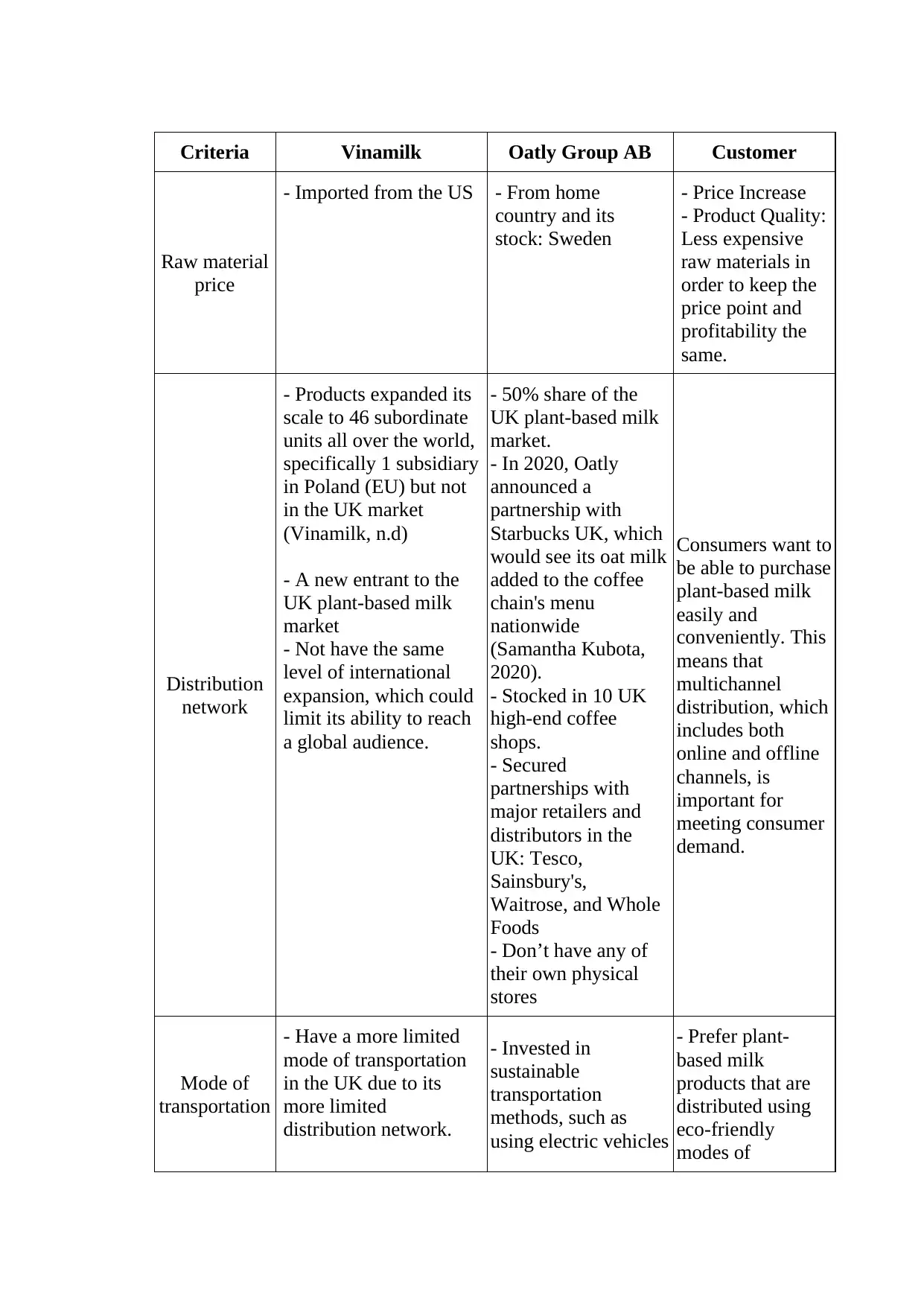
Criteria Vinamilk Oatly Group AB Customer
Raw material
price
- Imported from the US - From home
country and its
stock: Sweden
- Price Increase
- Product Quality:
Less expensive
raw materials in
order to keep the
price point and
profitability the
same.
Distribution
network
- Products expanded its
scale to 46 subordinate
units all over the world,
specifically 1 subsidiary
in Poland (EU) but not
in the UK market
(Vinamilk, n.d)
- A new entrant to the
UK plant-based milk
market
- Not have the same
level of international
expansion, which could
limit its ability to reach
a global audience.
- 50% share of the
UK plant-based milk
market.
- In 2020, Oatly
announced a
partnership with
Starbucks UK, which
would see its oat milk
added to the coffee
chain's menu
nationwide
(Samantha Kubota,
2020).
- Stocked in 10 UK
high-end coffee
shops.
- Secured
partnerships with
major retailers and
distributors in the
UK: Tesco,
Sainsbury's,
Waitrose, and Whole
Foods
- Don’t have any of
their own physical
stores
Consumers want to
be able to purchase
plant-based milk
easily and
conveniently. This
means that
multichannel
distribution, which
includes both
online and offline
channels, is
important for
meeting consumer
demand.
Mode of
transportation
- Have a more limited
mode of transportation
in the UK due to its
more limited
distribution network.
- Invested in
sustainable
transportation
methods, such as
using electric vehicles
- Prefer plant-
based milk
products that are
distributed using
eco-friendly
modes of
Raw material
price
- Imported from the US - From home
country and its
stock: Sweden
- Price Increase
- Product Quality:
Less expensive
raw materials in
order to keep the
price point and
profitability the
same.
Distribution
network
- Products expanded its
scale to 46 subordinate
units all over the world,
specifically 1 subsidiary
in Poland (EU) but not
in the UK market
(Vinamilk, n.d)
- A new entrant to the
UK plant-based milk
market
- Not have the same
level of international
expansion, which could
limit its ability to reach
a global audience.
- 50% share of the
UK plant-based milk
market.
- In 2020, Oatly
announced a
partnership with
Starbucks UK, which
would see its oat milk
added to the coffee
chain's menu
nationwide
(Samantha Kubota,
2020).
- Stocked in 10 UK
high-end coffee
shops.
- Secured
partnerships with
major retailers and
distributors in the
UK: Tesco,
Sainsbury's,
Waitrose, and Whole
Foods
- Don’t have any of
their own physical
stores
Consumers want to
be able to purchase
plant-based milk
easily and
conveniently. This
means that
multichannel
distribution, which
includes both
online and offline
channels, is
important for
meeting consumer
demand.
Mode of
transportation
- Have a more limited
mode of transportation
in the UK due to its
more limited
distribution network.
- Invested in
sustainable
transportation
methods, such as
using electric vehicles
- Prefer plant-
based milk
products that are
distributed using
eco-friendly
modes of
Secure Best Marks with AI Grader
Need help grading? Try our AI Grader for instant feedback on your assignments.
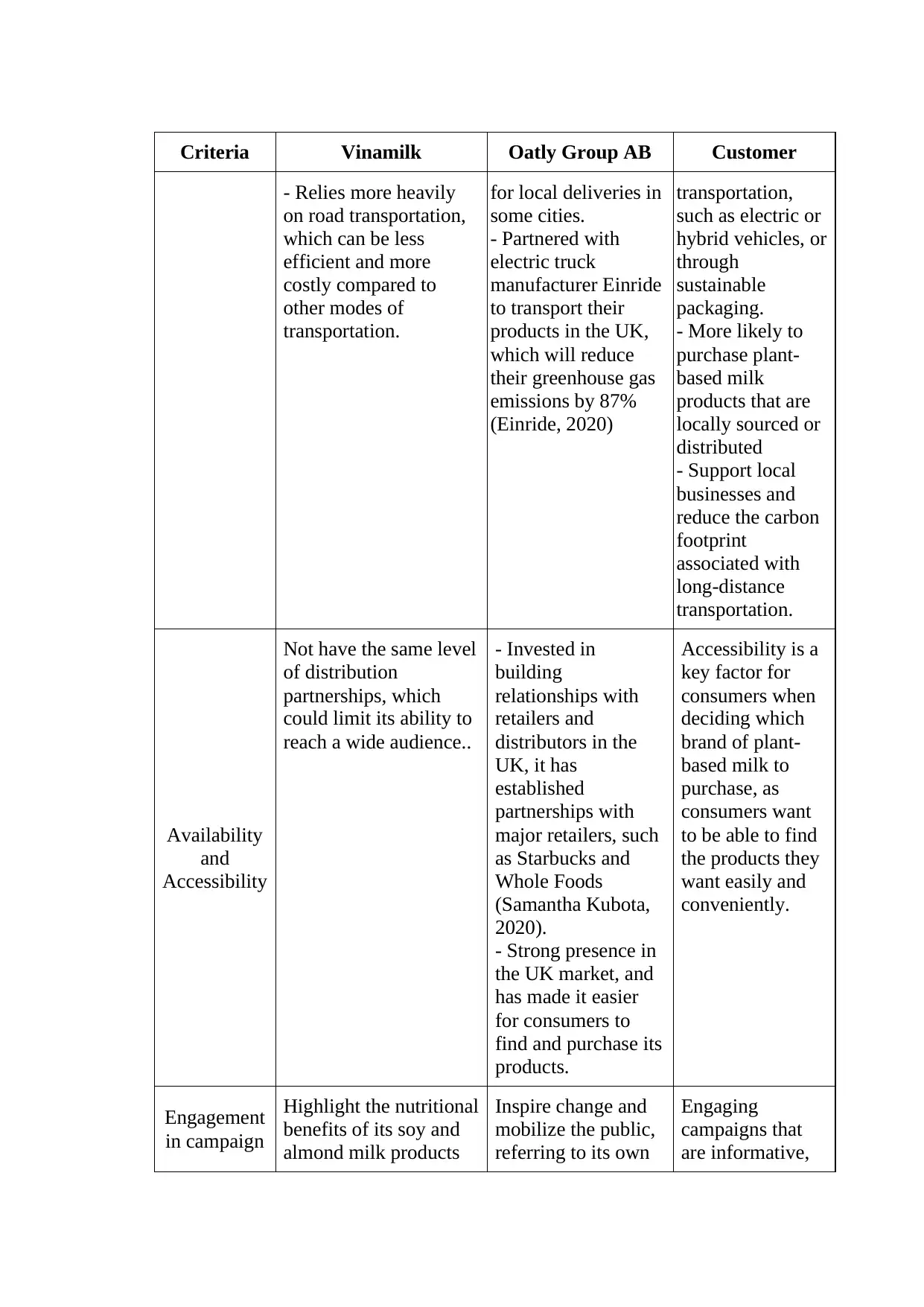
Criteria Vinamilk Oatly Group AB Customer
- Relies more heavily
on road transportation,
which can be less
efficient and more
costly compared to
other modes of
transportation.
for local deliveries in
some cities.
- Partnered with
electric truck
manufacturer Einride
to transport their
products in the UK,
which will reduce
their greenhouse gas
emissions by 87%
(Einride, 2020)
transportation,
such as electric or
hybrid vehicles, or
through
sustainable
packaging.
- More likely to
purchase plant-
based milk
products that are
locally sourced or
distributed
- Support local
businesses and
reduce the carbon
footprint
associated with
long-distance
transportation.
Availability
and
Accessibility
Not have the same level
of distribution
partnerships, which
could limit its ability to
reach a wide audience..
- Invested in
building
relationships with
retailers and
distributors in the
UK, it has
established
partnerships with
major retailers, such
as Starbucks and
Whole Foods
(Samantha Kubota,
2020).
- Strong presence in
the UK market, and
has made it easier
for consumers to
find and purchase its
products.
Accessibility is a
key factor for
consumers when
deciding which
brand of plant-
based milk to
purchase, as
consumers want
to be able to find
the products they
want easily and
conveniently.
Engagement
in campaign
Highlight the nutritional
benefits of its soy and
almond milk products
Inspire change and
mobilize the public,
referring to its own
Engaging
campaigns that
are informative,
- Relies more heavily
on road transportation,
which can be less
efficient and more
costly compared to
other modes of
transportation.
for local deliveries in
some cities.
- Partnered with
electric truck
manufacturer Einride
to transport their
products in the UK,
which will reduce
their greenhouse gas
emissions by 87%
(Einride, 2020)
transportation,
such as electric or
hybrid vehicles, or
through
sustainable
packaging.
- More likely to
purchase plant-
based milk
products that are
locally sourced or
distributed
- Support local
businesses and
reduce the carbon
footprint
associated with
long-distance
transportation.
Availability
and
Accessibility
Not have the same level
of distribution
partnerships, which
could limit its ability to
reach a wide audience..
- Invested in
building
relationships with
retailers and
distributors in the
UK, it has
established
partnerships with
major retailers, such
as Starbucks and
Whole Foods
(Samantha Kubota,
2020).
- Strong presence in
the UK market, and
has made it easier
for consumers to
find and purchase its
products.
Accessibility is a
key factor for
consumers when
deciding which
brand of plant-
based milk to
purchase, as
consumers want
to be able to find
the products they
want easily and
conveniently.
Engagement
in campaign
Highlight the nutritional
benefits of its soy and
almond milk products
Inspire change and
mobilize the public,
referring to its own
Engaging
campaigns that
are informative,

Criteria Vinamilk Oatly Group AB Customer
and educational tips to
maintain a balanced and
healthy lifestyle.
Social activities have
been proceeded such as
Scholarship Fund
“Vinamilk - Nurturing
young talent”
(Vinamilk, n.d)
team as
'unpredictable and
unrelenting oat
punks' spreading the
message of oatsome
living.
entertaining, and
interactive are
more likely to
attract and retain
the attention of
young
consumers.
Multichannel
marketing &
Media
presence
- Extensive coverage
from mass media (TV,
webs) to major media
including Facebook,
Youtube, Instagram, E-
commerce platforms.
- Developed mobile app
called "Vinamilk
Online," which allows
customers to purchase
products, earn rewards,
and receive exclusive
discounts
- Staying true to its
original marketing
focus on low cost
high traffic mediums
like outdoor
billboards, buses and
subway platforms.
- Don’t have any of
their own physical
stores.
- The channels
used for
promotion and
communication
of plant-based
milk can
influence
consumer
behavior toward
health
consciousness
and
sustainability.
- Social media,
advertising, and
influencer
marketing may be
more effective in
reaching younger
consumers.
Attention-
catching
message
V-fresh soy milk product
line - "a source of life
from mother land" of
Vinamilk
The Post Milk
Generation is a
planet-friendly
movement pioneered
by Oatly.
What started as a
marketing move is
now a message
worn proudly by
committed
consumers across
countries.
Creativity in
advertising
Not have the same level
of creativity and
innovation in its
marketing strategy,
Humorous
advertisements and
celebrity
endorsements.
Young consumers
are generally
more receptive to
creative
and educational tips to
maintain a balanced and
healthy lifestyle.
Social activities have
been proceeded such as
Scholarship Fund
“Vinamilk - Nurturing
young talent”
(Vinamilk, n.d)
team as
'unpredictable and
unrelenting oat
punks' spreading the
message of oatsome
living.
entertaining, and
interactive are
more likely to
attract and retain
the attention of
young
consumers.
Multichannel
marketing &
Media
presence
- Extensive coverage
from mass media (TV,
webs) to major media
including Facebook,
Youtube, Instagram, E-
commerce platforms.
- Developed mobile app
called "Vinamilk
Online," which allows
customers to purchase
products, earn rewards,
and receive exclusive
discounts
- Staying true to its
original marketing
focus on low cost
high traffic mediums
like outdoor
billboards, buses and
subway platforms.
- Don’t have any of
their own physical
stores.
- The channels
used for
promotion and
communication
of plant-based
milk can
influence
consumer
behavior toward
health
consciousness
and
sustainability.
- Social media,
advertising, and
influencer
marketing may be
more effective in
reaching younger
consumers.
Attention-
catching
message
V-fresh soy milk product
line - "a source of life
from mother land" of
Vinamilk
The Post Milk
Generation is a
planet-friendly
movement pioneered
by Oatly.
What started as a
marketing move is
now a message
worn proudly by
committed
consumers across
countries.
Creativity in
advertising
Not have the same level
of creativity and
innovation in its
marketing strategy,
Humorous
advertisements and
celebrity
endorsements.
Young consumers
are generally
more receptive to
creative

Criteria Vinamilk Oatly Group AB Customer
which could limit its
ability to stand out in a
crowded market.
marketing
strategies, likely
to respond
positively to
campaigns that
align with their
personal beliefs
and values.
Well-
established
marketing
approach
- Decided to develop
attractive, family-
oriented video content
using 3H strategy –
“Hero, Hub, Help” – a
new approach Hero:
directing consumers
attention by capturing
trendy content.
- Hub: Branding based
on basic content to
increase consumer
interest
Help: Educational
content, help with
related knowledge.
- Developed video
series, funny ads,
making content that
present tips for adults.
- Hey Barista! an
online magazine
from the global
coffee community
promotes consumer
engagement
- Cancellation due to
scandals of
collaboration with
Black Stone ( a
commercial center
known for trading
unsustainable
products)
- Approach to anti-
dairy products
advertising expose it
to lawsuits and
heightened scrutiny
from regulators in
the markets and
interest groups,
dairy lobbyists”.
The level of
awareness about
plant-based milk
among consumers
can influence
their behavior
towards
promotion and
communication
of plant-based
milk.
5.3. Price Tactics
5.3.1. Oatly’s current price
In the UK market, Oatly typically costs more than competing plant-based dairy
products such as Alpro and Tesco's own-brand plant-based milk, according to
existing analysis of a set of customers. A 1-liter carton of Oatly oat milk costs an
average of £1.80, while Alpro's and Tesco's own-brand oat milk costs £1.16 and £0.89
respectively.
which could limit its
ability to stand out in a
crowded market.
marketing
strategies, likely
to respond
positively to
campaigns that
align with their
personal beliefs
and values.
Well-
established
marketing
approach
- Decided to develop
attractive, family-
oriented video content
using 3H strategy –
“Hero, Hub, Help” – a
new approach Hero:
directing consumers
attention by capturing
trendy content.
- Hub: Branding based
on basic content to
increase consumer
interest
Help: Educational
content, help with
related knowledge.
- Developed video
series, funny ads,
making content that
present tips for adults.
- Hey Barista! an
online magazine
from the global
coffee community
promotes consumer
engagement
- Cancellation due to
scandals of
collaboration with
Black Stone ( a
commercial center
known for trading
unsustainable
products)
- Approach to anti-
dairy products
advertising expose it
to lawsuits and
heightened scrutiny
from regulators in
the markets and
interest groups,
dairy lobbyists”.
The level of
awareness about
plant-based milk
among consumers
can influence
their behavior
towards
promotion and
communication
of plant-based
milk.
5.3. Price Tactics
5.3.1. Oatly’s current price
In the UK market, Oatly typically costs more than competing plant-based dairy
products such as Alpro and Tesco's own-brand plant-based milk, according to
existing analysis of a set of customers. A 1-liter carton of Oatly oat milk costs an
average of £1.80, while Alpro's and Tesco's own-brand oat milk costs £1.16 and £0.89
respectively.
Paraphrase This Document
Need a fresh take? Get an instant paraphrase of this document with our AI Paraphraser

5.3.2. Vinamilk’s price opportunity
Vinamilk may have some leeway on the cost to compete with well-known
brands like Oatly. Vinamilk will have to deliver high-quality products that meet
consumer demand in terms of taste, texture, and nutritional cost to succeed in the UK
plant-based milk market. Therefore, to compete with well-known brands like Oatly,
Vinamilk will also require a vast delivery network and a strong brand identity.
5.3.3. Strategy for Vinamilk
First, Vinamilk should think about boarding up their plant-based dairy
products at a cheaper cost than Oatly to appeal to budget-conscious consumers.
Second, Vinamilk could emphasize the positive outcomes of its plant-based
dairy products by giving price-based costs, such as their nutritional cost,
sustainability, or ethical production practices, and charging a cost that reflects those
advantages.
5.4. Distribution Tactics
5.4.1. Oatly’s current distribution
Oatly's sales in the UK increased by 89% in 2020, reaching £106.5m (The
Grocer, 2021). Moreover, Oatly has a strong distribution network in the UK, with its
products widely available in major supermarkets and health food stores across the
country. In 2020, Oatly announced a partnership with Starbucks UK (Samantha
Kubota, 2020).
However, there are some limitations in Oatly’s distribution. First, Oatly has
no physical stores, its products are only accessible to customers through its
partnerships with retailers and food service providers. Second, while Oatly is widely
available in major supermarkets and chains, it may not have the same level of
presence in smaller outlets or independent businesses.
5.4.2. Vinamilk’s distribution opportunity
Vinamilk has the benefit of being a well-established dairy firm with a
significant production capacity and competitive price, which can establish ties with
suppliers and retailers to gain access into the plant-based milk industry and win
distribution partnerships in the UK.
Vinamilk may have some leeway on the cost to compete with well-known
brands like Oatly. Vinamilk will have to deliver high-quality products that meet
consumer demand in terms of taste, texture, and nutritional cost to succeed in the UK
plant-based milk market. Therefore, to compete with well-known brands like Oatly,
Vinamilk will also require a vast delivery network and a strong brand identity.
5.3.3. Strategy for Vinamilk
First, Vinamilk should think about boarding up their plant-based dairy
products at a cheaper cost than Oatly to appeal to budget-conscious consumers.
Second, Vinamilk could emphasize the positive outcomes of its plant-based
dairy products by giving price-based costs, such as their nutritional cost,
sustainability, or ethical production practices, and charging a cost that reflects those
advantages.
5.4. Distribution Tactics
5.4.1. Oatly’s current distribution
Oatly's sales in the UK increased by 89% in 2020, reaching £106.5m (The
Grocer, 2021). Moreover, Oatly has a strong distribution network in the UK, with its
products widely available in major supermarkets and health food stores across the
country. In 2020, Oatly announced a partnership with Starbucks UK (Samantha
Kubota, 2020).
However, there are some limitations in Oatly’s distribution. First, Oatly has
no physical stores, its products are only accessible to customers through its
partnerships with retailers and food service providers. Second, while Oatly is widely
available in major supermarkets and chains, it may not have the same level of
presence in smaller outlets or independent businesses.
5.4.2. Vinamilk’s distribution opportunity
Vinamilk has the benefit of being a well-established dairy firm with a
significant production capacity and competitive price, which can establish ties with
suppliers and retailers to gain access into the plant-based milk industry and win
distribution partnerships in the UK.
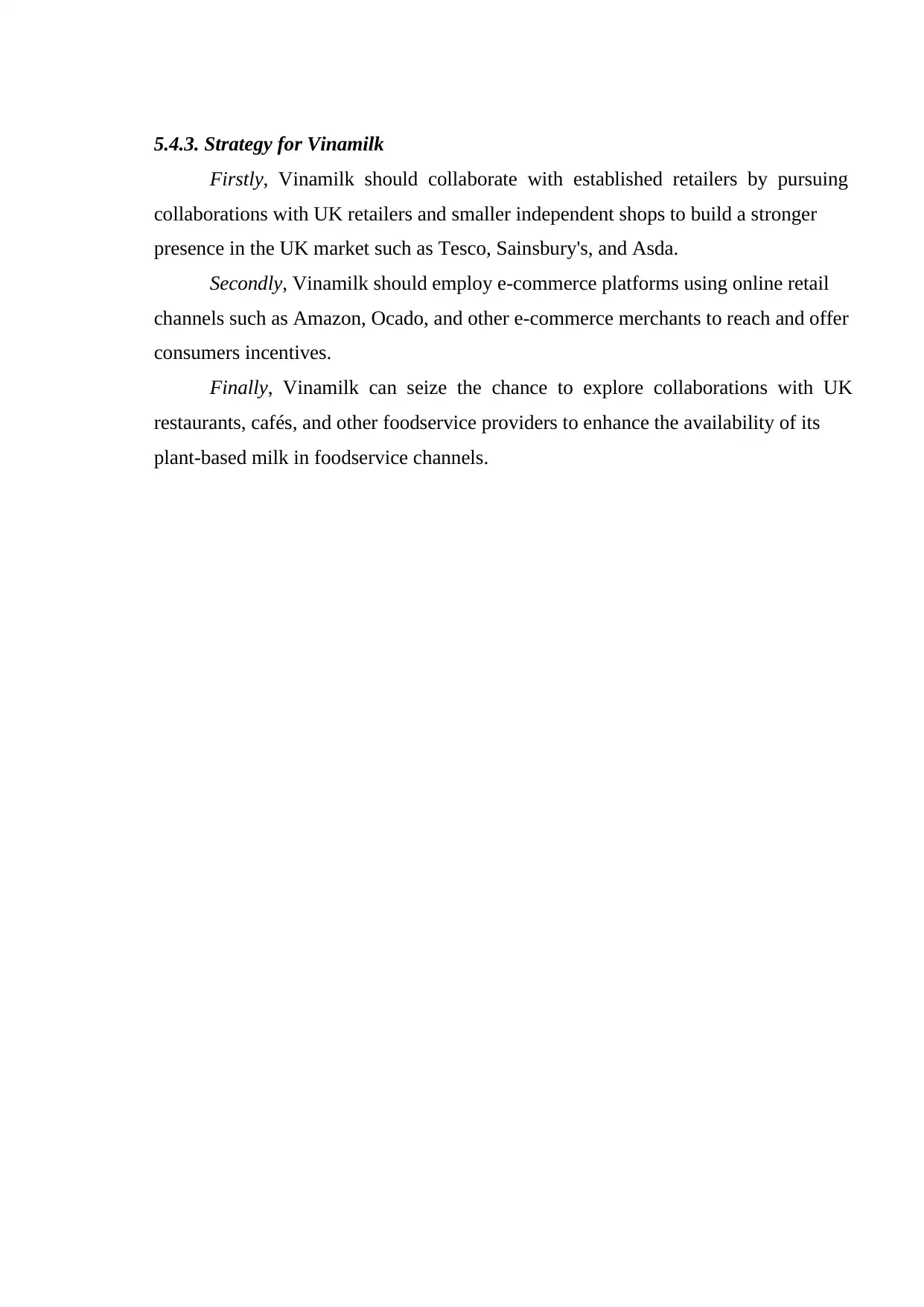
5.4.3. Strategy for Vinamilk
Firstly, Vinamilk should collaborate with established retailers by pursuing
collaborations with UK retailers and smaller independent shops to build a stronger
presence in the UK market such as Tesco, Sainsbury's, and Asda.
Secondly, Vinamilk should employ e-commerce platforms using online retail
channels such as Amazon, Ocado, and other e-commerce merchants to reach and offer
consumers incentives.
Finally, Vinamilk can seize the chance to explore collaborations with UK
restaurants, cafés, and other foodservice providers to enhance the availability of its
plant-based milk in foodservice channels.
Firstly, Vinamilk should collaborate with established retailers by pursuing
collaborations with UK retailers and smaller independent shops to build a stronger
presence in the UK market such as Tesco, Sainsbury's, and Asda.
Secondly, Vinamilk should employ e-commerce platforms using online retail
channels such as Amazon, Ocado, and other e-commerce merchants to reach and offer
consumers incentives.
Finally, Vinamilk can seize the chance to explore collaborations with UK
restaurants, cafés, and other foodservice providers to enhance the availability of its
plant-based milk in foodservice channels.
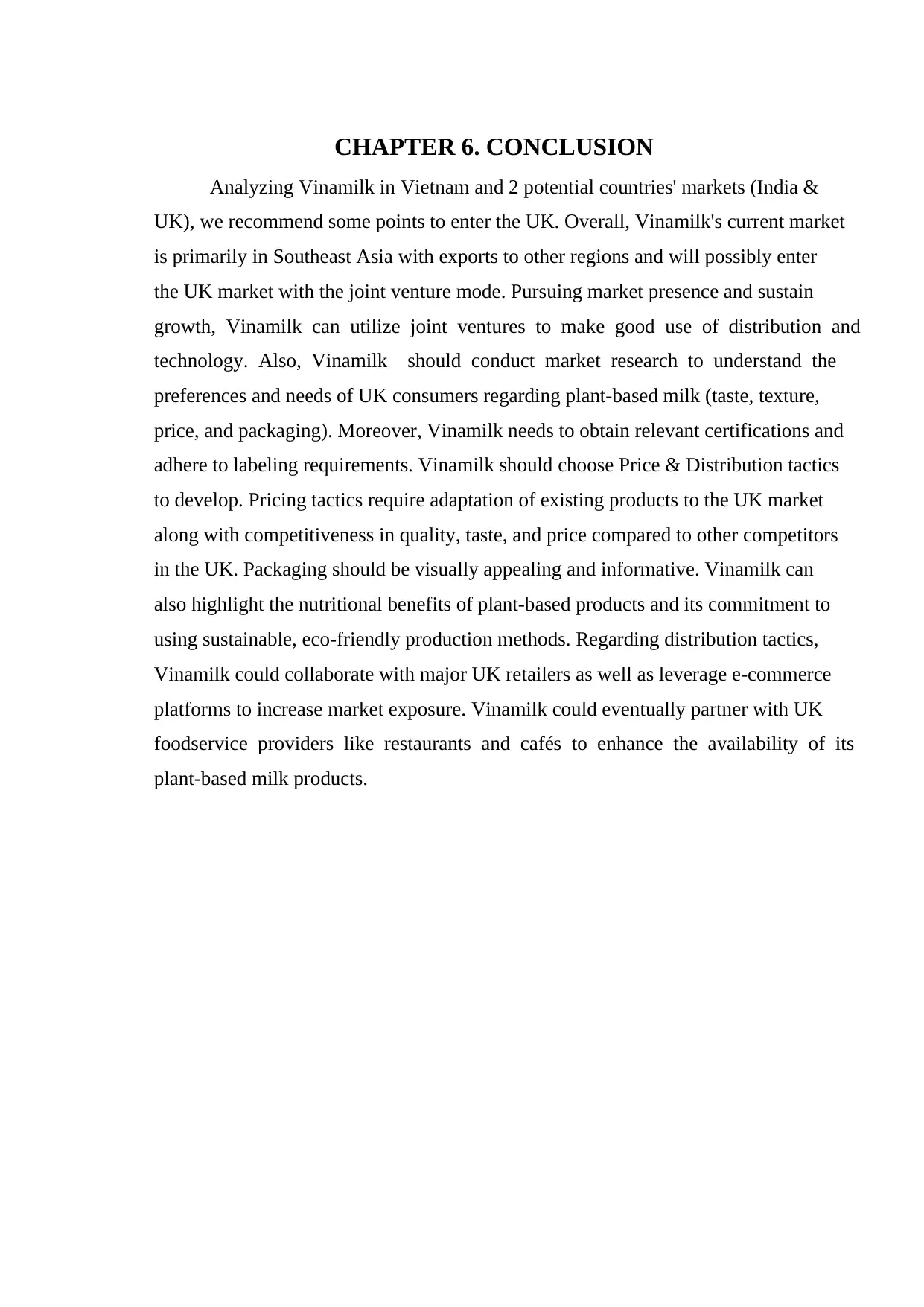
CHAPTER 6. CONCLUSION
Analyzing Vinamilk in Vietnam and 2 potential countries' markets (India &
UK), we recommend some points to enter the UK. Overall, Vinamilk's current market
is primarily in Southeast Asia with exports to other regions and will possibly enter
the UK market with the joint venture mode. Pursuing market presence and sustain
growth, Vinamilk can utilize joint ventures to make good use of distribution and
technology. Also, Vinamilk should conduct market research to understand the
preferences and needs of UK consumers regarding plant-based milk (taste, texture,
price, and packaging). Moreover, Vinamilk needs to obtain relevant certifications and
adhere to labeling requirements. Vinamilk should choose Price & Distribution tactics
to develop. Pricing tactics require adaptation of existing products to the UK market
along with competitiveness in quality, taste, and price compared to other competitors
in the UK. Packaging should be visually appealing and informative. Vinamilk can
also highlight the nutritional benefits of plant-based products and its commitment to
using sustainable, eco-friendly production methods. Regarding distribution tactics,
Vinamilk could collaborate with major UK retailers as well as leverage e-commerce
platforms to increase market exposure. Vinamilk could eventually partner with UK
foodservice providers like restaurants and cafés to enhance the availability of its
plant-based milk products.
Analyzing Vinamilk in Vietnam and 2 potential countries' markets (India &
UK), we recommend some points to enter the UK. Overall, Vinamilk's current market
is primarily in Southeast Asia with exports to other regions and will possibly enter
the UK market with the joint venture mode. Pursuing market presence and sustain
growth, Vinamilk can utilize joint ventures to make good use of distribution and
technology. Also, Vinamilk should conduct market research to understand the
preferences and needs of UK consumers regarding plant-based milk (taste, texture,
price, and packaging). Moreover, Vinamilk needs to obtain relevant certifications and
adhere to labeling requirements. Vinamilk should choose Price & Distribution tactics
to develop. Pricing tactics require adaptation of existing products to the UK market
along with competitiveness in quality, taste, and price compared to other competitors
in the UK. Packaging should be visually appealing and informative. Vinamilk can
also highlight the nutritional benefits of plant-based products and its commitment to
using sustainable, eco-friendly production methods. Regarding distribution tactics,
Vinamilk could collaborate with major UK retailers as well as leverage e-commerce
platforms to increase market exposure. Vinamilk could eventually partner with UK
foodservice providers like restaurants and cafés to enhance the availability of its
plant-based milk products.
Secure Best Marks with AI Grader
Need help grading? Try our AI Grader for instant feedback on your assignments.
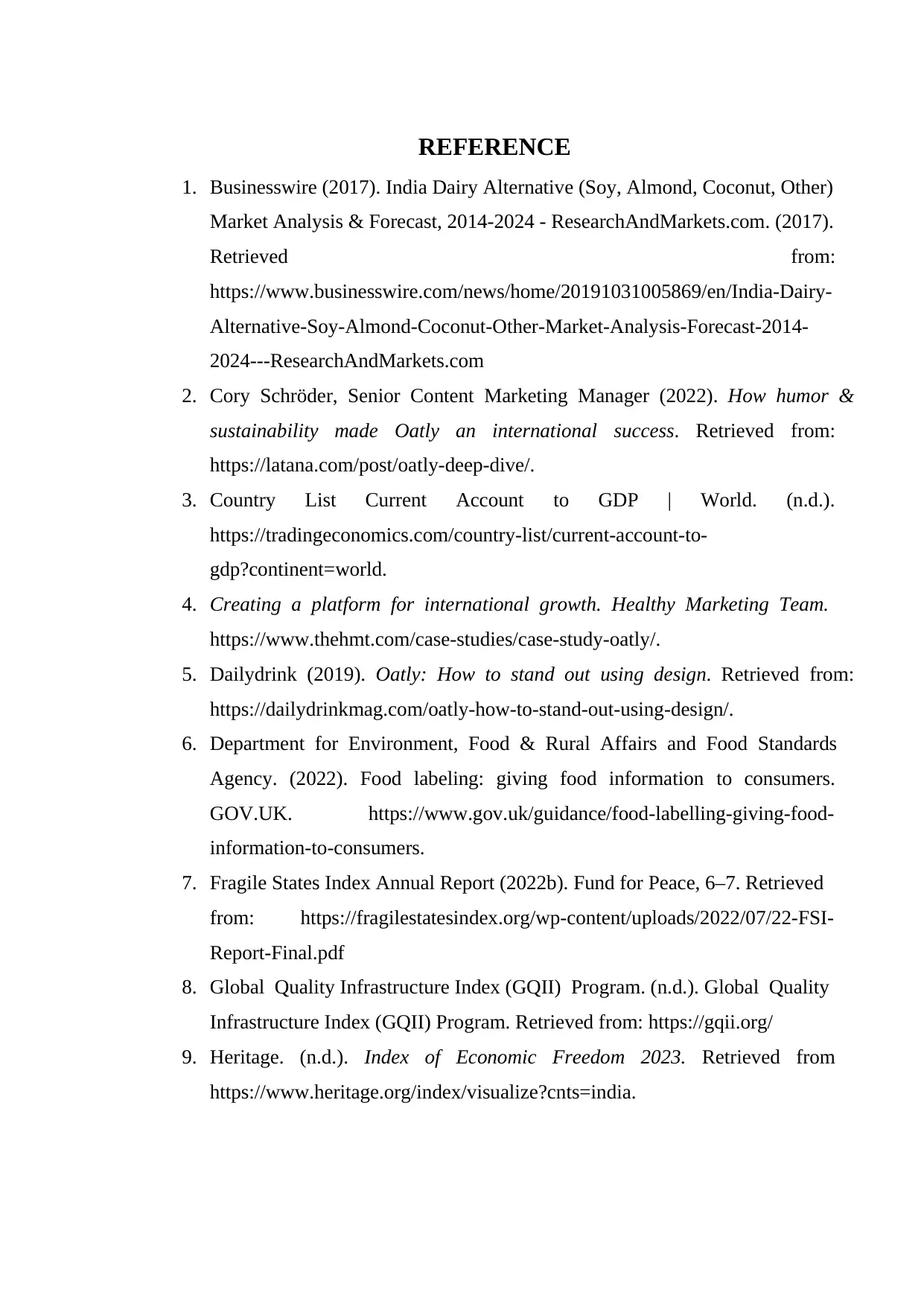
REFERENCE
1. Businesswire (2017). India Dairy Alternative (Soy, Almond, Coconut, Other)
Market Analysis & Forecast, 2014-2024 - ResearchAndMarkets.com. (2017).
Retrieved from:
https://www.businesswire.com/news/home/20191031005869/en/India-Dairy-
Alternative-Soy-Almond-Coconut-Other-Market-Analysis-Forecast-2014-
2024---ResearchAndMarkets.com
2. Cory Schröder, Senior Content Marketing Manager (2022). How humor &
sustainability made Oatly an international success. Retrieved from:
https://latana.com/post/oatly-deep-dive/.
3. Country List Current Account to GDP | World. (n.d.).
https://tradingeconomics.com/country-list/current-account-to-
gdp?continent=world.
4. Creating a platform for international growth. Healthy Marketing Team.
https://www.thehmt.com/case-studies/case-study-oatly/.
5. Dailydrink (2019). Oatly: How to stand out using design. Retrieved from:
https://dailydrinkmag.com/oatly-how-to-stand-out-using-design/.
6. Department for Environment, Food & Rural Affairs and Food Standards
Agency. (2022). Food labeling: giving food information to consumers.
GOV.UK. https://www.gov.uk/guidance/food-labelling-giving-food-
information-to-consumers.
7. Fragile States Index Annual Report (2022b). Fund for Peace, 6–7. Retrieved
from: https://fragilestatesindex.org/wp-content/uploads/2022/07/22-FSI-
Report-Final.pdf
8. Global Quality Infrastructure Index (GQII) Program. (n.d.). Global Quality
Infrastructure Index (GQII) Program. Retrieved from: https://gqii.org/
9. Heritage. (n.d.). Index of Economic Freedom 2023. Retrieved from
https://www.heritage.org/index/visualize?cnts=india.
1. Businesswire (2017). India Dairy Alternative (Soy, Almond, Coconut, Other)
Market Analysis & Forecast, 2014-2024 - ResearchAndMarkets.com. (2017).
Retrieved from:
https://www.businesswire.com/news/home/20191031005869/en/India-Dairy-
Alternative-Soy-Almond-Coconut-Other-Market-Analysis-Forecast-2014-
2024---ResearchAndMarkets.com
2. Cory Schröder, Senior Content Marketing Manager (2022). How humor &
sustainability made Oatly an international success. Retrieved from:
https://latana.com/post/oatly-deep-dive/.
3. Country List Current Account to GDP | World. (n.d.).
https://tradingeconomics.com/country-list/current-account-to-
gdp?continent=world.
4. Creating a platform for international growth. Healthy Marketing Team.
https://www.thehmt.com/case-studies/case-study-oatly/.
5. Dailydrink (2019). Oatly: How to stand out using design. Retrieved from:
https://dailydrinkmag.com/oatly-how-to-stand-out-using-design/.
6. Department for Environment, Food & Rural Affairs and Food Standards
Agency. (2022). Food labeling: giving food information to consumers.
GOV.UK. https://www.gov.uk/guidance/food-labelling-giving-food-
information-to-consumers.
7. Fragile States Index Annual Report (2022b). Fund for Peace, 6–7. Retrieved
from: https://fragilestatesindex.org/wp-content/uploads/2022/07/22-FSI-
Report-Final.pdf
8. Global Quality Infrastructure Index (GQII) Program. (n.d.). Global Quality
Infrastructure Index (GQII) Program. Retrieved from: https://gqii.org/
9. Heritage. (n.d.). Index of Economic Freedom 2023. Retrieved from
https://www.heritage.org/index/visualize?cnts=india.

10. Hughes (2023), The ‘Back To Basics’ Marketing Success of Oatly. Retrieved
from: https://digitalmarketinginstitute.com/blog/the-back-to-basics-
marketing-success-of-oatly.
11. IBISWorld. (n.d). Industry Market Research, Reports, and Statistics.
Retrieved from: https://www.ibisworld.com/uk/bed/liquid-milk-
consumption-per-capita/44115/#:.
12. ILO Department of Statistics. (n.d.). Statistics on Statistics on wages -
ILOSTAT. ILOSTAT. Retrieved from: https://ilostat.ilo.org/topics/wages/.
13. Index of Economic Freedom. (n.d.) Index of Economic Freedom: Promoting
Economic Opportunity and Prosperity by Country. Retrieved from:
https://www.heritage.org/index/.
14. Inflation Rate - Countries - List | World. (n.d.).
https://tradingeconomics.com/country-list/inflation-rate?continent=world
15. International Monetary Fund (n.d.). GDP Growth Rate. Retrieved from:
https://www.imf.org/external/datamapper/NGDP_RPCH@WEO/OEMDC/A
DVEC/WEOWORLD/IND/CHN.
16. IPRI Countries. (n.d.).
https://www.internationalpropertyrightsindex.org/countries
17. Jeff Nobbs. (n.d). Is Oatly Oat Milk Healthy? Retrieved from:
https://www.jeffnobbs.com/posts/is-oatly-
healthy?fbclid=IwAR0kfPWCAtGLiKZ14LgkHM1CCYB6NL-tJPlgX3r-
d9Ro2oNuz3toej9_SaU
18. Jessica Wohl (2019). Oatly's own team boost awareness, just don't call it an
in-house agency. https://adage.com/article/special-report-ana-annual-
meeting/oatlys-own-team-boosts-awareness-just-dont-call-it-house
agency/2205041
19. Labbrand (2018), How Oatly Became the Trendiest Plant Milk on the Market,
Corporate Branding Team,
20. Labor force, total | Data. (n.d.).
https://data.worldbank.org/indicator/SL.TLF.TOTL.IN
from: https://digitalmarketinginstitute.com/blog/the-back-to-basics-
marketing-success-of-oatly.
11. IBISWorld. (n.d). Industry Market Research, Reports, and Statistics.
Retrieved from: https://www.ibisworld.com/uk/bed/liquid-milk-
consumption-per-capita/44115/#:.
12. ILO Department of Statistics. (n.d.). Statistics on Statistics on wages -
ILOSTAT. ILOSTAT. Retrieved from: https://ilostat.ilo.org/topics/wages/.
13. Index of Economic Freedom. (n.d.) Index of Economic Freedom: Promoting
Economic Opportunity and Prosperity by Country. Retrieved from:
https://www.heritage.org/index/.
14. Inflation Rate - Countries - List | World. (n.d.).
https://tradingeconomics.com/country-list/inflation-rate?continent=world
15. International Monetary Fund (n.d.). GDP Growth Rate. Retrieved from:
https://www.imf.org/external/datamapper/NGDP_RPCH@WEO/OEMDC/A
DVEC/WEOWORLD/IND/CHN.
16. IPRI Countries. (n.d.).
https://www.internationalpropertyrightsindex.org/countries
17. Jeff Nobbs. (n.d). Is Oatly Oat Milk Healthy? Retrieved from:
https://www.jeffnobbs.com/posts/is-oatly-
healthy?fbclid=IwAR0kfPWCAtGLiKZ14LgkHM1CCYB6NL-tJPlgX3r-
d9Ro2oNuz3toej9_SaU
18. Jessica Wohl (2019). Oatly's own team boost awareness, just don't call it an
in-house agency. https://adage.com/article/special-report-ana-annual-
meeting/oatlys-own-team-boosts-awareness-just-dont-call-it-house
agency/2205041
19. Labbrand (2018), How Oatly Became the Trendiest Plant Milk on the Market,
Corporate Branding Team,
20. Labor force, total | Data. (n.d.).
https://data.worldbank.org/indicator/SL.TLF.TOTL.IN
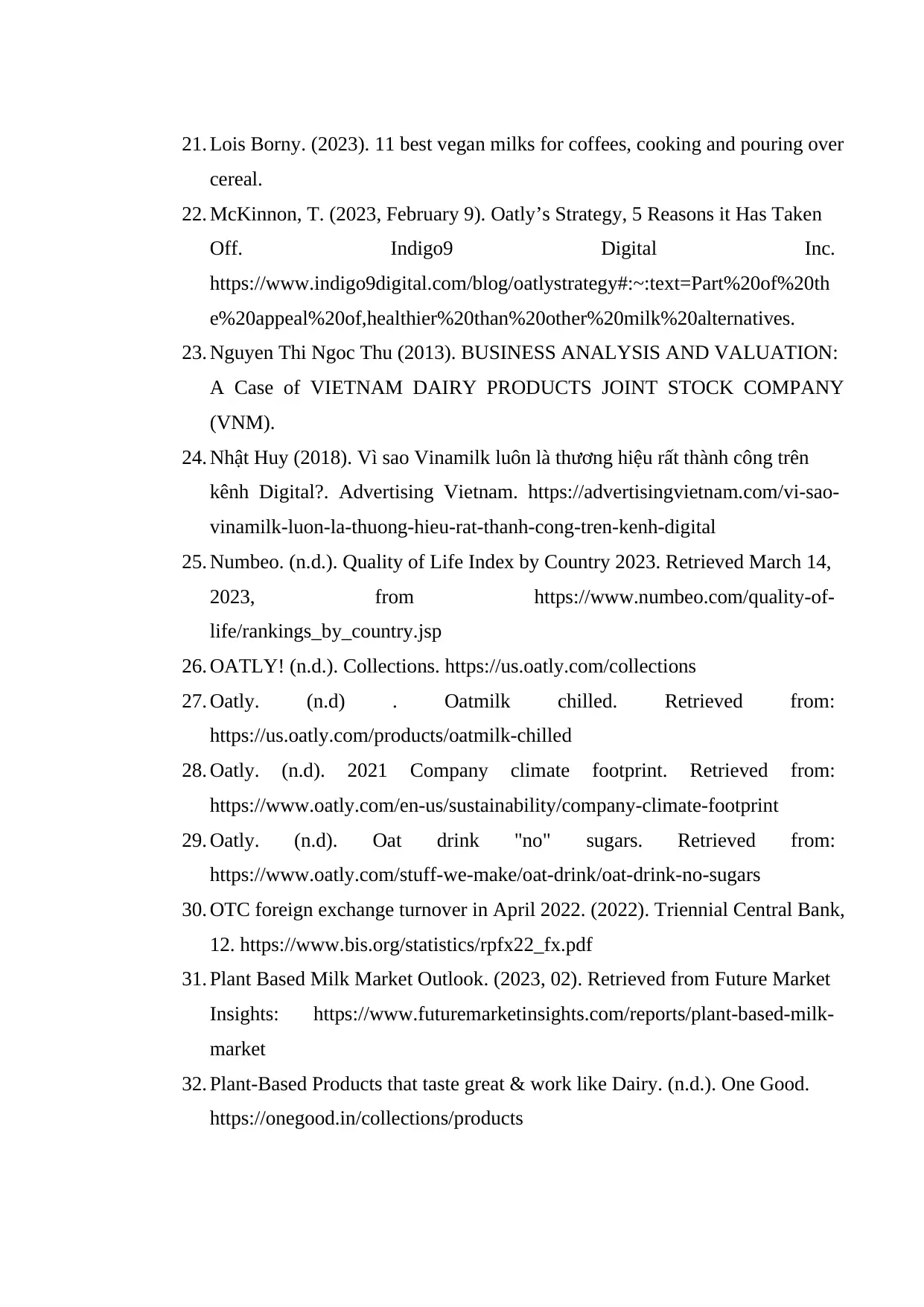
21. Lois Borny. (2023). 11 best vegan milks for coffees, cooking and pouring over
cereal.
22. McKinnon, T. (2023, February 9). Oatly’s Strategy, 5 Reasons it Has Taken
Off. Indigo9 Digital Inc.
https://www.indigo9digital.com/blog/oatlystrategy#:~:text=Part%20of%20th
e%20appeal%20of,healthier%20than%20other%20milk%20alternatives.
23. Nguyen Thi Ngoc Thu (2013). BUSINESS ANALYSIS AND VALUATION:
A Case of VIETNAM DAIRY PRODUCTS JOINT STOCK COMPANY
(VNM).
24. Nhật Huy (2018). Vì sao Vinamilk luôn là thương hiệu rất thành công trên
kênh Digital?. Advertising Vietnam. https://advertisingvietnam.com/vi-sao-
vinamilk-luon-la-thuong-hieu-rat-thanh-cong-tren-kenh-digital
25. Numbeo. (n.d.). Quality of Life Index by Country 2023. Retrieved March 14,
2023, from https://www.numbeo.com/quality-of-
life/rankings_by_country.jsp
26. OATLY! (n.d.). Collections. https://us.oatly.com/collections
27. Oatly. (n.d) . Oatmilk chilled. Retrieved from:
https://us.oatly.com/products/oatmilk-chilled
28. Oatly. (n.d). 2021 Company climate footprint. Retrieved from:
https://www.oatly.com/en-us/sustainability/company-climate-footprint
29. Oatly. (n.d). Oat drink "no" sugars. Retrieved from:
https://www.oatly.com/stuff-we-make/oat-drink/oat-drink-no-sugars
30. OTC foreign exchange turnover in April 2022. (2022). Triennial Central Bank,
12. https://www.bis.org/statistics/rpfx22_fx.pdf
31. Plant Based Milk Market Outlook. (2023, 02). Retrieved from Future Market
Insights: https://www.futuremarketinsights.com/reports/plant-based-milk-
market
32. Plant-Based Products that taste great & work like Dairy. (n.d.). One Good.
https://onegood.in/collections/products
cereal.
22. McKinnon, T. (2023, February 9). Oatly’s Strategy, 5 Reasons it Has Taken
Off. Indigo9 Digital Inc.
https://www.indigo9digital.com/blog/oatlystrategy#:~:text=Part%20of%20th
e%20appeal%20of,healthier%20than%20other%20milk%20alternatives.
23. Nguyen Thi Ngoc Thu (2013). BUSINESS ANALYSIS AND VALUATION:
A Case of VIETNAM DAIRY PRODUCTS JOINT STOCK COMPANY
(VNM).
24. Nhật Huy (2018). Vì sao Vinamilk luôn là thương hiệu rất thành công trên
kênh Digital?. Advertising Vietnam. https://advertisingvietnam.com/vi-sao-
vinamilk-luon-la-thuong-hieu-rat-thanh-cong-tren-kenh-digital
25. Numbeo. (n.d.). Quality of Life Index by Country 2023. Retrieved March 14,
2023, from https://www.numbeo.com/quality-of-
life/rankings_by_country.jsp
26. OATLY! (n.d.). Collections. https://us.oatly.com/collections
27. Oatly. (n.d) . Oatmilk chilled. Retrieved from:
https://us.oatly.com/products/oatmilk-chilled
28. Oatly. (n.d). 2021 Company climate footprint. Retrieved from:
https://www.oatly.com/en-us/sustainability/company-climate-footprint
29. Oatly. (n.d). Oat drink "no" sugars. Retrieved from:
https://www.oatly.com/stuff-we-make/oat-drink/oat-drink-no-sugars
30. OTC foreign exchange turnover in April 2022. (2022). Triennial Central Bank,
12. https://www.bis.org/statistics/rpfx22_fx.pdf
31. Plant Based Milk Market Outlook. (2023, 02). Retrieved from Future Market
Insights: https://www.futuremarketinsights.com/reports/plant-based-milk-
market
32. Plant-Based Products that taste great & work like Dairy. (n.d.). One Good.
https://onegood.in/collections/products
Paraphrase This Document
Need a fresh take? Get an instant paraphrase of this document with our AI Paraphraser

33. Quality of Life Index by Country 2023. (n.d.). Quality of Life Index by
Country 2023. https://www.numbeo.com/quality-of-
life/rankings_by_country.jsp
34. Rankings. (n.d.). World Bank. Retrieved from:
https://archive.doingbusiness.org/en/rankings
35. Rogers, K., 2022. Future Consumer Index: Five consumer types you need to
understand. Available at: https://www.ey.com/en_vn/consumer-products-
retail/five-types-of-consumer-that-you-need-to-understand
36. Sales of oat milk overtake almond. (n.d.). Mintel. Retrieved from:
https://www.mintel.com/press-centre/the-cream-of-the-vegan-milk-crop-
sales-of-oat-milk-overtake-almond-in-the-
uk/#:~:text=A%20record%20one%20in%20three,%25%20of%20those%20a
ged%2065%2B.
37. Santander Trade. (2023). Santander Trade Markets. Retrieved from
https://santandertrade.com/
38. Spanier (2021). Oatly IPO reveals ‘crucial’ role of in-house creative team and
risk of losing talent. Hay Market. Retrieved from:
https://www.campaignlive.co.uk/article/oatly-ipo-reveals-crucial-role-in-
house-creative-team-risk-losing-talent/1713918.
39. Statista. (2022, June 9). Internet penetration rate in India 2007-2021. Retrieved
from: https://www.statista.com/statistics/792074/india-internet-penetration-
rate/
40. Statista. (2023, January 25). Consumer spending in India Q2 2018-Q4 2022.
Retrieved from: https://www.statista.com/statistics/233108/india-consumer-
spending/
41. Store Locator. (n.d.). One Good. Retrieved from:
https://onegood.in/pages/store-locator
42. The 2021/2022 Human Development Report. (2022). United Nations
Development Programme, 281–284. Retrieved from:
Country 2023. https://www.numbeo.com/quality-of-
life/rankings_by_country.jsp
34. Rankings. (n.d.). World Bank. Retrieved from:
https://archive.doingbusiness.org/en/rankings
35. Rogers, K., 2022. Future Consumer Index: Five consumer types you need to
understand. Available at: https://www.ey.com/en_vn/consumer-products-
retail/five-types-of-consumer-that-you-need-to-understand
36. Sales of oat milk overtake almond. (n.d.). Mintel. Retrieved from:
https://www.mintel.com/press-centre/the-cream-of-the-vegan-milk-crop-
sales-of-oat-milk-overtake-almond-in-the-
uk/#:~:text=A%20record%20one%20in%20three,%25%20of%20those%20a
ged%2065%2B.
37. Santander Trade. (2023). Santander Trade Markets. Retrieved from
https://santandertrade.com/
38. Spanier (2021). Oatly IPO reveals ‘crucial’ role of in-house creative team and
risk of losing talent. Hay Market. Retrieved from:
https://www.campaignlive.co.uk/article/oatly-ipo-reveals-crucial-role-in-
house-creative-team-risk-losing-talent/1713918.
39. Statista. (2022, June 9). Internet penetration rate in India 2007-2021. Retrieved
from: https://www.statista.com/statistics/792074/india-internet-penetration-
rate/
40. Statista. (2023, January 25). Consumer spending in India Q2 2018-Q4 2022.
Retrieved from: https://www.statista.com/statistics/233108/india-consumer-
spending/
41. Store Locator. (n.d.). One Good. Retrieved from:
https://onegood.in/pages/store-locator
42. The 2021/2022 Human Development Report. (2022). United Nations
Development Programme, 281–284. Retrieved from:
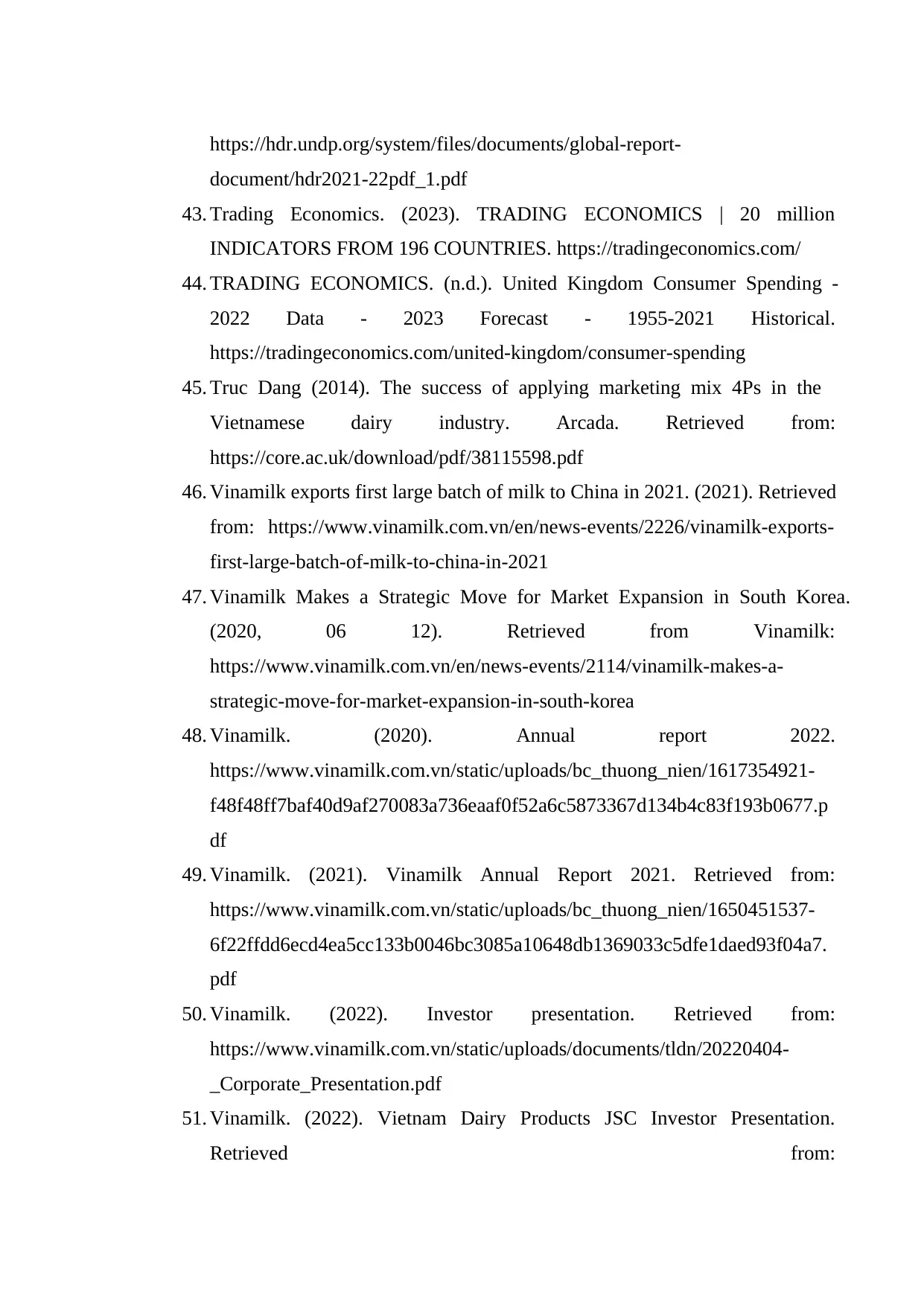
https://hdr.undp.org/system/files/documents/global-report-
document/hdr2021-22pdf_1.pdf
43. Trading Economics. (2023). TRADING ECONOMICS | 20 million
INDICATORS FROM 196 COUNTRIES. https://tradingeconomics.com/
44. TRADING ECONOMICS. (n.d.). United Kingdom Consumer Spending -
2022 Data - 2023 Forecast - 1955-2021 Historical.
https://tradingeconomics.com/united-kingdom/consumer-spending
45. Truc Dang (2014). The success of applying marketing mix 4Ps in the
Vietnamese dairy industry. Arcada. Retrieved from:
https://core.ac.uk/download/pdf/38115598.pdf
46. Vinamilk exports first large batch of milk to China in 2021. (2021). Retrieved
from: https://www.vinamilk.com.vn/en/news-events/2226/vinamilk-exports-
first-large-batch-of-milk-to-china-in-2021
47. Vinamilk Makes a Strategic Move for Market Expansion in South Korea.
(2020, 06 12). Retrieved from Vinamilk:
https://www.vinamilk.com.vn/en/news-events/2114/vinamilk-makes-a-
strategic-move-for-market-expansion-in-south-korea
48. Vinamilk. (2020). Annual report 2022.
https://www.vinamilk.com.vn/static/uploads/bc_thuong_nien/1617354921-
f48f48ff7baf40d9af270083a736eaaf0f52a6c5873367d134b4c83f193b0677.p
df
49. Vinamilk. (2021). Vinamilk Annual Report 2021. Retrieved from:
https://www.vinamilk.com.vn/static/uploads/bc_thuong_nien/1650451537-
6f22ffdd6ecd4ea5cc133b0046bc3085a10648db1369033c5dfe1daed93f04a7.
pdf
50. Vinamilk. (2022). Investor presentation. Retrieved from:
https://www.vinamilk.com.vn/static/uploads/documents/tldn/20220404-
_Corporate_Presentation.pdf
51. Vinamilk. (2022). Vietnam Dairy Products JSC Investor Presentation.
Retrieved from:
document/hdr2021-22pdf_1.pdf
43. Trading Economics. (2023). TRADING ECONOMICS | 20 million
INDICATORS FROM 196 COUNTRIES. https://tradingeconomics.com/
44. TRADING ECONOMICS. (n.d.). United Kingdom Consumer Spending -
2022 Data - 2023 Forecast - 1955-2021 Historical.
https://tradingeconomics.com/united-kingdom/consumer-spending
45. Truc Dang (2014). The success of applying marketing mix 4Ps in the
Vietnamese dairy industry. Arcada. Retrieved from:
https://core.ac.uk/download/pdf/38115598.pdf
46. Vinamilk exports first large batch of milk to China in 2021. (2021). Retrieved
from: https://www.vinamilk.com.vn/en/news-events/2226/vinamilk-exports-
first-large-batch-of-milk-to-china-in-2021
47. Vinamilk Makes a Strategic Move for Market Expansion in South Korea.
(2020, 06 12). Retrieved from Vinamilk:
https://www.vinamilk.com.vn/en/news-events/2114/vinamilk-makes-a-
strategic-move-for-market-expansion-in-south-korea
48. Vinamilk. (2020). Annual report 2022.
https://www.vinamilk.com.vn/static/uploads/bc_thuong_nien/1617354921-
f48f48ff7baf40d9af270083a736eaaf0f52a6c5873367d134b4c83f193b0677.p
df
49. Vinamilk. (2021). Vinamilk Annual Report 2021. Retrieved from:
https://www.vinamilk.com.vn/static/uploads/bc_thuong_nien/1650451537-
6f22ffdd6ecd4ea5cc133b0046bc3085a10648db1369033c5dfe1daed93f04a7.
50. Vinamilk. (2022). Investor presentation. Retrieved from:
https://www.vinamilk.com.vn/static/uploads/documents/tldn/20220404-
_Corporate_Presentation.pdf
51. Vinamilk. (2022). Vietnam Dairy Products JSC Investor Presentation.
Retrieved from:
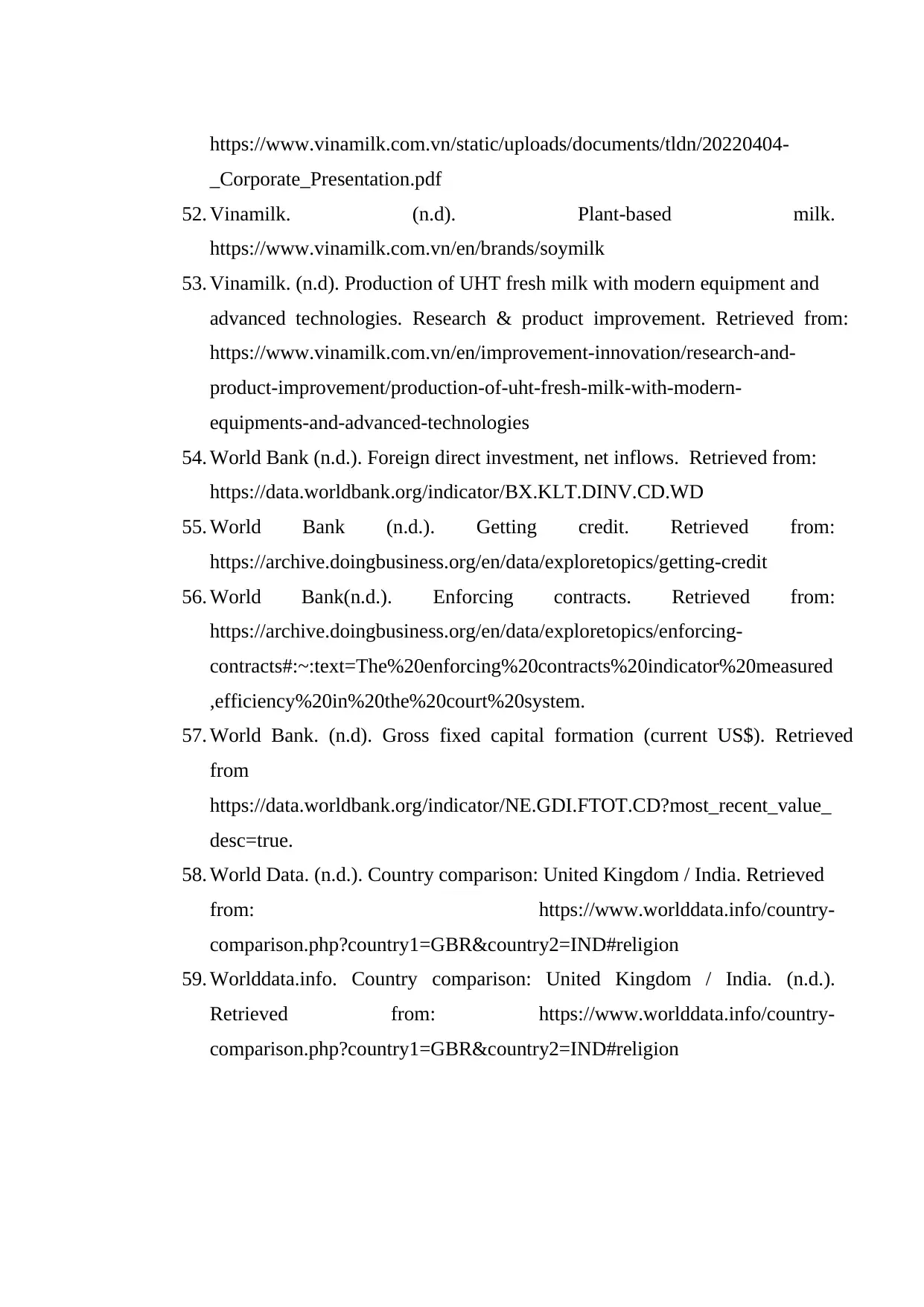
https://www.vinamilk.com.vn/static/uploads/documents/tldn/20220404-
_Corporate_Presentation.pdf
52. Vinamilk. (n.d). Plant-based milk.
https://www.vinamilk.com.vn/en/brands/soymilk
53. Vinamilk. (n.d). Production of UHT fresh milk with modern equipment and
advanced technologies. Research & product improvement. Retrieved from:
https://www.vinamilk.com.vn/en/improvement-innovation/research-and-
product-improvement/production-of-uht-fresh-milk-with-modern-
equipments-and-advanced-technologies
54. World Bank (n.d.). Foreign direct investment, net inflows. Retrieved from:
https://data.worldbank.org/indicator/BX.KLT.DINV.CD.WD
55. World Bank (n.d.). Getting credit. Retrieved from:
https://archive.doingbusiness.org/en/data/exploretopics/getting-credit
56. World Bank(n.d.). Enforcing contracts. Retrieved from:
https://archive.doingbusiness.org/en/data/exploretopics/enforcing-
contracts#:~:text=The%20enforcing%20contracts%20indicator%20measured
,efficiency%20in%20the%20court%20system.
57. World Bank. (n.d). Gross fixed capital formation (current US$). Retrieved
from
https://data.worldbank.org/indicator/NE.GDI.FTOT.CD?most_recent_value_
desc=true.
58. World Data. (n.d.). Country comparison: United Kingdom / India. Retrieved
from: https://www.worlddata.info/country-
comparison.php?country1=GBR&country2=IND#religion
59. Worlddata.info. Country comparison: United Kingdom / India. (n.d.).
Retrieved from: https://www.worlddata.info/country-
comparison.php?country1=GBR&country2=IND#religion
_Corporate_Presentation.pdf
52. Vinamilk. (n.d). Plant-based milk.
https://www.vinamilk.com.vn/en/brands/soymilk
53. Vinamilk. (n.d). Production of UHT fresh milk with modern equipment and
advanced technologies. Research & product improvement. Retrieved from:
https://www.vinamilk.com.vn/en/improvement-innovation/research-and-
product-improvement/production-of-uht-fresh-milk-with-modern-
equipments-and-advanced-technologies
54. World Bank (n.d.). Foreign direct investment, net inflows. Retrieved from:
https://data.worldbank.org/indicator/BX.KLT.DINV.CD.WD
55. World Bank (n.d.). Getting credit. Retrieved from:
https://archive.doingbusiness.org/en/data/exploretopics/getting-credit
56. World Bank(n.d.). Enforcing contracts. Retrieved from:
https://archive.doingbusiness.org/en/data/exploretopics/enforcing-
contracts#:~:text=The%20enforcing%20contracts%20indicator%20measured
,efficiency%20in%20the%20court%20system.
57. World Bank. (n.d). Gross fixed capital formation (current US$). Retrieved
from
https://data.worldbank.org/indicator/NE.GDI.FTOT.CD?most_recent_value_
desc=true.
58. World Data. (n.d.). Country comparison: United Kingdom / India. Retrieved
from: https://www.worlddata.info/country-
comparison.php?country1=GBR&country2=IND#religion
59. Worlddata.info. Country comparison: United Kingdom / India. (n.d.).
Retrieved from: https://www.worlddata.info/country-
comparison.php?country1=GBR&country2=IND#religion
1 out of 46
Your All-in-One AI-Powered Toolkit for Academic Success.
+13062052269
info@desklib.com
Available 24*7 on WhatsApp / Email
![[object Object]](/_next/static/media/star-bottom.7253800d.svg)
Unlock your academic potential
© 2024 | Zucol Services PVT LTD | All rights reserved.